Street lighting equipment was originally part of the general lighting division (F)
until 1932. Then it was separated into its own street lighting division (Z). Therefore
early lantern have F catalogue prefixes whilst later ones have Z catalogue prefixes and
those that straddle the change will have two different catalogue numbers.
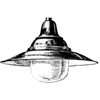
|
f 2210: first town
Although simple in construction, has been scientifically designed to give the best results.
Vitreous enamelled iron, black outside, white inside. Fitted with clear flint glass.
|
|
F 2210
|
60-100W GLS
|
BC
|
Top Entry
|
No Gear
|
1914 Catalogue
|
|
|
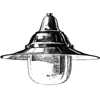
|
f 2212: second town
Although simple in construction, has been scientifically designed to give the best results.
Vitreous enamelled iron, black outside, white inside. Fitted with clear flint glass.
|
|
F 2212
|
100-200W GLS
|
BC
|
Top Entry
|
No Gear
|
1914 Catalogue
|
|
|
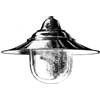
|
f 2214: third town
Although simple in construction, has been scientifically designed to give the best results.
Vitreous enamelled iron, black outside, white inside. Fitted with clear flint glass.
|
|
F 2214
|
300-600W GLS
|
BC
|
Top Entry
|
No Gear
|
1914 Catalogue
|
|
|
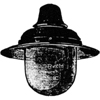
|
f 2220/21: first arcade
Although simple in construction, has been scientifically designed to give the best results.
Vitreous enamelled iron, green outside, white inside. Could be fitted with either clear flint glass
(F 2220) or diagonal opal and clear glass (F 2221).
|
|
F 2220
|
60-100W GLS
|
BC
|
Top Entry
|
No Gear
|
1914 Catalogue
|
|
F 2221
|
60-100W GLS
|
BC
|
Top Entry
|
No Gear
|
1914 Catalogue
|
|
|
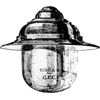
|
f 2222/23: second arcade
Although simple in construction, has been scientifically designed to give the best results.
Vitreous enamelled iron, green outside, white inside. Could be fitted with either clear flint glass
(F 2222) or diagonal opal and clear glass (F 2223).
|
|
F 2222
|
200W GLS
|
BC
|
Top Entry
|
No Gear
|
1914 Catalogue
|
|
F 2223
|
200W GLS
|
BC
|
Top Entry
|
No Gear
|
1914 Catalogue
|
|
|
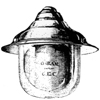
|
f 2224/25: third arcade
Although simple in construction, has been scientifically designed to give the best results.
Vitreous enamelled iron, green outside, white inside. Could be fitted with either clear flint glass
(F 2224) or diagonal opal and clear glass (F 2225).
|
|
F 2224
|
300W-400W GLS
|
BC
|
Top Entry
|
No Gear
|
1914 Catalogue
|
|
F 2225
|
300W-400 GLS
|
BC
|
Top Entry
|
No Gear
|
1914 Catalogue
|
|
|
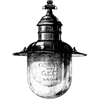
|
f 2226/27: fourth arcade
Although simple in construction, has been scientifically designed to give the best results.
Vitreous enamelled iron, green outside, white inside. Could be fitted with either clear flint glass
(F 2226) or diagonal opal and clear glass (F 2227).
|
|
F 2226
|
600W-1000W GLS
|
BC
|
Top Entry
|
No Gear
|
1914 Catalogue
|
|
F 2227
|
600W-1000 GLS
|
BC
|
Top Entry
|
No Gear
|
1914 Catalogue
|
|
|
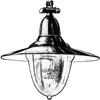
|
f 2230: gilder
Vitreous enamelled iron, black outside, white inside. Fitted with clear flint glass.
|
|
F 2230
|
20W-100W GLS
|
BC
|
Top Entry
|
No Gear
|
1914 Catalogue
|
|
|
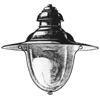
|
f 2232: first city
Vitreous enamelled iron, black outside, white inside. Fitted with clear flint glass.
|
|
F 2232
|
100W-200W GLS
|
BC
|
Top Entry
|
No Gear
|
1914 Catalogue
|
|
|
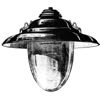
|
f 2234: second city
Vitreous enamelled iron, black outside, white inside. Fitted with clear flint glass.
|
|
F 2234
|
300W-1000W GLS
|
BC
|
Top Entry
|
No Gear
|
1914 Catalogue
|
|
|
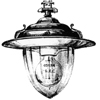
|
f 2240: first parade
Vitreous enamelled iron, black outside, white inside. Fitted with clear flint glass.
|
|
F 2240
|
60-100W GLS
|
BC
|
Top Entry
|
No Gear
|
1914 Catalogue
|
|
|
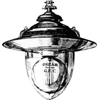
|
f 2242: second parade
Vitreous enamelled iron, black outside, white inside. Fitted with clear flint glass.
|
|
F 2242
|
200-400W GLS
|
BC
|
Top Entry
|
No Gear
|
1914 Catalogue
|
|
|
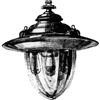
|
f 2244: third parade
Vitreous enamelled iron, black outside, white inside. Fitted with clear flint glass.
|
|
F 2244
|
4x60W GLS
|
BC
|
Top Entry
|
No Gear
|
1914 Catalogue
|
|
|
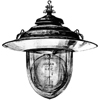
|
f 2246: fourth parade
Vitreous enamelled iron, black outside, white inside. Fitted with clear flint glass.
|
|
F 2246
|
600W-1000W GLS
|
BC
|
Top Entry
|
No Gear
|
1914 Catalogue
|
|
|
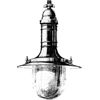
|
f 2250: clothier
Vitreous enamelled iron, black outside, white inside, with reflector. Fitted with clear flint well glass.
|
|
F 2250
|
100W-1000W GLS
|
BC
|
Top Entry
|
No Gear
|
1914 Catalogue
|
|
|
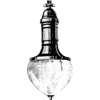
|
f 2252: vinter
Vitreous enamelled iron, black outside, white inside, without extension reflector.
Fitted with clear flint or pearl opal glass.
|
|
F 2252
|
100W-1000W GLS
|
BC
|
Top Entry
|
No Gear
|
1914 Catalogue
|
|
|
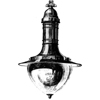
|
f 2254: saddler
Vitreous enamelled iron, black outside, white inside, with extension reflector. Clear flint or pearl opal glass.
|
|
F 2254
|
100W-1000W GLS
|
BC
|
Top Entry
|
No Gear
|
1914 catalogue
|
|
|
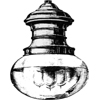
|
f 2260/61/62/63/64/65: first avenue
Has a 12" diameter. Available in various finishes including zinc, copper, polished copper, oxidised copper or oxidised silver,
with black or white japanning with gold lines. Takes either a cluster of smaller wattage lamps or one large lamp.
|
|
F 2260
|
4x20W-60W
100W-200W GLS
|
BC
|
Top Entry
|
No Gear
|
1914 Catalogue
|
|
F 2261
|
4x20W-60W
100W-200W GLS
|
BC
|
Top Entry
|
No Gear
|
1914 Catalogue
|
|
F 2262
|
4x20W-60W
100W-200W GLS
|
BC
|
Top Entry
|
No Gear
|
1914 Catalogue
|
|
F 2263
|
4x20W-60W
100W-200W GLS
|
BC
|
Top Entry
|
No Gear
|
1914 Catalogue
|
|
F 2264
|
4x20W-60W
100W-200W GLS
|
BC
|
Top Entry
|
No Gear
|
1914 Catalogue
|
|
F 2265
|
4x20W-60W
100W-200W GLS
|
BC
|
Top Entry
|
No Gear
|
1914 Catalogue
|
|
|
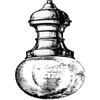
|
f 2268/69/70/71: second avenue
Has a 10" diameter. Available in various finishes including zinc, copper, polished copper, oxidised copper or oxidised silver,
with black or white japanning with gold lines. Takes either a cluster of smaller wattage lamps or one large lamp.
|
|
F 2268
|
100W GLS
|
BC
|
Top Entry
|
No Gear
|
1914 Catalogue
|
|
F 2269
|
100W GLS
|
BC
|
Top Entry
|
No Gear
|
1914 Catalogue
|
|
F 2270
|
100W GLS
|
BC
|
Top Entry
|
No Gear
|
1914 Catalogue
|
|
F 2271
|
100W GLS
|
BC
|
Top Entry
|
No Gear
|
1914 Catalogue
|
|
F 2272
|
100W GLS
|
BC
|
Top Entry
|
No Gear
|
1914 Catalogue
|
|
F 2273
|
100W GLS
|
BC
|
Top Entry
|
No Gear
|
1914 Catalogue
|
|
|
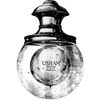
|
f 2276/78: fourth avenue
Available in various finishes including zinc and polished copper,
with black or white japanning with gold lines. Fitted with either a clear, part opal globe or opaloid globe. Wire net available
at extra price.
|
|
F 2276
|
600W-1000W GLS
|
BC
|
Top Entry
|
No Gear
|
1914 Catalogue
|
|
F 2277
|
600W-1000W GLS
|
BC
|
Top Entry
|
No Gear
|
1914 Catalogue
|
|
F 2278
|
600W-1000W GLS
|
BC
|
Top Entry
|
No Gear
|
1914 Catalogue
|
|
|
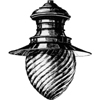
|
f 2278/79: fifth avenue
Has a 13" diameter globe. Only available in zinc with black or white japanned gold lines. Takes a clear flint twisted globe.
Takes either a cluster of smaller wattage lamps or one large lamp.
|
|
F 2278
|
4x20W-60W
100W-200W GLS
|
BC
|
Top Entry
|
No Gear
|
1914 Catalogue
|
|
F 2279
|
4x20W-60W
100W-200W GLS
|
BC
|
Top Entry
|
No Gear
|
1914 Catalogue
|
|
|
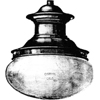
|
f 2280/82: broadway
Available with either zinc (black japanned) or polished copper bodies. Fitted with a white enamelled reflector, and takes an
opaloid, clear flint globe, or part opal globe. Takes either a cluster of smaller wattage lamps or one large lamp.
|
|
F 2280
|
4x100W GLS
300W GLS
400W GLS
|
BC
|
Top Entry
|
No Gear
|
1914 Catalogue
|
|
F 2282
|
4x100W GLS
300W GLS
400W GLS
|
BC
|
Top Entry
|
No Gear
|
1914 Catalogue
|
|
|
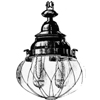
|
f 2284: first heaton
Has copper body which is japanned black. Fitted with an insulated shackle. Globe supported by wire net and chains. Available
with either an opalod or clear glass globe. Takes either a cluster of smaller wattage lamps or one large lamp.
|
|
F 2284
|
3x60W GLS
100W GLS
|
BC
|
Top Entry
|
No Gear
|
1914 Catalogue
|
|
|
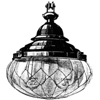
|
f 2286: second heaton
Has copper body which is japanned black. Fitted with an insulated shackle. Globe supported by wire net and chains. Available
with either an opalod or clear glass globe.
|
|
F 2286
|
3x100W GLS
|
BC
|
Top Entry
|
No Gear
|
1914 Catalogue
|
|
|
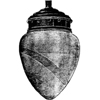
|
f 2290: walham
Has an enamelled iron gallery. Fitted with a diagonal opan and clear glass globe, 12" x 15". Takes 1 to 4 lamps.
|
|
F 2290
|
1 to 4 100W GLS
|
BC
|
Top Entry
|
No Gear
|
1914 Catalogue
|
|
|
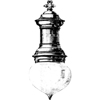
|
f 2292/93/94/95: international
Available in two sizes called the First International and the Second International. The smaller First International
accepts either a 100W or 200W lamp, and is available either in zinc (green Japanned with gold lines) or copper. The
larger Second International takes a 300W or 400W lamp, and is available in zinc or copper. Both can be fitted with
either a clear or opaloid globe.
|
|
F 2292
|
100-200W GLS
|
BC
|
Top Entry
|
No Gear
|
1914 Catalogue
|
|
F 2293
|
100-200W GLS
|
BC
|
Top Entry
|
No Gear
|
1914 Catalogue
|
|
F 2294
|
300-400W GLS
|
BC
|
Top Entry
|
No Gear
|
1914 Catalogue
|
|
F 2295
|
300-400W GLS
|
BC
|
Top Entry
|
No Gear
|
1914 Catalogue
|
|
|
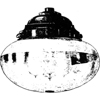
|
f 2300/01/02/03: village
Available in either zinc (with black Japanned gold lines) or polished copper. Can take either one 100W or 200W lamp
or a cluster of three to four 20W to 60W lamps. Can be fitted with either an opaline, clear flint or part opal/part clear
glass globe.
|
|
F 2300
|
100-200W GLS
|
BC
|
Top Entry
|
No Gear
|
1914 Catalogue
|
|
F 2301
|
3 or 4 20-60W GLS
|
BC
|
Top Entry
|
No Gear
|
1914 Catalogue
|
|
F 2302
|
100-200W GLS
|
BC
|
Top Entry
|
No Gear
|
1914 Catalogue
|
|
F 2303
|
3 or 4 20-60W GLS
|
BC
|
Top Entry
|
No Gear
|
1914 Catalogue
|
|
|
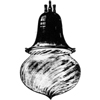
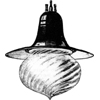
|
f 2310/11/14/15: highfield
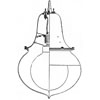 British Patent: 27,991/08
British Patent: 27,991/08
The lamps are fully protected from vibration and are fully dust proof. The fitting is supplied
with outside plug terminals, and is sent out complete with holders and wiring. Two basic
styles are produced: one with a large reflector and one without. All models are made from
copper and are japanned green. The smaller version takes a 100-200W lamp, and the larger version
takes a 300-1000W lamp. Available with either a opaloid or twisted clear flint glass bowl.
|
|
F 2310
|
100-200W GLS
|
BC
|
Top Entry
|
No Gear
|
1914 Catalogue
|
|
F 2311
|
300-1000W GLS
|
BC
|
Top Entry
|
No Gear
|
1914 Catalogue
|
|
F 2314
|
100-200W GLS
|
BC
|
Top Entry
|
No Gear
|
1914 Catalogue
|
|
F 2315
|
300-1000W GLS
|
BC
|
Top Entry
|
No Gear
|
1914 Catalogue
|
|
|
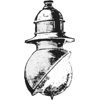
|
f 2320/21/22/24: pavement
Made in four sizes with different sized diameter reflectors. Each model takes a different range of lamp wattages. Made from
copper, finished Japanned green. White inside.
|
|
F 2320
|
100W GLS
|
BC
|
Top Entry
|
No Gear
|
1914 Catalogue
|
|
F 2321
|
200W GLS
|
BC
|
Top Entry
|
No Gear
|
1914 Catalogue
|
|
F 2322
|
300W-400W GLS
|
BC
|
Top Entry
|
No Gear
|
1914 Catalogue
|
|
F 2324
|
600W-1000W GLS
|
BC
|
Top Entry
|
No Gear
|
1914 Catalogue
|
|
|
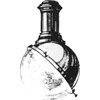
|
f 2326: first orbit
Made from vitreous enamelled iron. Finished black outside, white inside. Fitted with a clear flint glass front.
|
|
F 2326
|
100W GLS
|
BC
|
Top Entry
|
No Gear
|
1914 Catalogue
|
|
|
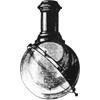
|
f 2327: second orbit
Made from vitreous enamelled iron. Finished black outside, white inside. Fitted with a clear flint glass front.
|
|
F 2327
|
200W GLS
|
BC
|
Top Entry
|
No Gear
|
1914 Catalogue
|
|
|
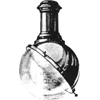
|
f 2328: third orbit
Made from vitreous enamelled iron. Finished black outside, white inside. Fitted with a clear flint glass front.
|
|
F 2328
|
200W GLS
|
BC
|
Top Entry
|
No Gear
|
1914 Catalogue
|
|
|
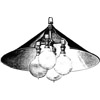
|
f 2330: milne
Constructed from a 24 in. vitreous enamelled iron shade. Finished blue outside, white inside, with polished brass ball body,
arms and loop.
|
|
F 2330
|
4x100W GLS
|
BC
|
Top Entry
|
No Gear
|
1914 Catalogue
|
|
|
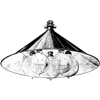
|
f 2332: commonwealth
Constructed from a 24 in. vitreous enamelled iron shade. Finished blue outside, white inside, with an inner white enamelled reflector.
Fitted with an insulated shackle.
|
|
F 2332
|
5x100W GLS
|
BC
|
Top Entry
|
No Gear
|
1914 Catalogue
|
|
|
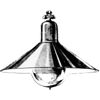
|
f 2334: bridge
Constructed from a 24 in. vitreous enamelled iron shade. Finished blue outside, with an inner white enamelled reflector.
|
|
F 2334
|
600-1000W GLS
|
BC
|
Top Entry
|
No Gear
|
1914 Catalogue
|
|
|
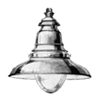
|
fa 8101: yorkist
Distributing type fitting. Vitreous enamelled steel body and reflector, finished green outside and white inside. Complete
with insulated suspension shackle and opalescent globe.
|
|
FA8101
|
150-500W GLS
|
BC
|
Top Entry
|
No Gear
|
1920 catalogue
1923 catalogue
|
|
|
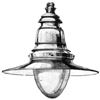
|
fa 8102: lancastrian
Extra distributing type fitting. Vitreous enamelled steel body and reflector, finished green outside and white inside. Complete
with insulated suspension shackle and opalescent globe.
|
|
FA8102
|
150-500W GLS
|
BC
|
Top Entry
|
No Gear
|
1920 catalogue
1923 catalogue
|
|
|
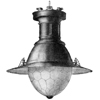
|
fa 8160/61: city
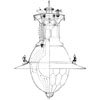
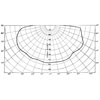 Designed for use with GLS lamps of all sizes. Body made from steel and cast iron which is finished
vitreous enamel green outside and white for the reflecting surface. (Spun steel reflector is used for
general use whilst cast iron reflector is used for extremely exposed positions). The reflectors are designed to give
a very wide dispersion of light. Special attention is given to the ventilation of the lantern and a novel
sytem has been introduced which allows a current of air to be drawn continuously
over the lamp. The lantern also has simple yet substantial focusing device, which uses a rachet to hold the
lamp. Can be fitted with clear flint or opalescent glass globes which are wired to minimise the risk of
accident through breakage while suspended. Safety chains are also provided so that globes can be lowered for
cleaning. Both the series-running City lantern and Metropolitan lantern (see FA8168 and FA8169/70 below) are based on
design features of this lantern.
Designed for use with GLS lamps of all sizes. Body made from steel and cast iron which is finished
vitreous enamel green outside and white for the reflecting surface. (Spun steel reflector is used for
general use whilst cast iron reflector is used for extremely exposed positions). The reflectors are designed to give
a very wide dispersion of light. Special attention is given to the ventilation of the lantern and a novel
sytem has been introduced which allows a current of air to be drawn continuously
over the lamp. The lantern also has simple yet substantial focusing device, which uses a rachet to hold the
lamp. Can be fitted with clear flint or opalescent glass globes which are wired to minimise the risk of
accident through breakage while suspended. Safety chains are also provided so that globes can be lowered for
cleaning. Both the series-running City lantern and Metropolitan lantern (see FA8168 and FA8169/70 below) are based on
design features of this lantern.
|
|
FA8160
|
150-1500W GLS
|
BC
|
Top Entry
|
No Gear
|
1920 catalogue
1923 catalogue
|
|
FA8161
|
150-1500W GLS
|
BC
|
Top Entry
|
No Gear
|
1920 catalogue
1923 catalogue
|
|
|
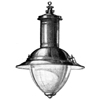
|
|
fa 8166, f 8202/08, f 5111/15 : birmingham
Later sold as the Z 5337/8
Vitreous enamelled steel body, finished green outside and white inside. Complete with insulated suspension shackle and
clear flint glass globe. Available in three sizes with or without reflector.
|
|
FA8166
|
100-20W GLS
|
BC
|
Top Entry
|
No Gear
|
1920 catalogue
1923 catalogue
|
|
F8202
|
100-1500W GLS
|
BC
|
Top Entry
|
No Gear
|
1920 catalogue
1923 catalogue
|
|
F8208
|
100-1500W GLS
|
BC
|
Top Entry
|
No Gear
|
1920 catalogue
1923 catalogue
|
|
F5111 (renumbered)
|
60-200W GLS
|
BC
|
Top Entry
|
No Gear
|
1920s catalogue
|
|
F5115 (renumbered)
|
60-500W GLS
|
BC
|
Top Entry
|
No Gear
|
1920s catalogue
|
|
|
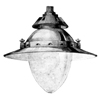
|
|
fa 8167: suburban
Later sold as the Z 5331
Body is made from high grade cast iron with a spun steel reflector.
Finished green outside with white vitreous enamel for reflecting surfaces.
Special provision is made for the ventilation. Supplied complete with clear flint glass.
|
|
FA8167
|
100W GLS
|
BC
|
Top Entry
|
No Gear
|
1920 catalogue
1923 catalogue
1930 catalogue
|
|
|
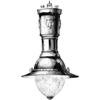
|
fa 8168: city
A version of the City lantern (see FA8160 above) intended for series running. Therefore fitted with substitutional
resistance and automatic cut out. The GEC point out that the series running of lanterns is not generally
recommended.
|
|
FA8168
|
300-1500W GLS
|
BC
|
Top Entry
|
No Gear
|
1920 catalogue
1923 catalogue
|
|
|
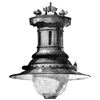
|
fa 8169/70: metropolitan
Refractor: Holophane series
Based on the City lantern (see FA8160 above) with the same ventilation and focussing arrangements. Designed for use
with a Holophane refractor.
|
|
FA8169
|
150-300W GLS
|
BC
|
Top Entry
|
No Gear
|
1920 catalogue
1923 catalogue
|
|
FA8170
|
500-1500W GLS
|
BC
|
Top Entry
|
No Gear
|
1920 catalogue
1923 catalogue
|
|
|
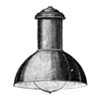
|
f 8216: ordnance
Distributive type fitting for spacing ratio 1½: 1. Vitreous enamelled ventilated steel-reflector 12"
diameter. Finished green outside, white inside.
|
|
F8216
|
300-500W GLS
|
BC
|
Top Entry
|
No Gear
|
1920 catalogue
1923 catalogue
|
|
|
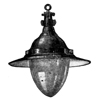
|
|
f 8260, f 5101: footway
Later sold as the Z 5333/4.
Has a vitreous enamelled steel body and reflector, finished green outside and white inside. Supplied complete with
insulated suspension shackle and clear flint glass or opalescent globe.
|
|
F8260
|
100W GLS
|
BC
|
Top Entry
|
No Gear
|
1920 catalogue
1923 catalogue
|
|
F5101 (renumbered)
|
60W GLS
|
BC
|
Top Entry
|
No Gear
|
1920s catalogue
|
|
|
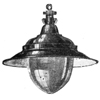
|
|
f 8266, f 5103: terrace
Later sold as the Z 5335 and Z 5336.
Has a vitreous enamelled steel body and reflector, finished green outside and white inside. Supplied complete with
insulated suspension shackle and clear flint glass or opalescent globe.
|
|
F8266
|
150-200W GLS
|
BC
|
Top Entry
|
No Gear
|
1920 catalogue
1923 catalogue
|
|
F5103 (renumbered)
|
100W GLS
|
BC
|
Top Entry
|
No Gear
|
1920s catalogue
|
|
|
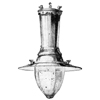
|
|
|
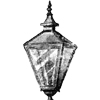
|
|
|
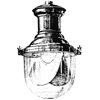
|
fb 509: longitudinal lighting lantern "globe" type
British Patents: 152050, 10048 (Held by Haydn T. Harrision)
One of the "Directive System Of Street Lighting Lanterns." Hitherto Street Lighting Lanterns have been designed to
distribute the light downwards so that each unit illuminated a circular area. In the Directive System, nearly all
the luminous energy of the light source is used for illuminating the long narrow area represented by a street, with
the results: (1) The minimum illumination is 10 to 20 times that obtained with the existing types of street fittings,
depending on the width of the street; (2) The small but efficient light source of high intrinsic brilliancy presented
by the modern incandescent electric lamp becomes a large and pleasingly illuminated area; (3) The cost, both for
electrical energy and for maintenance, including lamp renewals, is reduced; (4) For a small outlay, existing installations
can be brought up-to-date, to provide the standard of street lighting which is now necessary to prevent accidents under
modern traffic conditions. The light distribution of these lanterns comprised two distinct parts. The lower hemispherical
flux of the lamp is not modified but is allowed to fulfil its normal function of illuminating the street or road
adjacent to the lamp. The upper hemispherical distribution, which is generally used to very small advantage, is, in
this system, collected by a specially designed reflector, and is directed upon two plane mirrors arranged radially
from the light source at such angles as will produce powerful illumination up and down the street. These mirrors are
so adjusted that they begin to illuminate the street at the points where the direct light fails to bring the illumination
up to the required standard. Adjustments of the angles of the plane mirrors can be made to allow for different distances
between lamps and to suit various widths of street.
|
|
FB509
|
200-300W GLS
|
BC
|
Top Entry
|
No Gear
|
1923 catalogue
|
|
|
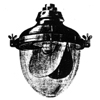
|
fb 600: longitudinal lighting lantern "pendant" type
British Patents: 152050, 10048 (Held by Haydn T. Harrision)
One of the "Directive System Of Street Lighting Lanterns." Hitherto Street Lighting Lanterns have been designed to
distribute the light downwards so that each unit illuminated a circular area. In the Directive System, nearly all
the luminous energy of the light source is used for illuminating the long narrow area represented by a street, with
the results: (1) The minimum illumination is 10 to 20 times that obtained with the existing types of street fittings,
depending on the width of the street; (2) The small but efficient light source of high intrinsic brilliancy presented
by the modern incandescent electric lamp becomes a large and pleasingly illuminated area; (3) The cost, both for
electrical energy and for maintenance, including lamp renewals, is reduced; (4) For a small outlay, existing installations
can be brought up-to-date, to provide the standard of street lighting which is now necessary to prevent accidents under
modern traffic conditions. The light distribution of these lanterns comprised two distinct parts. The lower hemispherical
flux of the lamp is not modified but is allowed to fulfil its normal function of illuminating the street or road
adjacent to the lamp. The upper hemispherical distribution, which is generally used to very small advantage, is, in
this system, collected by a specially designed reflector, and is directed upon two plane mirrors arranged radially
from the light source at such angles as will produce powerful illumination up and down the street. These mirrors are
so adjusted that they begin to illuminate the street at the points where the direct light fails to bring the illumination
up to the required standard. Adjustments of the angles of the plane mirrors can be made to allow for different distances
between lamps and to suit various widths of street.
|
|
FB600
|
40-100W GLS
|
BC
|
Top Entry
|
No Gear
|
1923 catalogue
|
|
|
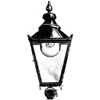
|
fb 632: longitudinal lighting lantern "adapter" pattern
British Patents: 152050, 10048 (Held by Haydn T. Harrision)
One of the "Directive System Of Street Lighting Lanterns." Hitherto Street Lighting Lanterns have been designed to
distribute the light downwards so that each unit illuminated a circular area. In the Directive System, nearly all
the luminous energy of the light source is used for illuminating the long narrow area represented by a street, with
the results: (1) The minimum illumination is 10 to 20 times that obtained with the existing types of street fittings,
depending on the width of the street; (2) The small but efficient light source of high intrinsic brilliancy presented
by the modern incandescent electric lamp becomes a large and pleasingly illuminated area; (3) The cost, both for
electrical energy and for maintenance, including lamp renewals, is reduced; (4) For a small outlay, existing installations
can be brought up-to-date, to provide the standard of street lighting which is now necessary to prevent accidents under
modern traffic conditions. The light distribution of these lanterns comprised two distinct parts. The lower hemispherical
flux of the lamp is not modified but is allowed to fulfil its normal function of illuminating the street or road
adjacent to the lamp. The upper hemispherical distribution, which is generally used to very small advantage, is, in
this system, collected by a specially designed reflector, and is directed upon two plane mirrors arranged radially
from the light source at such angles as will produce powerful illumination up and down the street. These mirrors are
so adjusted that they begin to illuminate the street at the points where the direct light fails to bring the illumination
up to the required standard. Adjustments of the angles of the plane mirrors can be made to allow for different distances
between lamps and to suit various widths of street.
|
|
FB632
|
40-100W GLS
|
BC
|
Post Top
|
No Gear
|
1923 catalogue
|
|
|
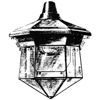
|
fb 633: longitudinal lighting lantern "canterbury" type
British Patents: 152050, 10048 (Held by Haydn T. Harrision)
One of the "Directive System Of Street Lighting Lanterns." Hitherto Street Lighting Lanterns have been designed to
distribute the light downwards so that each unit illuminated a circular area. In the Directive System, nearly all
the luminous energy of the light source is used for illuminating the long narrow area represented by a street, with
the results: (1) The minimum illumination is 10 to 20 times that obtained with the existing types of street fittings,
depending on the width of the street; (2) The small but efficient light source of high intrinsic brilliancy presented
by the modern incandescent electric lamp becomes a large and pleasingly illuminated area; (3) The cost, both for
electrical energy and for maintenance, including lamp renewals, is reduced; (4) For a small outlay, existing installations
can be brought up-to-date, to provide the standard of street lighting which is now necessary to prevent accidents under
modern traffic conditions. The light distribution of these lanterns comprised two distinct parts. The lower hemispherical
flux of the lamp is not modified but is allowed to fulfil its normal function of illuminating the street or road
adjacent to the lamp. The upper hemispherical distribution, which is generally used to very small advantage, is, in
this system, collected by a specially designed reflector, and is directed upon two plane mirrors arranged radially
from the light source at such angles as will produce powerful illumination up and down the street. These mirrors are
so adjusted that they begin to illuminate the street at the points where the direct light fails to bring the illumination
up to the required standard. Adjustments of the angles of the plane mirrors can be made to allow for different distances
between lamps and to suit various widths of street.
|
|
FB633
|
200-300W GLS
|
BC
|
Top Entry
|
No Gear
|
1923 catalogue
|
|
|
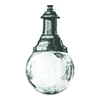
|
|
f ???: Guildhall Lantern
|
|
F????
|
??? GLS
|
BC
|
Top Entry
|
No Gear
|
1930 catalogue
|
|
|
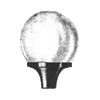
|
|
|
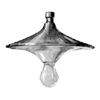
|
|
f 5090/91/92/93/94/95/96: conical reflector
Later sold as the Z 5301/7 range.
This series represents a very complete range of conical reflector fittings, varying from 12" to 17½" in diameter and
arranged for Osram lamps from 40 watts to 200 watts. Supplied in cast iron or mild steel with vitreous enamel or white porcelain reflecting surfaces. Standard tapping, ¾-in
gas.
|
|
F5090
|
40-150W GLS
|
n/a
|
Top Entry
|
No Gear
|
1933 catalogue
|
|
F5091
|
40-150W GLS
|
n/a
|
Top Entry
|
No Gear
|
1933 catalogue
|
|
F5092
|
40-150W GLS
|
n/a
|
Top Entry
|
No Gear
|
1933 catalogue
|
|
F5093
|
40-150W GLS
|
n/a
|
Top Entry
|
No Gear
|
1933 catalogue
|
|
F5094
|
40-150W GLS
|
n/a
|
Top Entry
|
No Gear
|
1933 catalogue
|
|
F5095
|
60-150W GLS
|
n/a
|
Top Entry
|
No Gear
|
1933 catalogue
|
|
F5096
|
100-200W GLS
|
n/a
|
Top Entry
|
No Gear
|
1933 catalogue
|
|
|
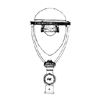
|
|
f 5150/52: parade lantern
Later sold as the Z 5171/2/3 5181/2/3 Parade.
|
|
F5150
|
100-200W GLS
|
BC
|
Post Top
|
No Gear
|
1933 catalogue
|
|
F5152
|
300-500W GLS
|
GES
|
Post Top
|
No Gear
|
1933 catalogue
|
|
|
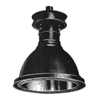
|
|
f 5155: dock lighting lantern
Later sold as the Z 5411 P.L.A.
Specially designed for dock lighting. The lamp is completely screened, and
special attention has been paid to the securing and the strength and robustness which are so essential in lanterns
used for such purposes. The top is fitted with a patented ventilated device operating on the ejector principle
similar to that which has proved so successful on our well-known "WEMBLEY" Lanterns. The body is constructed of heavy
gauge copper, finished stove enamelled green outside, and includes a Single Piece "Gecoray" Silvered Glass Reflector of
special contour. The reflector is so designed to give an angle of cut-off of 65° for the prevention of glare. The mounting
height recommended is from 30 to 35 feet, with a spacing of 110 feet apart.
|
|
F5155
|
500W GLS
|
GES
|
Top Entry
|
No Gear
|
1930 catalogue
1933 catalogue
|
|
|
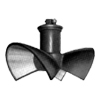
|
|
f 5156/57/58/59/60/61: directional reflector
Later sold as the Z 5201/16 range.
Is of the open reflector form. Can be supplied in various types providing an asymmetric distribution of light
in two, three or four directions at angles to suit varying road widths, junctions, intersections and mounting
arrangements. Silvered mirrored glass reflectors normally used but white opal glass can be substituted if desired.
(Opal glass has an extremely long life when employed in corrosive or humid atmospheres but the intensity
of the peak candle power is not so high as for mirror reflectors).
The silvered mirror reflectors are of a single piece of glass bent ot the correct contour and cemented into
the cast iron backings. Diffusing glass is used to prevent glare as the whole of the surface appears
equally illuminated. The distribution is wider than htat provided by other similar types of unit
and the intensity of the peak candle power is higher, due to the greater control of light effected by
the larger surface area of the reflectors. The cast iron backings are easily detachable from the top
and body of the fitting for: (1) Nesting for packing and stocking; (2) Facilitating wiring and erection;
(3) For replacements and (4) Interchangeability. For use with clear OSRAM lamps. Standard taping
¾" gas. Focussing screw accessible and rapid. Stout durable copper body (top cylinder). Standard
finish is green.
|
|
F 5156
|
60-200W GLS
|
BC / ES
|
Top Entry
|
No Gear
|
1933 catalogue
1933 catalogue
|
|
F 5157
|
60-200W GLS
|
BC / ES
|
Top Entry
|
No Gear
|
1933 catalogue
1933 catalogue
|
|
F 5158
|
60-200W GLS
|
BC / ES
|
Top Entry
|
No Gear
|
1933 catalogue
|
|
F 5159
|
60-200W GLS
|
BC / ES
|
Top Entry
|
No Gear
|
1933 catalogue
|
|
F 5160
|
60-200W GLS
|
BC / ES
|
Top Entry
|
No Gear
|
1933 catalogue
|
|
F 5161
|
60-200W GLS
|
BC / ES
|
Top Entry
|
No Gear
|
1933 catalogue
|
|
|
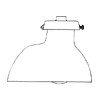
|
|
f 5163/55: asymmetric reflector
Later sold as the Z 5401/3 Clubfoot
|
|
F5163
|
60-100W GLS
|
BC
|
Top Entry
|
No Gear
|
1933 catalogue
|
|
F5165
|
60-100W GLS
|
BC
|
Top Entry
|
No Gear
|
1933 catalogue
|
|
|
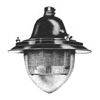
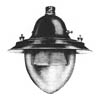
|
f 5167/68/69/70: wembley non-ventilated
British Prov. Patent: 11025/30
Wembley lanterns of the Totally Enclosed Type. Made from heavy gauge spun copper, stove enamelled green outside
and white inside. Can be supplied with an asymmetric type refractor (F5167/9) or a symmetrical type refractor (F5168/70).
All have a clear glass outer globe. Standard tapping at top for fixing ¾in gas thread.
|
|
F5167
|
60-100W GLS
|
BC
|
Top Entry
|
No Gear
|
1930 catalogue
|
|
F5168
|
60-100W GLS
|
BC
|
Top Entry
|
No Gear
|
1930 catalogue
|
|
F5169
|
150-200W GLS
|
BC
|
Top Entry
|
No Gear
|
1930 catalogue
|
|
F5170
|
150-200W GLS
|
BC
|
Top Entry
|
No Gear
|
1930 catalogue
|
|
|

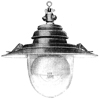
|
f 5171/73: wembley-suburban
Spun solid copper body, stove enamelled green outside and white inside, fitted with special telescopic
focussing device and carrier supporting a single-piece prismatic glass dome refractor. A bayonet cap
porcelain lampholder is fitted and a clear glass outer globe is held in a removable ring which surrounds the
refractor and lamp. Two special globe ring fasteners facilitate easy removal of the outer globe for cleaning
and lamp renewal. Interior of the lantern and underside of the reflector are finished in white stove enamel.
The F 5173 is similar but of slightly larger dimensions and is suitable for a larger lamp. In addition,
it is adequately ventilated by means of the cowl at the top and the lantern body. Can be supplied with
ES or BC lampholder.
|
|
F 5171
|
100-150W GLS
|
BC
|
Top Entry
|
No Gear
|
1920s catalogue
|
|
F 5173
|
200W GLS
|
BC
ES
|
Top Entry
|
No Gear
|
1920s catalogue
|
|
|
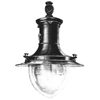
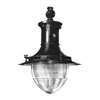
|
f 5177/79: wembley non-ventilated
British Prov. Patent: 11025/30
Wembley lanterns of the Totally Enclosed Type. Made from heavy gauge spun copper, stove enamelled green outside
and white inside. Can be supplied with an asymmetric type refractor and ribbed glass outer globe (F5179) or a
symmetrical type refractor and plain glass outer globe (F5177).
A focusing device enables the lamp to be raised or lowered inside the refractor to vary the light distribution
to suit the height and spacing of the units. The adjustment can be made from the outside without opening the
lantern. Standard tapping at top for fixing ¾in gas thread.
|
|
F5177
|
60-150W GLS
|
BC
|
Top Entry
|
No Gear
|
1930 catalogue
|
|
F5179
|
300-500W GLS
|
GES
|
Top Entry
|
No Gear
|
1930 catalogue
|
|
|
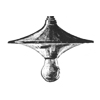
|
f 5238: double conic reflector fitting
14ins. diameter with cast iron top, finished painted and vitreous enamelled white under reflector. For
PEARL OSRAM Gasfilled Lamps.
|
|
F5238
|
60-100W GLS
|
BC
|
Top Entry
|
No Gear
|
1930 catalogue
1930 catalogue
1930 catalogue
|
|
|
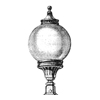
|
f 5247/48: paisley
Registered Design: 713241
Later sold as the Z 5601 Paisley.
Particularly suitable for residential districts. Lantern globe is made from "Superlax" glass, 16" diameter.
Suitably ventilated for use with 300W OSRAM gasfilled lamp. Approximate weight, 36 lb.
|
|
F5247
|
1 x 300W GLS
2 X 100W GLS
3 x 100W GLS
|
BC
2 X BC
3 X BC
|
Post Top
|
No Gear
|
1920s catalogue
1930 catalogue
1932 Catalogue
1933 catalogue
|
|
F5248
|
1 x 300W GLS
|
BC
|
Post Top
|
No Gear
|
1930 catalogue
1932 Catalogue
1933 catalogue
|
|
|
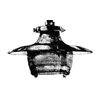
|
f 5281
Made from cast iron, vitreous enamelled white inside, fitted with detachable top, and
asymmetric refractor. The fitting is designed to give maximum illumination in the centre and along the
length of the roadway.
|
|
F5281
|
60-100W GLS
|
BC
|
Entire Bracket
|
No Gear
|
1930 catalogue
|
|
|
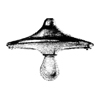
|
f 5285: reflector fitting
13½ins. diameter. Made in cast iron throughout. Painted on top, vitreous enamelled white under reflector
with focusing device for PEARL OSRAM Gasfilled Lamps.
|
|
F5285
|
60-100W GLS
|
BC
|
Top Entry
|
No Gear
|
1930 catalogue
|
|
|
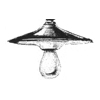
|
f 5289: reflector fitting
12ins. diameter, made in spun iron, finished vitreous enamelled green on top, white under reflector.
For PEARL OSRAM lamps. Approximate weight, each 4lb.
|
|
F5289
|
60-100W GLS
|
BC
|
Top Entry
|
No Gear
|
1930 catalogue
|
|
|
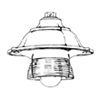
|
|
f 5441/42/43/45/46/47: wembley
Refractor: G 501, G 507 or G 513
Later sold as the Z 5041/53 York range.
The series of "Wembley" lanterns has been evolved as the result of many years of experience and research work.
They incorporate a number of special features for ease of maintenance and maximum efficiency. The refractors are
designed to give the maximum light output and ideal candle power distribution. This family is supplied without the
outer enclosing globe, and are therefore more inexpensive models (see F 5451/7 below). Can take
three different refractors: G 501 (symmetric), G 507 (non-axial asymmetric) and G 513 (axial asymmetric).
Made from cast iron. Accessible and rapid rotatable refractor plate
for lining up with the roadway without disturbing the joint between the bracket and lantern, and ensuring positive
location of any of the three types of refractor. Refractor secured by cadmium-plated supports and phosphor-bronze
springs. G.E.C. English-made prismatic glass refractor, giving maximum light output. Porcelain
lampholder. Standard tapping is ¾" gas. Standard finish is green outside, with all reflecting surfaces white
vitreous enamelled.
|
|
F 5441
|
60-100W GLS
|
BC
|
Top Entry
|
No Gear
|
1933 catalogue
|
|
F 5442
|
60-100W GLS
|
BC
|
Top Entry
|
No Gear
|
1933 catalogue
|
|
F 5443
|
60-100W GLS
|
BC
|
Top Entry
|
No Gear
|
1933 catalogue
|
|
F 5445
|
150-200W GLS
|
ES
|
Top Entry
|
No Gear
|
1933 catalogue
|
|
F 5446
|
150-200W GLS
|
ES
|
Top Entry
|
No Gear
|
1933 catalogue
|
|
F 5447
|
150-200W GLS
|
ES
|
Top Entry
|
No Gear
|
1933 catalogue
|
|
|
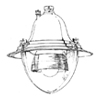
|
|
f 5451/52/53/55/56/57: wembley
Refractor: G 501, G 507 or G 513
Later sold as the Z 5001/16 range.
The series of "Wembley" lanterns has been evolved as the result of many years of experience and research work.
They incorporate a number of special features for ease of maintenance and maximum efficiency. The refractors are
designed to give the maximum light output and ideal candle power distribution. This family are totally enclosed and
therefore dustproof. An occasional wiping of the outer globe is all that is generally necessary to maintain maximum
illumination. The interior will only need attention in this respect at the end of long periods and this can be done
when it is necessary for the lanterns to be opened for lamp renewal purposes. (see F 5441/7 above). Can take
three different refractors: G 501 (symmetric), G 507 (non-axial asymmetric) and G 513 (axial asymmetric).
Made from heavy gauge copper body. Has an improved focussing device. Accessible and rapid rotatable refractor plate
for lining up with the roadway without disturbing the joint between the bracket and lantern, and ensuring positive
location of any of the three types of refractor. Refractor secured by cadmium-plated supports and phosphor-bronze
springs. G.E.C. English-made prismatic glass refractor, giving maximum light output. Hinged steel outer reflector,
vitreous enamelled for easy cleaning. Non-ventilated outer globe of English clear heat-resisting glass. Porcelain
lampholder. Standard tapping is ¾" gas. Standard finish is green outside, with all reflecting surfaces white
vitreous enamelled.
|
|
F5451
|
60-100W GLS
|
BC
|
Top Entry
|
No Gear
|
1933 catalogue
1933 catalogue
|
|
F5452
|
60-100W GLS
|
BC
|
Top Entry
|
No Gear
|
1933 catalogue
1933 catalogue
|
|
F5453
|
60-100W GLS
|
BC
|
Top Entry
|
No Gear
|
1933 catalogue
1933 catalogue
|
|
F5455
|
150-200W GLS
|
ES
|
Top Entry
|
No Gear
|
1933 catalogue
1933 catalogue
|
|
F5456
|
150-200W GLS
|
ES
|
Top Entry
|
No Gear
|
1933 catalogue
1933 catalogue
|
|
F5457
|
150-200W GLS
|
ES
|
Top Entry
|
No Gear
|
1933 catalogue
1933 catalogue
|
|
|
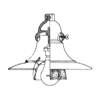
|
|
f 5461/63/65/67: wembley "norwich" pattern
Later sold as the Z 5081/93 range.
|
|
F5461
|
60-200W GLS
|
BC
|
Top Entry
|
No Gear
|
1933 catalogue
|
|
F5463
|
60-200W GLS
|
ES
|
Top Entry
|
No Gear
|
1933 catalogue
|
|
F5465
|
60-200W GLS
|
BC
|
Top Entry
|
No Gear
|
1933 catalogue
|
|
F5467
|
60-200W GLS
|
ES
|
Top Entry
|
No Gear
|
1933 catalogue
|
|
|
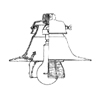
|
|
|
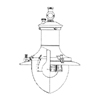
|
|
|
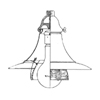
|
|
f 5485/87: wembley "hull" pattern
Later sold as the Z 5101/13 range.
|
|
F5485
|
300-500W GLS
|
GES
|
Top Entry
|
No Gear
|
1933 catalogue
|
|
F5487
|
300-500W GLS
|
GES
|
Top Entry
|
No Gear
|
1933 catalogue
|
|
|
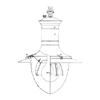
|
|
|
|
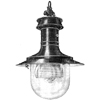
|
fc 6046/47/47a: wembley
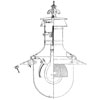 British Patent: 217029
British Patent: 217029
British Patent: 11025/30
Made from heavy gauge sheet copper. Enamelled green outside and white inside for reflecting
surfaces. With copper top and ventilator. The ventilator is a patented device operating on the ejector
principle is fitted combining extreme simplicity with highefficiency. This device causes a steady stream
of air to be drawn into the lantern and ejected from beneath thetop cowl. Exhaustive tests have been
carried out with this ventilating device, special attention being given tolamp performance. The result
of these tests demonstrates convincingly that the ventilation is such as to safeguard the lamp from
overheating and consequent reduction in normal life. The focusing device is a special patented feature
which enables the lamp to be raised or lowered inside the prismatic refractor,thus varying the distribution
of light to suit the height and spacing of units. All such adjustments in the largersize "WEMBLEY" lanterns
are made from the outside without opening the lantern in any way. The lamp is lowered until the filament
is sighted across the bottom edge of the refractor; the knob is turned a predetermined number of times
to the right, and adjustments can be made to the 1/100th part of an inch. The lantern is made in various sizes
to accommodate OSRAM gasfilled lamps of either 100 or 1500 watts, suitable for main thoroughfares,
suburban streets and residential areas. The light emission is ideal for street lighting, the maximum candle-power
being given at the useful angle of 70° from the vertical. The 300-500W GLS model (FC.6047) could be
converted for use with OSIRA lamps by means of general conversion units - likewise the 1000-1500W GLS
model could also be converted with similar kits.
|
|
FC. 6046
|
1000-1500W GLS
|
GES
|
Top Entry
|
No Gear
|
1924 catalogue
1920s catalogue
1930 catalogue
|
|
FC. 6047
|
300-500W GLS
|
GES
|
Top Entry
|
No Gear
|
1924 catalogue
1920s catalogue
1930 catalogue
|
|
FC. 6047A
|
??? GLS
|
GES
|
Top Entry
|
No Gear
|
1930 catalogue
|
|
|
|
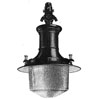
|
|
fc 6047: wembley conversion unit
Refractor: Z 6609
The 300-500W GLS model Wembley lantern (FC.6047) could be
converted for use with OSIRA lamps by means of a general conversion unit. This included the
Z 6609 bowl refractor, Z 0011 Type "D" top connecting box, Z Z609R felt
gasket and Z 0609 wire net. This gave an asymmetric directional distribution suitable for
road lighting.
|
|
FC. 6047
|
400W MA/V
|
GES
|
Top Entry
|
No Gear
|
1935 catalogue
|
|
|
|
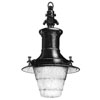
|
|
fc 6047: wembley conversion unit
Opal bowl: Z 6468
The 300-500W GLS model Wembley lantern (FC.6047) could be
converted for use with OSIRA lamps by means of a general conversion unit. This included the
Z 6468 opal bowl, Z 0011 Type "D" top connecting box and Z 7467 felt
gasket. This gave a dispersive distribution suitable for area lighting.
|
|
FC. 6047
|
400W MA/V
|
GES
|
Top Entry
|
No Gear
|
1935 catalogue
|
|
|
|
|
f ????: wing type lantern
Intended for use in side streets where 80W or 125W Osira lamps or
Osram lamps up to 200W are employed. It has a light alloy gallery and a one-piece blown-glass silvered
reflector, where the weight is very small, being only 5½lb.
|
|
Z???
|
60W-200W GLS
80W-125W MB
|
BC
3BC
|
Top Entry
|
No Gear
|
1939 Journal
|
|
|
|
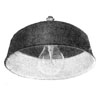
|
z 3130: dim out lantern
Conforms to Home Security Circular, No. 97/1944, July 1944, for "Dim Out" war lighting. Unit gives
illumination of 0.02fc with special requirements for light distribution. Introduced in July 1944.
|
|
Z3130
|
10W? GLS
|
BC
|
Top entry
|
No Gear
|
1944 Advert
|
|
|
|
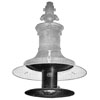
|
z 3200: arp lantern
Conforms to BS ARP/37 for wartime use. The GEC is manufacturing units for 20' nominal mounting height which are rated at 60W. The range has been
extended to include units for use with 40W lamps at 15'; and 25W and 15W lamps at various heights. The units which
are either: (1)
Held rigidly by the existing lantern body; (2) Supported from the existing lampholder; (3) Comprise entire weatherproof
units which can be screwed onto bracket arms. Fixing to the lantern body is recommended in all possible cases and is
considerd essential for lanterns suspended from tall columns or traction poles where considerable vibration exists.
In designing this type, the main consideration has been to ease in fixing to existing lanterns to avoid the cost and labour
involved in removing lanterns or rewiring them. The unit consists of two main parts, the light controlling device and
its fixed support. Where units are supported from the lantern body, rewiring of the lampholders or existing leads can
be avoided by the use of a special GEC connector. This consists of a flexible lead with an adaptor at the end
for fitting into the existing lampholder and at the other end the lampholder for the new unit. There are two
ranges of units employing different optical systems, providing correct light distribution: one designed for 15W/25W lamps,
and the other for 40W/60W lamps. While the 15W/25W lamps provide sufficient light, the more robust higher wattage lamps
are favoured by many engineers for withstanding the vibration at the top of tall columns, particularly traction poles,
due to traffic and windage.
The Z3200 range for 60W and 40W lamps is constructed of lead-coated sheet steel incorporating a special lighting
device. This consists essentially of a secondary light source provided by a flashed opal glas disc accurately screened
by a perforated metal plate. The light control is completed by a second screen. The bottom is detachable for maintenance.
All three methods of support are available.
|
|
Z3200
|
40W GLS
60W GLS
|
BC
BC
|
From lantern body
From lampholder
Top entry
|
No Gear
|
1940 Journal
|
|
|
|
z 3210: arp lantern
Conforms to BS ARP/37 for wartime use. The GEC is manufacturing units for 20' nominal mounting height which are rated at 60W. The range has been
extended to include units for use with 40W lamps at 15'; and 25W and 15W lamps at various heights. The units which
are either: (1)
Held rigidly by the existing lantern body; (2) Supported from the existing lampholder; (3) Comprise entire weatherproof
units which can be screwed onto bracket arms. Fixing to the lantern body is recommended in all possible cases and is
considerd essential for lanterns suspended from tall columns or traction poles where considerable vibration exists.
In designing this type, the main consideration has been to ease in fixing to existing lanterns to avoid the cost and labour
involved in removing lanterns or rewiring them. The unit consists of two main parts, the light controlling device and
its fixed support. Where units are supported from the lantern body, rewiring of the lampholders or existing leads can
be avoided by the use of a special GEC connector. This consists of a flexible lead with an adaptor at the end
for fitting into the existing lampholder and at the other end the lampholder for the new unit. There are two
ranges of units employing different optical systems, providing correct light distribution: one designed for 15W/25W lamps,
and the other for 40W/60W lamps. While the 15W/25W lamps provide sufficient light, the more robust higher wattage lamps
are favoured by many engineers for withstanding the vibration at the top of tall columns, particularly traction poles,
due to traffic and windage.
The Z3210 range of units for 25W and 15W lamps is constructed of spun steel and incorporates a lighting
device consisting of a flashed opal cylinder with surrounding metal grid to provide the correct light distribution
and intensity. The bottom is detachable for ease of maintenance. Units of this type are supplied for different mounting
heights and all three methods of support are available.
|
|
Z3210
|
15W GLS
25W GLS
|
BC
BC
|
From lantern body
From lampholder
Top entry
|
No Gear
|
1940 Journal
|
|
|
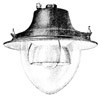
|
|
z 5001/02/03/04/05/06/11/12/13/14/15/16: enclosed wembley
Refractor: Z 6501, Z 6507 or Z 6513
Bowl: Z 6465 or 6475
Previously sold as the F 5451/7 range.
Z 5001/2/3 and Z 5011/2/3. Heavy gauage copper body. External focusing device. Accessible and
easily rotable refractor plate for lining up with the roadway without disturbing the joint between the bracket and the
lantern, and ensuring positive location of any of the three types of refractor. Refractor secured by cadmium-plated
supports and phosphor-bronze springs. G.E.C. patent English-made prismatic glass refractor, giving maximum light output.
Hinged steel outer reflector, vitreous enamelled for easy cleaning. Non-ventilated outer globe of English clear heat-resisting
glass. Porcelain lampholder.
Standing tapping, ¾-in. gas.
Standard finish - Green outside, all reflecting surfaces white vitreous enamelled.
Z 5004/5/6 and Z 5014/5/6/. As above, expect that the body is robust cast iron construction, painted green
externally and white internally.
|
|
Z5001
|
60-100W GLS
|
BC
|
Top Entry
|
No Gear
|
1937 catalogue
|
|
Z5002
|
60-100W GLS
|
BC
|
Top Entry
|
No Gear
|
1937 catalogue
|
|
Z5003
|
60-100W GLS
|
BC
|
Top Entry
|
No Gear
|
1937 catalogue
|
|
Z5004
|
60-100W GLS
|
BC
|
Top Entry
|
No Gear
|
1937 catalogue
|
|
Z5005
|
60-100W GLS
|
BC
|
Top Entry
|
No Gear
|
1937 catalogue
|
|
Z5006
|
60-100W GLS
|
BC
|
Top Entry
|
No Gear
|
1937 catalogue
|
|
Z5011
|
150-200W GLS
|
ES
|
Top Entry
|
No Gear
|
1937 catalogue
|
|
Z5012
|
150-200W GLS
|
ES
|
Top Entry
|
No Gear
|
1937 catalogue
|
|
Z5013
|
150-200W GLS
|
ES
|
Top Entry
|
No Gear
|
1937 catalogue
|
|
Z5014
|
150-200W GLS
|
ES
|
Top Entry
|
No Gear
|
1937 catalogue
|
|
Z5015
|
150-200W GLS
|
ES
|
Top Entry
|
No Gear
|
1937 catalogue
|
|
Z5016
|
150-200W GLS
|
ES
|
Top Entry
|
No Gear
|
1937 catalogue
|
|
|
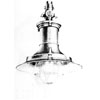
|
|
z 5021/22/23: enclosed wembley
Refractor: Z 6503, Z 6509 or Z 6515
Bowl: Z 6467 or 6477
Previously sold as the F 5179 range.
Heavy gauge copper body, external focusing and rotatable refractor plate. G.E.C. patent English-made prismatic glass
refractor. Hinged vitreous enamelled steel outer reflector, with quick release spring fixings. Non-ventilated outer glboe
of English clear heat-resisting glass, and durable felt gasket. Porcelain lamp-holder wired to standard terminal box (Type D)
with heat-resisting leads. Standard tapping, 1-in. gas. The standard terminal box (Type D) is supplied for rigid fixing, with cable entry at sides for
span wire fixing or overhead supply.Standard finish - Green outside, all reflecting surfaces white vitreous enamelled.
|
|
Z5021
|
300-500W GLS
|
GES
|
Top Entry
|
No Gear
|
1937 catalogue
|
|
Z5022
|
300-500W GLS
|
GES
|
Top Entry
|
No Gear
|
1937 catalogue
|
|
Z5023
|
300-500W GLS
|
GES
|
Top Entry
|
No Gear
|
1937 catalogue
|
|
|
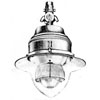
|
|
z 5024/25/26: enclosed wembley
Refractor: Z 6503, Z 6509 or Z 6515
Bowl: Z 6467
Heavy gauge copper body of improved design, external focusing control and rotatable refractor plate.
G.E.C. patent English-made prismatic glass refractor, hinged vitreous enamelled steel outer reflector with
quick release spring fixing. Non-ventilated outer glboe
of English clear heat-resisting glass and durable felt gasket. Porcelain lamp-holder wired to standard terminal box (Type D)
with heat-resisting leads. Standard tapping, 1-in. gas. Standard finish - Aluminium colour. All reflecting surfaces white vitreous enamelled.
|
|
Z5024
|
300-500W GLS
|
GES
|
Top Entry
|
No Gear
|
1937 catalogue
|
|
Z5025
|
300-500W GLS
|
GES
|
Top Entry
|
No Gear
|
1937 catalogue
|
|
Z5026
|
300-500W GLS
|
GES
|
Top Entry
|
No Gear
|
1937 catalogue
|
|
|
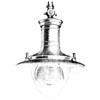
|
|
z 5031/32/33: enclosed wembley
Refractor: Z 6505, Z 6511 or Z 6517
Bowl: Z 6469
Heavy gauge copper body, external focusing and rotatable refractor plate. G.E.C. patent English-made prismatic glass
refractor. Hinged vitreous enamelled steel outer reflector, with quick release spring fixings. Non-ventilated outer glboe
of English clear heat-resisting glass, and durable felt gasket. Porcelain lamp-holder wired to standard terminal box (Type D)
with heat-resisting leads. Standard tapping, 1-in. gas. The standard terminal box (Type D) is supplied for rigid fixing, with cable entry at sides for
span wire fixing or overhead supply.Standard finish - Green outside, all reflecting surfaces white vitreous enamelled.
|
|
Z5031
|
1000-1500W GLS
|
GES
|
Top Entry
|
No Gear
|
1937 catalogue
|
|
Z5032
|
1000-1500W GLS
|
GES
|
Top Entry
|
No Gear
|
1937 catalogue
|
|
Z5033
|
1000-1500W GLS
|
GES
|
Top Entry
|
No Gear
|
1937 catalogue
|
|
|
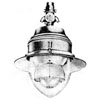
|
|
z 5034/35/36: enclosed wembley
Refractor: Z 6505, Z 6511 or Z 6517
Bowl: Z 6469
Heavy gauge copper body of improved design, external focusing control and rotatable refractor plate.
G.E.C. patent English-made prismatic glass refractor, hinged vitreous enamelled steel outer reflector with
quick release spring fixing. Non-ventilated outer glboe
of English clear heat-resisting glass and durable felt gasket. Porcelain lamp-holder wired to standard terminal box (Type D)
with heat-resisting leads. Standard tapping, 1-in. gas.
Standard finish - Aluminium colour. All reflecting surfaces white vitreous enamelled.
|
|
Z5034
|
1000-1500W GLS
|
GES
|
Top Entry
|
No Gear
|
1937 catalogue
|
|
Z5035
|
1000-1500W GLS
|
GES
|
Top Entry
|
No Gear
|
1937 catalogue
|
|
Z5036
|
1000-1500W GLS
|
GES
|
Top Entry
|
No Gear
|
1937 catalogue
|
|
|
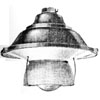
|
|
z 5041/42/43/51/52/53: open wembley: york
Refractor: Z 6501, Z 6507 or Z 6513
Previously sold as the F 5441/7 range.
Cast iron top with vitreous enamelled steel reflector. Rotatable to align refractor.
G.E.C. patent English-made prismatic glass refractor with quick release supports. Porcelain lampholder.
Focusing is by means of a flexible bridge piece which is screwed to the interior lug, enamling four different positions of the
lampholder to be obtained.
Standard tapping, ¾-in. gas.
Standard finish - Green outside, reflecting surface white vitreous enamelled.
|
|
Z5041
|
60-100W GLS
|
BC
|
Top Entry
|
No Gear
|
1937 catalogue
|
|
Z5042
|
60-100W GLS
|
BC
|
Top Entry
|
No Gear
|
1937 catalogue
|
|
Z5043
|
60-100W GLS
|
BC
|
Top Entry
|
No Gear
|
1937 catalogue
|
|
Z5051
|
150-200W GLS
|
ES
|
Top Entry
|
No Gear
|
1937 catalogue
|
|
Z5052
|
150-200W GLS
|
ES
|
Top Entry
|
No Gear
|
1937 catalogue
|
|
Z5053
|
150-200W GLS
|
ES
|
Top Entry
|
No Gear
|
1937 catalogue
|
|
|
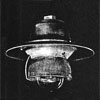
|
|
z 5045*/46*/47*/55*/56*/57*: open wembley
Refractor: Z 6502, Z 6508 or Z 6514
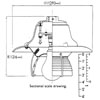
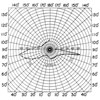 Introduced in 1946. For side road lighting; mounting height 13ft. - 15ft.; spacing 100 ft. - 120 ft.; and
road width up to 30 ft. Die-cast light alloy. The Z5315 and Z5045 range have the same body.
The outer reflector is 12 in. in diameter. The Z5055/6/7 have a
similar body but have a 10" outer reflector. An earthing screw is provided. The lampholder is mounted on a
movable bridge which slides on two vertical rods. One is marked with the correct focal position for the various
wattages of lamp which can be used. The Z.5045/6/7 and Z.5055/6/7 are the simplest form of small "Wembley"
lantern available and can be supplied with three different types of dome refractor which give three forms of
light distribution: (1) Symmetrical all round distribution with Z.6502 (reference letter "S") dome refractor; (2)
160 deg. Non-axial asymmetric, main light output up and down the street just away from the kerb with a Z.6508
(reference letter "N") dome refractor; (3) Axial asymmetric main light output directly up and down the street
with Z.6514 (reference letter "A") dome refractor. Has a conical reflector only which is held in position by three screws
and is white enamelled. The light alloy is spcially selected for its resistance to corrosion. Further
protection is obtained by the use of a suitable primer, undercoat and matt aluminium top coat.
Introduced in 1946. For side road lighting; mounting height 13ft. - 15ft.; spacing 100 ft. - 120 ft.; and
road width up to 30 ft. Die-cast light alloy. The Z5315 and Z5045 range have the same body.
The outer reflector is 12 in. in diameter. The Z5055/6/7 have a
similar body but have a 10" outer reflector. An earthing screw is provided. The lampholder is mounted on a
movable bridge which slides on two vertical rods. One is marked with the correct focal position for the various
wattages of lamp which can be used. The Z.5045/6/7 and Z.5055/6/7 are the simplest form of small "Wembley"
lantern available and can be supplied with three different types of dome refractor which give three forms of
light distribution: (1) Symmetrical all round distribution with Z.6502 (reference letter "S") dome refractor; (2)
160 deg. Non-axial asymmetric, main light output up and down the street just away from the kerb with a Z.6508
(reference letter "N") dome refractor; (3) Axial asymmetric main light output directly up and down the street
with Z.6514 (reference letter "A") dome refractor. Has a conical reflector only which is held in position by three screws
and is white enamelled. The light alloy is spcially selected for its resistance to corrosion. Further
protection is obtained by the use of a suitable primer, undercoat and matt aluminium top coat.
|
|
Z5045S/N/A
|
60-200W GLS
|
BC
|
Top Entry
|
No Gear
|
1946 advert
1946 advert
1947 paper
1948 catalogue
|
|
Z50456/N/A
|
80-125W MB/V
|
3BC
|
Top Entry
|
No Gear
|
1946 advert
1946 advert
1948 catalogue
|
|
Z5047S/N/A
|
60-200W GLS
|
BC
|
Top Entry
|
No Gear
|
1946 advert
1946 advert
1948 catalogue
|
|
Z5055S/N/A
|
60-200W GLS
|
BC
|
Top Entry
|
No Gear
|
1946 advert
1946 advert
1948 catalogue
|
|
Z5056S/N/A
|
80-125W MB/V
|
3BC
|
Top Entry
|
No Gear
|
1946 advert
1946 advert
1948 catalogue
|
|
Z5057S/N/A
|
60-200W GLS
|
BC
|
Top Entry
|
No Gear
|
1946 advert
1946 advert
1948 catalogue
|
|
|
|
|
z 5065/67/68: side-entry open wembley
Introduced in 1947.
|
|
Z5065
|
60-200W GLS
|
BC
|
Slopping Side Entry
|
No Gear
|
1948 catalogue
|
|
Z5066
|
80-125W MB/V
|
3BC
|
Slopping Side Entry
|
No Gear
|
1948 catalogue
|
|
Z5067
|
60-200W GLS
|
ES
|
Slopping Side Entry
|
No Gear
|
1948 catalogue
|
|
|
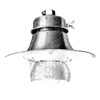
|
|
z 5061/62/63/71/72/73: open wembley: sheldon
Refractor: Z 6501, Z 6507 or Z 6513
Previously sold as the F 5471/7 range.
Cast iron top with vitreous enamelled steel reflector. Rotatable to align refractor.
G.E.C. patent English-made prismatic glass refractor with quick release supports. Porcelain lampholder.
Focusing is by means of a flexible bridge piece which is screwed to the interior lug, enamling four different positions of the
lampholder to be obtained.
Standard tapping, ¾-in. gas.
Standard finish - Green outside, reflecting surface white vitreous enamelled.
|
|
Z5061
|
60-100W GLS
|
BC
|
Top Entry
|
No Gear
|
1937 catalogue
|
|
Z5062
|
60-100W GLS
|
BC
|
Top Entry
|
No Gear
|
1937 catalogue
|
|
Z5063
|
60-100W GLS
|
BC
|
Top Entry
|
No Gear
|
1937 catalogue
|
|
Z5071
|
150-200W GLS
|
ES
|
Top Entry
|
No Gear
|
1937 catalogue
|
|
Z5072
|
150-200W GLS
|
ES
|
Top Entry
|
No Gear
|
1937 catalogue
|
|
Z5073
|
150-200W GLS
|
ES
|
Top Entry
|
No Gear
|
1937 catalogue
|
|
|
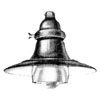
|
|
z 5081/82/83/91/9293: open type wembley: norwich
Refractor: Z 6501, Z 6507 or Z 6513
Previously sold as the F 5461/7 range.
Heavy gauge copper body, with vitreous enamelled steel reflector below. Special ventilated and detachable
top, with single fixing screw. Can be lined up with the roadway without disturbing the joint between bracket and
lantern. G.E.C. patent English-made prismatic glass refractor, with quick release supports. Porcelain lampholder.
Standard tapping, ¾-in. gas. Standard finish - Green outside, reflecting surface white vitreous enamelled.
|
|
Z5081
|
60-100W GLS
|
BC
|
Top Entry
|
No Gear
|
1937 catalogue
|
|
Z5082
|
60-100W GLS
|
BC
|
Top Entry
|
No Gear
|
1937 catalogue
|
|
Z5083
|
60-100W GLS
|
BC
|
Top Entry
|
No Gear
|
1937 catalogue
|
|
Z5091
|
60-100W GLS
|
ES
|
Top Entry
|
No Gear
|
1937 catalogue
|
|
Z5092
|
60-100W GLS
|
ES
|
Top Entry
|
No Gear
|
1937 catalogue
|
|
Z5093
|
60-100W GLS
|
ES
|
Top Entry
|
No Gear
|
1937 catalogue
|
|
|
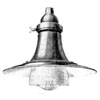
|
|
z 5101/02/03/11/12/13: open type wembley: hull
Refractor: Z 6503, Z 6505,Z 6509, Z 6511, Z 6515 or Z 6517
Previously sold as the F 5485/7 range.
Heavy gauge copper body, with vitreous enamelled steel reflector below. Special ventilated and detachable
top, with single fixing screw. Can be lined up with the roadway without disturbing the joint between bracket and
lantern. G.E.C. patent English-made prismatic glass refractor, with quick release supports. Porcelain lampholder.
Standard tapping, ¾-in. gas. Standard finish - Green outside, reflecting surface white vitreous enamelled.
|
|
Z5101
|
300-500W GLS
|
GES
|
Top Entry
|
No Gear
|
1937 catalogue
|
|
Z5102
|
300-500W GLS
|
GES
|
Top Entry
|
No Gear
|
1937 catalogue
|
|
Z5103
|
300-500W GLS
|
GES
|
Top Entry
|
No Gear
|
1937 catalogue
|
|
Z5111
|
1000-1500W GLS
|
GES
|
Top Entry
|
No Gear
|
1937 catalogue
|
|
Z5112
|
1000-1500W GLS
|
GES
|
Top Entry
|
No Gear
|
1937 catalogue
|
|
Z5113
|
1000-1500W GLS
|
GES
|
Top Entry
|
No Gear
|
1937 catalogue
|
|
|
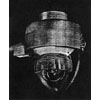
|
|
z 5128*c: side entry "wembley"
British Patent: 408419, 458617
Dome Refractor: Z 6504, Z 6510 or Z 6516
Bowl: Z 6467
See also: Z 8128
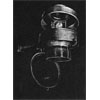 Tungsten filament version of the Z 8128 series. For main road lighting: 25 ft. mounting height; spacing 120-150 ft and road
width up to 40 ft. Side entry mounting only. Totally enclosed die-cast light alloy. A spring fit detachable top of spun light alloy gives
access to terminal block and focusing gear. A water baffle and drainage hole are provided to carry off any water
runnign along the bracket. An earthing screw is provided. The porcelain G.E.S. lampholder is mounted on a bridge
piece and wired to a porcelain connector with heat-resisting wire. Focusing is by means of a bridge piece carried
on two vertical rods one marked with grooves indicating the correct focal position for the different lamp
wattages. This is the Wembley version of the lantern and three forms of light distribution are available,
dependent upon the type of dome refractor in use:- (1) Symmetric, giving all-round distribution Z.6504
(reference letter "S") dome refractor; (2) 160 deg. non-axial asymmetric, giving main light output up and down
the street just away from the kerb with Z.6510 (reference letter "N") dome refractor; and (3) axial asymmetric,
providing light output directly up and down the street with Z.6516 (reference letter "A") dome refractor. The outer
bowl is a clear 'acorn-shaped' globe Z.6467 (reference letter C). The light alloy is
espcially selected for its resistance to corrosion. Further protection is obtained by the use of a suitable
primer, undercoat and matt aluminium top coat.
Tungsten filament version of the Z 8128 series. For main road lighting: 25 ft. mounting height; spacing 120-150 ft and road
width up to 40 ft. Side entry mounting only. Totally enclosed die-cast light alloy. A spring fit detachable top of spun light alloy gives
access to terminal block and focusing gear. A water baffle and drainage hole are provided to carry off any water
runnign along the bracket. An earthing screw is provided. The porcelain G.E.S. lampholder is mounted on a bridge
piece and wired to a porcelain connector with heat-resisting wire. Focusing is by means of a bridge piece carried
on two vertical rods one marked with grooves indicating the correct focal position for the different lamp
wattages. This is the Wembley version of the lantern and three forms of light distribution are available,
dependent upon the type of dome refractor in use:- (1) Symmetric, giving all-round distribution Z.6504
(reference letter "S") dome refractor; (2) 160 deg. non-axial asymmetric, giving main light output up and down
the street just away from the kerb with Z.6510 (reference letter "N") dome refractor; and (3) axial asymmetric,
providing light output directly up and down the street with Z.6516 (reference letter "A") dome refractor. The outer
bowl is a clear 'acorn-shaped' globe Z.6467 (reference letter C). The light alloy is
espcially selected for its resistance to corrosion. Further protection is obtained by the use of a suitable
primer, undercoat and matt aluminium top coat.
|
|
Z5128SC
|
300-500W GLS
|
GES
|
Side Entry
|
No Gear
|
1948 catalogue
|
|
Z5128NC
|
300-500W GLS
|
GES
|
Side Entry
|
No Gear
|
1948 catalogue
|
|
Z5128AC
|
300-500W GLS
|
GES
|
Side Entry
|
No Gear
|
1948 catalogue
|
|
|
|
|
z 5128*r: side entry "wembley"
British Patent: 408419, 458617
Dome Refractor: Z 6504, Z 6510 or Z 6516
Bowl: Z 6477
Tungsten filament version of the Z 8128 series. For main road lighting: 25 ft. mounting height; spacing 120-150 ft and road
width up to 40 ft. Side entry mounting only. Totally enclosed die-cast light alloy. A spring fit detachable top of spun light alloy gives
access to terminal block and focusing gear. A water baffle and drainage hole are provided to carry off any water
runnign along the bracket. An earthing screw is provided. The porcelain G.E.S. lampholder is mounted on a bridge
piece and wired to a porcelain connector with heat-resisting wire. Focusing is by means of a bridge piece carried
on two vertical rods one marked with grooves indicating the correct focal position for the different lamp
wattages. This is the Wembley version of the lantern and three forms of light distribution are available,
dependent upon the type of dome refractor in use:- (1) Symmetric, giving all-round distribution Z.6504
(reference letter "S") dome refractor; (2) 160 deg. non-axial asymmetric, giving main light output up and down
the street just away from the kerb with Z.6510 (reference letter "N") dome refractor; and (3) axial asymmetric,
providing light output directly up and down the street with Z.6516 (reference letter "A") dome refractor. The outer
bowl is a rimpled globe Z.6477 (reference letter R). The light alloy is
espcially selected for its resistance to corrosion. Further protection is obtained by the use of a suitable
primer, undercoat and matt aluminium top coat.
|
|
Z5128SR
|
300-500W GLS
|
GES
|
Side Entry
|
No Gear
|
1948 catalogue
|
|
Z5128NR
|
300-500W GLS
|
GES
|
Side Entry
|
No Gear
|
1948 catalogue
|
|
Z5128AR
|
300-500W GLS
|
GES
|
Side Entry
|
No Gear
|
1948 catalogue
|
|
|
|
|
z 5128"o": side entry "wembley"
British Patent: 408419, 458617
Bowl: Z 6468
Tungsten filament version of the Z 8128 series. For main road lighting: 25 ft. mounting height; spacing 120-150 ft and road
width up to 40 ft. Side entry mounting only. Totally enclosed die-cast light alloy. A spring fit detachable top of spun light alloy gives
access to terminal block and focusing gear. A water baffle and drainage hole are provided to carry off any water
runnign along the bracket. An earthing screw is provided. The porcelain G.E.S. lampholder is mounted on a bridge
piece and wired to a porcelain connector with heat-resisting wire. Focusing is by means of a bridge piece carried
on two vertical rods one marked with grooves indicating the correct focal position for the different lamp
wattages. This is the Wembley version of the lantern. The outer
bowl is a stepped opal Z.6468 (reference letter "O"). This is purely diffusive and no dome refractor is supplied.
The light alloy is
espcially selected for its resistance to corrosion. Further protection is obtained by the use of a suitable
primer, undercoat and matt aluminium top coat.
|
|
Z5128"O"
|
300-500W GLS
|
GES
|
Side Entry
|
No Gear
|
1948 catalogue
|
|
|
|
|
z 5128sb: side entry "oxford"
British Patent: 408419, 458617
Dome Refractor: Z 6504
Bowl: Z 6610
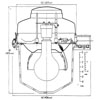
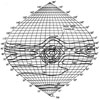 Tungsten filament version of the Z 8128 series. For main road lighting: 25 ft. mounting height; spacing 120-150 ft and road
width up to 40 ft. Side entry mounting only. Totally enclosed die-cast light alloy. A spring fit detachable top of spun light alloy gives
access to terminal block and focusing gear. A water baffle and drainage hole are provided to carry off any water
runnign along the bracket. An earthing screw is provided. The porcelain G.E.S. lampholder is mounted on a bridge
piece and wired to a porcelain connector with heat-resisting wire. Focusing is by means of a bridge piece carried
on two vertical rods one marked with grooves indicating the correct focal position for the different lamp
wattages. This is the Oxford version of the lantern. The optical system consists of a symmetric dome refractor
and an outer bowl refractor. The light alloy is
espcially selected for its resistance to corrosion. Further protection is obtained by the use of a suitable
primer, undercoat and matt aluminium top coat.
Tungsten filament version of the Z 8128 series. For main road lighting: 25 ft. mounting height; spacing 120-150 ft and road
width up to 40 ft. Side entry mounting only. Totally enclosed die-cast light alloy. A spring fit detachable top of spun light alloy gives
access to terminal block and focusing gear. A water baffle and drainage hole are provided to carry off any water
runnign along the bracket. An earthing screw is provided. The porcelain G.E.S. lampholder is mounted on a bridge
piece and wired to a porcelain connector with heat-resisting wire. Focusing is by means of a bridge piece carried
on two vertical rods one marked with grooves indicating the correct focal position for the different lamp
wattages. This is the Oxford version of the lantern. The optical system consists of a symmetric dome refractor
and an outer bowl refractor. The light alloy is
espcially selected for its resistance to corrosion. Further protection is obtained by the use of a suitable
primer, undercoat and matt aluminium top coat.
|
|
Z5128SB
|
300-500W GLS
|
GES
|
Side Entry
|
No Gear
|
1948 catalogue
|
|
|
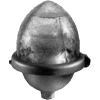
|
|
z 5130 | clearspace z 5130

 Refractor: Z 6504, Z 6510 or Z 6516
Refractor: Z 6504, Z 6510 or Z 6516
Bowl: Z 6475
One of the "Clearspace" range. This lantern is solely designed for outdoor sub-station lighting.
It has been approved by the C.E.G.B. for use in their sub-stations. It is intended for mounting at
a height of 8-10 ft. above ground. A special 8 ft. pivoted steel column has been designed for
use with the lantern so that it can be maintained by a man standing on the ground. The lantern is
designed to project a concentration of light at angles of 10° to 20° above the horizontal
where it is most needed, and to restrict intensities at and below the horizontal.
Control of the light distribution is obtained by the use of a prismatic glass refractor. Three types
of refractor are available: symmetric distribution (S) (Z 6504); non-axial distribution (N) (Z 6510)
and axial asymmetric (A) (Z 6516). The
choice of refractor depends upon the relative positions, as seen in plan, of the lantern and
the apparatus requiring most illumination.
The entry at the bottom of the lantern is tapped 1½in. B.S.P.; a grub screw is fitted for
locking the lantern on to the support.
The lantern body is of non-ferrous cast alloy, specially selected for its resistance to
corrosion. It has a cast alloy hinged ring holding the glass globe which can be swung open to give
access to the interior. These alloy castings are Pyluminised and finished stove enamelled aluminium
colour. The lantern is totally enclosed and dust proof, a neoprene gasket being provided on the
lip of the glass globe. The hinge pin, screw fastener and screws exposed to the weather are of
stainless steel.
An aluminium heat baffle is provided above the lamp to prevent excessive heating of the special
glass globe. The refractor is supported on a white vitreous enamelled plate and held in position
with spring clips.
A double-headed arrow on the outside of the lantern indicates the direction of the main beams of
light, and both the refractor and refractor plate can be fixed in only one direction.
|
|
Z5130S
|
300W GLS
|
GES
|
Post Top
|
No Gear
|
1960s catalogue
1964 catalogue
|
|
Z5130N
|
300W GLS
|
GES
|
Post Top
|
No Gear
|
1960s catalogue
1964 catalogue
|
|
Z5130A
|
300W GLS
|
GES
|
Post Top
|
No Gear
|
1960s catalogue
1964 catalogue
|
|
|
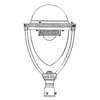
|
|
|
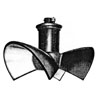
|
|
z 5201/02/03/04/05/06/11/12/14/15/16: open type reflectors
Previously sold as the F 5156/61 range.
G.E.C. directional street lighting reflectors, open pattern, can be supplied in various types for
providing an asymmetric distribution of light in two, three or four directions at angles between the reflectors to
suit varying road widths, junctions, intersections and mounting.
These are fitted with single piece silvered glass mirrors bent to the correct contour, and cemented into
cast iron backings which assist in ensuring long life to the silvered surfaces. Diffusing glass used to prevent
objectional glare, as with it the whole of the surface appears equally illuminated.
The cast iron backing holding the silvered glass reflectors are easily detachable from the top and body of the
fitting by unscrewing two nuts. This facilitates nesting for packing and stocking; wiring and erection; replacement
in the event of breakage; and has the additional great advantage of interchange ability, as tops and bodies are
universal for all patterns.
Robust cast iron top. External focusing screw, heavy gauge copper body. Single piece English-made diffusing
mirror glasses secured by special cement in protecting iron casting.
Standard tapping, ¾-in. gas.
Standard finish - Green
|
|
Z5201
|
60-200W GLS
|
BC or ES
|
Top Entry
|
No Gear
|
1937 catalogue
|
|
Z5202
|
60-200W GLS
|
BC or ES
|
Top Entry
|
No Gear
|
1937 catalogue
|
|
Z5203
|
60-200W GLS
|
BC or ES
|
Top Entry
|
No Gear
|
1937 catalogue
|
|
Z5204
|
60-200W GLS
|
BC or ES
|
Top Entry
|
No Gear
|
1937 catalogue
|
|
Z5205
|
60-200W GLS
|
BC or ES
|
Top Entry
|
No Gear
|
1937 catalogue
|
|
Z5206
|
60-200W GLS
|
BC or ES
|
Top Entry
|
No Gear
|
1937 catalogue
|
|
Z5211
|
300-500W GLS
|
GES
|
Top Entry
|
No Gear
|
1937 catalogue
|
|
Z5212
|
300-500W GLS
|
GES
|
Top Entry
|
No Gear
|
1937 catalogue
|
|
Z5214
|
300-500W GLS
|
GES
|
Top Entry
|
No Gear
|
1937 catalogue
|
|
Z5215
|
300-500W GLS
|
GES
|
Top Entry
|
No Gear
|
1937 catalogue
|
|
Z5216
|
300-500W GLS
|
GES
|
Top Entry
|
No Gear
|
1937 catalogue
|
|
|
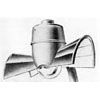
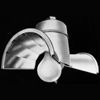
|
z 5221/22/23/25/26/27: facet directional lantern
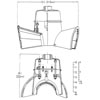
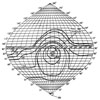 Introduced in 1946. Rather unorthorox in general design. It is a Wing Directional
lantern, the main body being a one-piece light alloy die casting with each wing holding 6
flat mirror facets. A spun, light alloy detachable top gives access to the lampholder and
focusing bridge. Produces a directional type of lighting and is mainly for use on Class B roads. It will accommodate
Osram fialment lamps between 60 and 200 watts, or 80 and 125-watt Osira H.P.M.V. lamps. There are six mirror facets in each of the two wings.
The facets are identical, removable and interchangeable so that replacement can easily be effected. The lantern compiles with the M.O.T. requirements
relating to glare ratio. Side-entry suspension at 30° from the vertical ensures that no condensation can enter the lantern from
the bracket.
Introduced in 1946. Rather unorthorox in general design. It is a Wing Directional
lantern, the main body being a one-piece light alloy die casting with each wing holding 6
flat mirror facets. A spun, light alloy detachable top gives access to the lampholder and
focusing bridge. Produces a directional type of lighting and is mainly for use on Class B roads. It will accommodate
Osram fialment lamps between 60 and 200 watts, or 80 and 125-watt Osira H.P.M.V. lamps. There are six mirror facets in each of the two wings.
The facets are identical, removable and interchangeable so that replacement can easily be effected. The lantern compiles with the M.O.T. requirements
relating to glare ratio. Side-entry suspension at 30° from the vertical ensures that no condensation can enter the lantern from
the bracket.
For side road lighting, mounting height 13 ft. - 15 ft. and spacing 100 ft. - 120 ft. Greater spacing will produce
dark areas midway between lanterns. For road widths up to 30 ft. Two forms of lantern body can be supplied. One is top
entry ¾ in. gas, the other is sloping side entry 1 in. gas barrel unthreaded. In the latter case a ¼ in.
Allen grub screw locks the lantern to the bracket. Each body is made of die-cast light alloy and consists of two
detachable wings, a main body casting and a top, which, in the case of the sloping side entry form, is a light alloy
spinning. An earthing screw is provided. Each wing carries six identical facet mirrors, therse are silvered and lead
backed and held in position by lead clips. In the event of damage, replacement is simple. The light distribution is very
good and the glare ratio conforms to the recommendations of the M.O.T. Final Report 1937, though it is necessary, when
used with H.P.M.V. Lamps, to replace the four lower mirror facets with pot opal facets. If this is not done, the
directional intensity ratio is about 5.5. The lampholder is carried on a bridge piece which slides on two vertical rods.
One rod is marked with the correct focal positions for the various wattages of lamp. The light alloy is
spcially selected for its resistance to corrosion. Further protection is obtained by the use of a suitable
primer, undercoat and matt aluminium top coat.
|
|
Z5221
|
60-200W GLS
45W SO/V
|
BC
|
Sloping Side Entry
|
No Gear
|
1946 program
1947 book
1947 advert
1947 paper
1948 catalogue
1951 book
|
|
Z5222
|
80-125W MB/V
|
3BC
|
Sloping Side Entry
|
No Gear
|
1946 program
1947 book
1947 advert
1948 catalogue
1951 book
|
|
Z5223
|
60-200W GLS
|
ES
|
Sloping Side Entry
|
No Gear
|
1946 program
1947 book
1947 advert
1948 catalogue
1951 book
|
|
Z5225
|
60-200W GLS
45W SO/V
|
BC
|
Top Entry
|
No Gear
|
1946 program
1947 book
1948 catalogue
1951 book
|
|
Z5226
|
80-125W MB/V
|
3BC
|
Top Entry
|
No Gear
|
1946 program
1947 book
1948 catalogue
1951 book
|
|
Z5227
|
60-200W GLS
|
ES
|
Top Entry
|
No Gear
|
1946 program
1947 book
1948 catalogue
1951 book
|
|
|
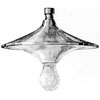
|
|
z 5301/02/03/04/05/06/07: conical reflector
Previously sold as the F 5090/6 range.
This series represents a very complete range of conical reflector fittings, varying from 12 ins. to 17¾ ins.
in diameter and arrnged for OSRAM lamps from 400 watts to 200 watts. They are supplied in cast iron or mild
steel, with vitreous enamel or white porcelain reflecting surfaces. Standard tapping, ¾-in. gas
|
|
Z5301
|
40-150W GLS
|
BC
|
Top Entry
|
No Gear
|
1937 catalogue
|
|
Z5302
|
40-150W GLS
|
BC
|
Top Entry
|
No Gear
|
1937 catalogue
|
|
Z5303
|
40-150W GLS
|
BC
|
Top Entry
|
No Gear
|
1937 catalogue
|
|
Z5304
|
40-150W GLS
|
BC
|
Top Entry
|
No Gear
|
1937 catalogue
|
|
Z5305
|
40-150W GLS
|
BC/ES
|
Top Entry
|
No Gear
|
1937 catalogue
|
|
Z5306
|
60-150W GLS
|
BC/ES
|
Top Entry
|
No Gear
|
1937 catalogue
|
|
Z5307
|
100-200W GLS
|
BC/ES
|
Top Entry
|
No Gear
|
1937 catalogue
|
|
|
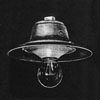
|
|
z 5315/16/17: conical reflector
For side road lighting; mounting height 13ft. - 15ft.; spacing 100 ft. - 120 ft.;
and road width up to 30 ft. Die-cast light alloy. The Z5315 and Z5045 range have the same body.
The outer reflector is 12 in. in diameter. An earthing screw is provided. The lampholder is mounted
on a movable bridge which slides on two vertical rods. One is marked with the correct focal
position for the various wattages of lamp which can be used. Has a conical reflector only which is
held in position by three screws and is white enamelled. It is possible to change the Z5315/6/7 series
to the Z5045/6/7 series with a conversion set consisting of reflector plate, spring supports and
dome refractor. The light alloy is spcially selected for its resistance to corrosion. Further
protection is obtained by the use of a suitable primer, undercoat and matt aluminium top coat.
|
|
Z5315
|
60-200W GLS
|
BC
|
Top Entry
|
No Gear
|
1948 catalogue
|
|
Z5316
|
80-125W MBF/U
|
3BC
|
Top Entry
|
No Gear
|
1948 catalogue
|
|
Z5317
|
60-200W GLS
|
ES
|
Top Entry
|
No Gear
|
1948 catalogue
|
|
|
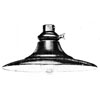
|
z 5321/22: minehead
Heavy gauge copper body, with detachable cast iron top and vitreous enamelled steel reflector. Supplied for vertical
fixing (1-in. gas) or with cast iron terminal body and finial for side fixing (1-in. gas). Standard finish - Green or aluminium outside,
reflecting surface white vitreous enamelled.
|
|
Z5321
|
100-200W GLS
|
BC
|
Top Entry
|
No Gear
|
1937 catalogue
|
|
Z5322
|
100-200W GLS
|
BC
|
Side Entry
|
No Gear
|
1937 catalogue
|
|
|
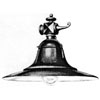
|
z 5323/24: athens
Heavy gauge copper body, with detachable cast iron top and vitreous enamelled steel reflector. Supplied for vertical
fixing (1-in. gas) or with cast iron terminal body and finial for side fixing (1-in. gas). Standard finish - Green or aluminium outside,
reflecting surface white vitreous enamelled.
|
|
Z5323
|
300-500W GLS
|
GES
|
Top Entry
|
No Gear
|
1937 catalogue
|
|
Z5324
|
300-500W GLS
|
GES
|
Side Entry
|
No Gear
|
1937 catalogue
|
|
|
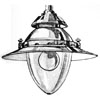
|
|
z 5331: suburban
Previously sold as the FA 8167
Globe: Z 6451
Body of high-grade cast iron, with spun steel reflector. Finished aluminium colour outside,
and white vitreous enamel reflecting surface. Supplied with clear flint glass, 6½ ins. diam.,
6 7/8 ins. deep. Tapped ½-in. gas thread.
|
|
Z5331
|
100W GLS
|
BC
|
Top Entry
|
No Gear
|
1937 catalogue
|
|
|
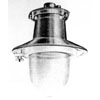
|
|
z 5332: welby
Globe: Z 6455
Body of high-grade cast iron. Finished aluminium colour outside, white inside. Supplied complete
with clear glass, 8 ins. diam., 7¾ ins. deep. Tapped ¾-in. gas thread.
|
|
Z5332
|
200W GLS
|
BC
|
Top Entry
|
No Gear
|
1937 catalogue
|
|
|
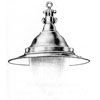
|
|
z 5333/34: footway
Previously sold as the F 8260 and F5101.
Globe: Z 6451 or Z 6453
Vitreous enamelled steel body and reflector, finished green outside and white inside. Supplied
complete with clear flint or opalescent globe. Insulated shackle suspension.
|
|
Z5333
|
60W GLS
|
BC
|
Top Entry
|
No Gear
|
1937 catalogue
|
|
Z5334
|
60W GLS
|
BC
|
Top Entry
|
No Gear
|
1937 catalogue
|
|
|
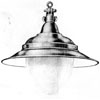
|
|
z 5335/36: terrace
Previously sold as the F 8266 and F5103.
Globe: Z 6455 or Z 6457
Vitreous enamelled steel body and reflector, finished green outside and white inside. Supplied
complete with clear flint or opalescent globe. Insulated shackle suspension. Can be suuplied with ¾-in. gas or
electric thread tapped nozzle at top, for rigid fixing in place of shackle if desired.
|
|
Z5335
|
100W GLS
|
BC
|
Top Entry
|
No Gear
|
1937 catalogue
|
|
Z5336
|
100W GLS
|
BC
|
Top Entry
|
No Gear
|
1937 catalogue
|
|
|
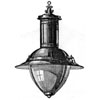
|
|
z 5337/38: birmingham
Previously sold as the FA 8166 and F 5111.
Globe: Z 6455 or Z 6441
Vitreous enamelled steel body and reflector, finished green outside and white inside. Supplied
complete with clear flint globe. Supplied with ¾-in. gas or
electric thread tapped nozzle at top, for rigid fixing.
|
|
Z5337
|
200W GLS
|
ES
|
Top Entry
|
No Gear
|
1937 catalogue
|
|
Z5338
|
500W GLS
|
GES
|
Top Entry
|
No Gear
|
1937 catalogue
|
|
|
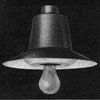
|
z 5350/51/52 | clearside z 5350/51/52
One of the "Clearside" range for Group B roads for side road lighting. 15 ft. mounting height;
spacing 100-120 ft. for best results; road width up to 30 ft. The lanterns can also be used for
space and area lighting. Top entry, the lantern is tapped ¾ in. B.S.P. and locked to the
bracket by a ¼ in. diameter Allen-type grub screw. The lantern body is made from
die-cast aluminium alloy. This range has a plain white enamelled reflector plate and no provision
for a dome refractor. An earthing screw is provided. The lampholder is mounted on a cranked bridge-piece
carried on stepped lugs within the lantern body; these provide adjustment for the various
wattages and types of lamp which can be used. The optical system is simply the white enamelled reflector plate
held in place by three screws. The alloy used is specially selected for its resistance to corrosion and is
specially finished to give a pleasing appearance.
|
|
Z5350
|
60-200W GLS
|
BC
|
Top Entry
|
No Gear
|
1960s catalogue
1961 catalogue
|
|
Z5351
|
80-125W MBF/U
|
3BC
|
Top Entry
|
No Gear
|
1960s catalogue
1961 catalogue
|
|
Z5352
|
60-200W GLS
|
ES
|
Top Entry
|
No Gear
|
1960s catalogue
1961 catalogue
|
|
|
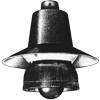
|
z 5354/55/56 | clearside z 5354/55/56
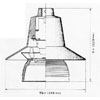
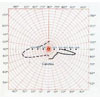 Refractors: Z 6502, Z 6508 and Z 6514
Refractors: Z 6502, Z 6508 and Z 6514
One of the "Clearside" range for Group B roads for side road lighting. 15 ft. mounting height;
spacing 100-120 ft. for best results; road width up to 30 ft. The lanterns can also be used for
space and area lighting. Top entry, the lantern is tapped ¾ in. B.S.P. and locked to the
bracket by a ¼ in. diameter Allen-type grub screw. The lantern body is made from
die-cast aluminium alloy. This range has a white enamelled reflector plate which carries the
single piece prismatic glass dome refractor. The refractor is held by two stainless steel spring
clips. An earthing screw is provided. The lampholder is mounted on a cranked bridge-piece
carried on stepped lugs within the lantern body; these provide adjustment for the various
wattages and types of lamp which can be used. These lanterns have provision for a prismatic glass
dome refractor giving three alternative types of light distribution: (1) Z6502 (reference letter 'S')
symmetric all-round distribution; (2) Z6508 (reference letter 'N') 160° non-axial asymmetric
distribution; and Z6514 (reference letter 'A') axial asymmetric distribution. The alloy used is
specially selected for its resistance to corrosion and is specially finished to give a
pleasing appearance.
|
|
Z5354S
|
60-200W GLS
|
BC
|
Top Entry
|
No Gear
|
1960s catalogue
1961 catalogue
1979 catalogue
|
|
Z5355S
|
80-125W MBF/U
|
3BC
|
Top Entry
|
No Gear
|
1960s catalogue
1961 catalogue
1979 catalogue
|
|
Z5356S
|
60-200W GLS
80-125W MBF/U
50-120W SON
|
ES
|
Top Entry
|
No Gear
|
1960s catalogue
1961 catalogue
1979 catalogue
|
|
Z5354N
|
60-200W GLS
|
BC
|
Top Entry
|
No Gear
|
1960s catalogue
1961 catalogue
1979 catalogue
|
|
Z5355N
|
80-125W MBF/U
|
3BC
|
Top Entry
|
No Gear
|
1960s catalogue
1961 catalogue
1979 catalogue
|
|
Z5356N
|
60-200W GLS
80-125W MBF/U
50-120W SON
|
ES
|
Top Entry
|
No Gear
|
1960s catalogue
1961 catalogue
1979 catalogue
|
|
Z5354A
|
60-200W GLS
|
BC
|
Top Entry
|
No Gear
|
1960s catalogue
1961 catalogue
1979 catalogue
|
|
Z5355A
|
80-125W MBF/U
|
3BC
|
Top Entry
|
No Gear
|
1960s catalogue
1961 catalogue
1979 catalogue
|
|
Z5356A
|
60-200W GLS
80-125W MBF/U
50-120W SON
|
ES
|
Top Entry
|
No Gear
|
1960s catalogue
1961 catalogue
1979 catalogue
|
|
|
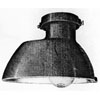
|
z 5401/02/03: club foot
British Patent: 340551
Previously sold as the F 5163/5 Asymmetric Reflector
The above reflector fitting, which is of the open type, consists of a cast iron body, painted green outside,
equipped with a cemented-in asymmetric type silvered glass interior reflector, of special contour, arranged to
direct the light up and down the street and over the roadway in such a manner as to increase materially the
lighting at the point midway between the standards, where the illumination is usually very low.
It is particularly easy to clean as the interior surface of the reflector is quite smooth. The actual lamp filament
is screened for view when approaching, thereby preventing glare.
The fitting is most suitable for use at low mounting heights and normal spacing. Standard tapping for fixing
is ½-in. gas thread.
|
|
Z5401
|
60 GLS
|
BC
|
Top Entry
|
No Gear
|
1937 catalogue
|
|
Z5402
|
100 GLS
|
BC
|
Top Entry
|
No Gear
|
1937 catalogue
|
|
Z5403
|
150-200W GLS
|
ES
|
Top Entry
|
No Gear
|
1937 catalogue
|
|
|
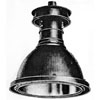
|
|
z5411: p.l.a.
Previously sold as the F 5155
Has been specially designed to comply with the Port of London Authority requirement
for docks, also for use in car parks, factory yards, etc. The lamp filament is screened, and special attention
has been paid to the securing of the strength and robustness which are so essential in lanterns used for
such purposes. The top is fitted with a special ventilated device operating on the ejector principle. The
body is constructed of heavy gauge copper, finished stove enamelled green outisde, and includes a single-piece
"Gecoray" silvered glass reflector of special contour. The reflector is so designed as to give an angle of
cut-off of 65° for the prevention of glare. Adjustment can be made to give an angle of cut-off of
65° for the prevention of glare. Adjustment can be made to give an angle of cut-off up to 71° where
it is necessary to increase the distance apart. The mounting height recommended is from 30 to 35 feet,
with a spacing of 110 feet apart.
The body is of heavy gauge copper, non-ventilated and finished green. Fitted with a single-piece "Gecoray"
reflector. Of light weight construction and very neat appearance.
Maximum peak candle power intensity at an angle of 57° can be obtained with 65° cut-off.
Maximum peak candle power intensity at an angle of 65° can be obtained with 71° cut-off.
Standard tapping, 1-in. gas.
|
|
Z5411
|
500W GLS
|
GES
|
Top Entry
|
No Gear
|
1937 catalogue
|
|
|
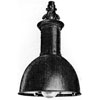
|
|
z 5412
Has been specially designed to comply with the Port of London Authority requirement
for docks, also for use in car parks, factory yards, etc. The lamp filament is screened, and special attention
has been paid to the securing of the strength and robustness which are so essential in lanterns used for
such purposes. The top is fitted with a special ventilated device operating on the ejector principle. The
body is constructed of heavy gauge copper, finished stove enamelled green outisde, and includes a single-piece
"Gecoray" silvered glass reflector of special contour. The reflector is so designed as to give an angle of
cut-off of 65° for the prevention of glare. Adjustment can be made to give an angle of cut-off of
65° for the prevention of glare. Adjustment can be made to give an angle of cut-off up to 71° where
it is necessary to increase the distance apart. The mounting height recommended is from 30 to 35 feet,
with a spacing of 110 feet apart.
The body is of heavy gauge copper, non-ventilated and finished green. Fitted with a single-piece "Gecoray"
reflector. Of light weight construction and very neat appearance. Has a single knob external focusing control.
Maximum peak candle power intensity at an angle of 57° can be obtained with 65° cut-off.
Maximum peak candle power intensity at an angle of 65° can be obtained with 71° cut-off.
Standard tapping, 1-in. gas.
|
|
Z5412
|
500W GLS
|
GES
|
Top Entry
|
No Gear
|
1937 catalogue
|
|
|

|
|
|
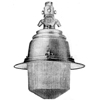
|
z 5515: small oxford
Refractors: Z 6607 and Z 6501
See also: Z 8155
Totally enclosed dust-proof lantern, specially designed for low wattage OSRAM gasfilled lamps constructed of heavy gauge
spun copper body with cast iron top, omplete with porcelain enamelled steel inner and outer reflectors. The outer reflector
is hinged and provided with a locating notch for a G.E.C. prismatic glass bowl refractor, which, with a felt gasket, makes
the lantern dustproof. An inner symmetric refractor converts the light from the OSRAM lamp to the vertical shaped source
for correct light distribution by the outer bowl refractor. An external focusing knob is provided so that the correct positions
of the different wattage lamps can be immediately obtained. The lantern is supplied with a felt gasket. The patent G.E.C.
top connecting box, designed to eliminate lamp failure due to water drip or condensation, is wired with heat-resisting leads
to an E.S. porcelain lampholder.
The external finish of the lantern is aluminium colour with all reflecting surfaces heavy vitreous enamlled. An important
feature of this lantern is that by the removal of the inner symmetric refractor and the replacement of the inner reflector
by one of a different shape the lantern becomes suitable for use with the 80 and 125-watt discharge lamps.
|
|
Z5515
|
60-200W GLS
80-125W MBF/U
|
ES
3BC
|
Top Entry
|
No Gear
|
1937 Catalogue
|
|
|
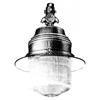
|
z 5525: oxford
British Patents: 458617, 424800, 408419, 427835, 876831
Refractors: Z 6609 and Z 6503
Introduced in 1936. First installation along Banbury Road, Oxford. For main road lighting.
Designed to use the GLS lamp with the MA/V Glass Bowl Refractor - therefore an inner symmetric
dome refractor is used to produce the vertically shaped light source for control by the
outer bowl refractor.
Totally enclosed dust-proof lantern for use with 300/500-watt OSRAM gasfilled lamps, body constructed of heavy gauge
spun copper with porcelain enamelled steel inner and outer reflectors. The outer reflector is hinged and provided with
a locating notch for a G.E.C. single piece prismatic glass bowl refractor. This refractor was specially developed and
designed by the G.E.C. research laboratories, and is identical with that used on the Di-fractor lanterns. It produces a very
high standard of road brightness and at teh same time the whole surface of the bowl appears evenly illuminated, so avoiding
the glare which is produced by less carefully designed imitations on which only a small section is flashed. An
inner symmetric refractor prodcues the necessary vertical shaped light souce for control by the outer glass bowl refractor. An
external focusing knob is provided so that the correct positions for the different sized lamps can be immediately obtained.
The lantern is supplied with a felt gask and a wire net. The patent G.E.C. top connecting box designed to eliminate all
danger of lamp failure due to water drop and condensation is wired with heat-resisting leads to the G.E.S. porcelain holder.
The external finish of the lantern is aluminium colour with all reflecting surfaces heavily vitreous enamelled.
An important feature of this lantern is that by removal of the inner symmetric refractor and the replacement of
the inner reflector by one of different shape, the lantern becomes suitable for use with OSRIA lamps.
|
|
Z5525
|
300-500W GLS
|
GES
|
Top Entry
|
No Gear
|
1936 Journal
1939 Journal
1937 Catalogue
|
|
|
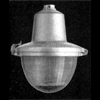
|
|
z 5530/31/32: brookvale
|
|
Z5530
|
60-200W GLS
80-125W MB/U
80-125W MBF/U
|
BC
3BC
3BC
|
Top Entry
|
No Gear
|
Light And Lighting 1959
|
|
|
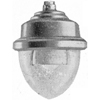
|
z 5540/41/42/50/51/52*c: enclosed small wembley
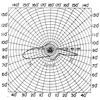
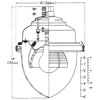
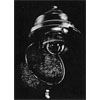 Refractor: Z6502, Z6508 or Z6514
Refractor: Z6502, Z6508 or Z6514
Bowl: Z 6465
Introduced in 1945 as part of a rationalised new range. The body of copper follows
the outline of the Side-Entry
Di-Fractor lantern (Z8128). Probably designed in copper to
"utilise available production facilities to the full" in the post-war
environment. For side street lighting, employing a single lantern body,
and a variety of optical glasses - any required type of light distribution -
can be obtained. An internal lamp positioning device enables Osram lamps up
to 200W or Osira HPMV lamps up to 125W to be used.
For side road lighting; mounting height 13ft. - 15ft.; spacing 100 ft. - 120 ft. for best results.
Greater spacing will produce dark areas midway between lanterns. Road width up to 30 ft. Also suitable
for space or area lighting.
Top entry. The lantern entry is ¾ in. gas. The lantern is locked to the bracket by a ¼ in.
Allen type grub screw. There are two ranges of lantern body: A spun non-ferrous body (Z.5540/1/2) or
a die-cast light alloy body (Z.5550/1/2). An earthing screw is provided. The lampholder is mounted on a
movable bridge which slides on two vertical rods. One is marked with the correct focal position for the
various wattages of lamp which can be used.
A dome refractor controls the light distribution of which three forms are available: (1) Symmetric all
round distribution with Z.6502 (reference letter 'S') dome refractor; (2) 160 deg. Non-axial asymmetric,
main light output up and down the street just away from the kerb with Z.6508 (reference letter 'N') dome
refractor; (3) Axial asymmetric main light output directly up and down the street with Z.6514 (reference letter 'A') dome refractor.
The dome refractor is held by three spring supports from a white enamelled inner reflector.
Fitted with the clear globe (acorn shaped) bowl Z 6465.
The light alloy is specially selected for its resistance to corrosion. Further protection is obtained
by the use of a suitable primer, undercoat and matt aluminium top coat.
|
Z5540NC
Z5540AC
Z5540SC
|
60-200W GLS
|
BC
|
Top Entry
|
No Gear
|
1945 advert
1945 programme
1945 advert
1946 advert
1946 advert
1946 advert
1947 paper
1948 catalogue
|
Z5541NC
Z5541AC
Z5541SC
|
80-125W MB/U
80-125W MBF/U
|
3BC
|
Top Entry
|
No Gear
|
1945 advert
1945 programme
1945 advert
1946 advert
1946 advert
1946 advert
1947 paper
1948 catalogue
|
Z5542NC
Z5542AC
Z5542SC
|
60-200W GLS
|
ES
|
Top Entry
|
No Gear
|
1945 advert
1945 programme
1945 advert
1946 advert
1946 advert
1946 advert
1947 paper
1948 catalogue
|
Z5550NC
Z5550AC
Z5550SC
|
60-200W GLS
|
BC
|
Top Entry
|
No Gear
|
1945 advert
1945 programme
1945 advert
1946 advert
1946 advert
1946 advert
1947 paper
1948 catalogue
|
Z5551NC
Z5551AC
Z5551SC
|
80-125W MB/U
80-125W MBF/U
|
3BC
|
Top Entry
|
No Gear
|
1945 advert
1945 programme
1945 advert
1946 advert
1946 advert
1946 advert
1947 paper
1948 catalogue
|
Z5552NC
Z5553AC
Z5554SC
|
60-200W GLS
|
ES
|
Top Entry
|
No Gear
|
1945 advert
1945 programme
1945 advert
1946 advert
1946 advert
1946 advert
1947 paper
1948 catalogue
|
|
|
|
|
z 5540/41/42/50/51/52*r: enclosed small wembley
Refractor: Z6502, Z6508 or Z6514
Bowl: Z 6475
Introduced in 1945 as part of a rationalised new range. The body of copper follows
the outline of the Side-Entry
Di-Fractor lantern (Z8128). Probably designed in copper to
"utilise available production facilities to the full" in the post-war
environment. For side street lighting, employing a single lantern body,
and a variety of optical glasses - any required type of light distribution -
can be obtained. An internal lamp positioning device enables Osram lamps up
to 200W or Osira HPMV lamps up to 125W to be used.
For side road lighting; mounting height 13ft. - 15ft.; spacing 100 ft. - 120 ft. for best results.
Greater spacing will produce dark areas midway between lanterns. Road width up to 30 ft. Also suitable
for space or area lighting.
Top entry. The lantern entry is ¾ in. gas. The lantern is locked to the bracket by a ¼ in.
Allen type grub screw. There are two ranges of lantern body: A spun non-ferrous body (Z.5540/1/2) or
a die-cast light alloy body (Z.5550/1/2). An earthing screw is provided. The lampholder is mounted on a
movable bridge which slides on two vertical rods. One is marked with the correct focal position for the
various wattages of lamp which can be used.
A dome refractor controls the light distribution of which three forms are available: (1) Symmetric all
round distribution with Z.6502 (reference letter 'S') dome refractor; (2) 160 deg. Non-axial asymmetric,
main light output up and down the street just away from the kerb with Z.6508 (reference letter 'N') dome
refractor; (3) Axial asymmetric main light output directly up and down the street with Z.6514 (reference letter 'A') dome refractor.
The dome refractor is held by three spring supports from a white enamelled inner reflector.
Fitted with the rimpled globe bowl Z 6475.
The light alloy is specially selected for its resistance to corrosion. Further protection is obtained
by the use of a suitable primer, undercoat and matt aluminium top coat.
|
Z5540NR
Z5540AR
Z5540SR
|
60-200W GLS
|
BC
|
Top Entry
|
No Gear
|
1945 advert
1945 programme
1945 advert
1946 advert
1946 advert
1946 advert
1947 paper
1948 catalogue
|
Z5541NR
Z5541AR
Z5541SR
|
80-125W MB/U
80-125W MBF/U
|
3BC
|
Top Entry
|
No Gear
|
1945 advert
1945 programme
1945 advert
1946 advert
1946 advert
1946 advert
1947 paper
1948 catalogue
|
Z5542NR
Z5542AR
Z5542SR
|
60-200W GLS
|
ES
|
Top Entry
|
No Gear
|
1945 advert
1945 programme
1945 advert
1946 advert
1946 advert
1946 advert
1947 paper
1948 catalogue
|
Z5550NR
Z5550AR
Z5550SR
|
60-200W GLS
|
BC
|
Top Entry
|
No Gear
|
1945 advert
1945 programme
1945 advert
1946 advert
1946 advert
1946 advert
1947 paper
1948 catalogue
|
Z5551NR
Z5551AR
Z5551SR
|
80-125W MB/U
80-125W MBF/U
|
3BC
|
Top Entry
|
No Gear
|
1945 advert
1945 programme
1945 advert
1946 advert
1946 advert
1946 advert
1947 paper
1948 catalogue
|
Z5552NR
Z5553AR
Z5554SR
|
60-200W GLS
|
ES
|
Top Entry
|
No Gear
|
1945 advert
1945 programme
1945 advert
1946 advert
1946 advert
1946 advert
1947 paper
1948 catalogue
|
|
|
|
|
|
|
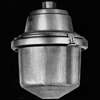
|
|
z 5543b/45sb/46sb/47sb/48b/49b/55sb/56sb/57sb/58b/59b: small oxford
British Patents: 408419 and 458617
Refractor: Z6502
Bowl: Z6607
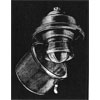
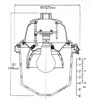
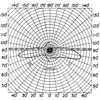 This lantern is of the totally-enclosed type and can be used with either Osram filament, or Osira discharge lamps
of small denomination. The body is of spun copper, with a reinforced top. Variable focuing is provided and the light distribution
is controlled by a small bowl refractor in combination with an inner symmetric dome refractor.
This lantern is of the totally-enclosed type and can be used with either Osram filament, or Osira discharge lamps
of small denomination. The body is of spun copper, with a reinforced top. Variable focuing is provided and the light distribution
is controlled by a small bowl refractor in combination with an inner symmetric dome refractor.
Side road lighting; 13-15 ft. mounting height; spacing 100-120 ft. for best results. Greater spacing will produce dark areas midway between
lanterns. Road width up to 30 ft. Also suitable for space or area lighting. Top entry. The lantern entry is ¾ in. gas. The lantern is locked to the
bracket by a ¼ in. Allen type grub screw. There are two lantern body ranges: All lanterns with the catalogue number Z.5543/5/6/7/8 have
a spun non-ferrous body, whilst those numbered Z.5555/6/7/8 have a die-cast light alloy body. An earthing screw is provided. The lampholder can be
B.C. or E.S. for use with an OSRAM lamp or three-slot BC for use with an OSRAM H.P.M.V. lamp. A G.E.S. holder is required only when 125 w. OSRAM H.P.M.V.
fluorescent lamp is used.
The lampholder is mounted on a movable bridge which slides on two metal rods. One is marked with
the correct focal position for the various wattages of lamp which can be used. The "Oxford" optical system consists of a symmetric dome "S" and a
prismatic bowl refractor "B". The light distribution is non-axial asymmetric and gives better results than are obtained with the "Wembley" distribution.
The bowl refractor carries prisms and flutes on its two surfaces which gives the necessary redirection and diffusion of light.
When the 80 w. or 125 w. OSRAM H.P.M.V. fluorescent lamp or 45 w. OSRAM sodium lamp is used no inner dome refractor is required. The inner reflector
in these lanterns is flat and not dome shaped as with the "Wembley" or "Oxford" lantern. The light alloy is
specially selected for its resistance to corrosion. Further protection is obtained by the use of a suitable
primer, undercoat and matt aluminium top coat.
|
|
Z5543B
|
125W MBF/V
|
GES
|
Top Entry
|
No Gear
|
1947 book
1948 catalogue
1951 book
|
|
Z5545SB
|
60-200W GLS
|
BC
|
Top Entry
|
No Gear
|
1947 book
1948 catalogue
1951 book
|
|
Z5546SB
|
80-125W MB/V
|
3BC
|
Top Entry
|
No Gear
|
1947 book
1948 catalogue
1948 catalogue
1951 book
|
|
Z5547SB
|
60-200W GLS
|
ES
|
Top Entry
|
No Gear
|
1947 book
1948 catalogue
1951 book
|
|
Z5548B
|
45W SO/V
|
BC
|
Top Entry
|
No Gear
|
1947 book
1948 catalogue
1951 book
|
|
Z5549B
|
80W MBF/V
|
3BC
|
Top Entry
|
No Gear
|
1947 book
1948 catalogue
1951 book
|
|
Z5555SB
|
60-200W GLS
|
BC
|
Top Entry
|
No Gear
|
1947 book
1948 catalogue
1951 book
|
|
Z5556SB
|
80-125W MB/V
|
3BC
|
Top Entry
|
No Gear
|
1947 book
1948 catalogue
1951 book
|
|
Z5557SB
|
60-200W GLS
|
ES
|
Top Entry
|
No Gear
|
1947 book
1948 catalogue
1951 book
|
|
Z5558B
|
45W SO/V
|
BC
|
Top Entry
|
No Gear
|
1947 book
1948 catalogue
1951 book
|
|
Z5559B
|
80W MBF/V
|
3BC
|
Top Entry
|
No Gear
|
1947 book
1948 catalogue
1951 book
|
|
|
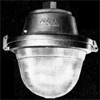
|
|
z????: plastifractor
|
|
Z????
|
60-150W GLS
80-125W MB/U
80-125W MBF/U
|
BC
|
Top Entry
|
No Gear
|
1956 advert
|
|
|

|
|
|
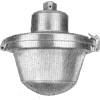
|
z 5580b/81b/81b/4/82b: | clearside 5580b/81b/81b/4/82b
Bowl: Z6606 or Z6644

 One of the "Clearside" range for Group B roads. Part of a family of lanterns with different
optical systems.
One of the "Clearside" range for Group B roads. Part of a family of lanterns with different
optical systems.
For side road lighting a bowl refractor should be fitted and the lanterns arranged at
13-15 ft. (3.98 - 4.57 m) mounting height; spaced 100-120 ft. (30.48 - 36.55 m) apart for
best results. Greater spacing will produce dark areas midway between lanterns. Road width
up to 30 ft.
Top entry tapped 3/4 in. B.S.P. The lantern is locked to the bracket by a 1/4 in. dia. Allen
type grub screw.
Die-cast light alloy body, approximately 10 in. dia. (254 mm). A die-cast light alloy ring,
hinged to the body and secured by a toggle catch, supports the enclosing bowl in use. The bowl
is held in the ring by stainless steel clips permitting quick and easy removal. Two special
synthetic rubber gaskets ensure a weatherproof seal when the lantern is closed. A cranked
bridge-piece attachable to various pairs of lugs within the lantern body provides adjustment
for the range of lamps that can be used.
The light alloy body is specially selected for its resistance to corrosion. Further protection is
obtained by the use of a special one-coat aluminium-finish stove enamel.
Fitted with either the Z6606 axial asymmetric prismatic glass shallow bowl refractor (common) or the
Z6644 four-beam distribution prismatic glass bowl refractor (for tree lined roads and extremely
rare). Weight: Z5580/1/2/ B: 7lb; Z5581 B/4: 7lb.
|
|
Z5580B
|
60-200W GLS
|
BC
|
Top Entry
|
No Gear
|
1960s catalogue
1961 catalogue
|
|
Z5581B
|
80-125W MBF/U
|
3BC
|
Top Entry
|
No Gear
|
1960s catalogue
1961 catalogue
|
|
Z5581B/4
|
80-125W MBF/U
|
3BC
|
Top Entry
|
No Gear
|
1960s catalogue
1961 catalogue
|
|
Z5582B
|
60-200W GLS
|
ES
|
Top Entry
|
No Gear
|
1960s catalogue
1961 catalogue
|
|
|
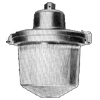
|
z 5580db/81db/82db | clearside 5580db/81db/82db
Bowl: Z6608
One of the "Clearside" range for Group B roads. Part of a family of lanterns with different
optical systems.
For side road lighting a bowl refractor should be fitted and the lanterns arranged at
13-15 ft. (3.98 - 4.57 m) mounting height; spaced 100-120 ft. (30.48 - 36.55 m) apart for
best results. Greater spacing will produce dark areas midway between lanterns. Road width
up to 30 ft.
Top entry tapped 3/4 in. B.S.P. The lantern is locked to the bracket by a 1/4 in. dia. Allen
type grub screw.
Die-cast light alloy body, approximately 10 in. dia. (254 mm). A die-cast light alloy ring,
hinged to the body and secured by a toggle catch, supports the enclosing bowl in use. The bowl
is held in the ring by stainless steel clips permitting quick and easy removal. Two special
synthetic rubber gaskets ensure a weatherproof seal when the lantern is closed. A cranked
bridge-piece attachable to various pairs of lugs within the lantern body provides adjustment
for the range of lamps that can be used.
The light alloy body is specially selected for its resistance to corrosion. Further protection is
obtained by the use of a special one-coat aluminium-finish stove enamel.
Fitted with the Z6608 axial asymmetric prismatic glass deep bowl refractor. Weight: Z5580/1/2/ DB: 10lb.
|
|
Z5580DB
|
60-200W GLS
45W SO/V
45W SOI/V
|
BC
|
Top Entry
|
No Gear
|
1960s catalogue
1961 catalogue
|
|
Z5581DB
|
80-125W MBF/U
|
3BC
|
Top Entry
|
No Gear
|
1960s catalogue
1961 catalogue
|
|
Z5582DB
|
60-200W GLS
|
ES
|
Top Entry
|
No Gear
|
1960s catalogue
1961 catalogue
|
|
|
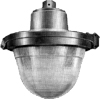
|
z 5580bp/81bp/82bp | clearside 5580bp/81bp/82bp
 Bowl: Z6708
Bowl: Z6708
One of the "Clearside" range for Group B roads. Part of a family of lanterns with different
optical systems.
For side road lighting a bowl refractor should be fitted and the lanterns arranged at
13-15 ft. (3.98 - 4.57 m) mounting height; spaced 100-120 ft. (30.48 - 36.55 m) apart for
best results. Greater spacing will produce dark areas midway between lanterns. Road width
up to 30 ft.
Top entry tapped 3/4 in. B.S.P. The lantern is locked to the bracket by a 1/4 in. dia. Allen
type grub screw.
Die-cast light alloy body, approximately 10 in. dia. (254 mm). A die-cast light alloy ring,
hinged to the body and secured by a toggle catch, supports the enclosing bowl in use. The bowl
is held in the ring by stainless steel clips permitting quick and easy removal. Two special
synthetic rubber gaskets ensure a weatherproof seal when the lantern is closed. A cranked
bridge-piece attachable to various pairs of lugs within the lantern body provides adjustment
for the range of lamps that can be used.
The light alloy body is specially selected for its resistance to corrosion. Further protection is
obtained by the use of a special one-coat aluminium-finish stove enamel.
Fitted with the Z6708 170° non-axial asymmetric injection moulded 'Diakon' bowl
refractor. Weight: Z5580/1/2/ BP: 4½lb.
|
|
Z5580BP
|
60-200W GLS
|
BC
|
Top Entry
|
No Gear
|
1960s catalogue
1961 catalogue
1970s catalogue
|
|
Z5581BP
|
80-125W MBF/U
|
3BC
|
Top Entry
|
No Gear
|
1960s catalogue
1961 catalogue
1970s catalogue
|
|
Z5582BP
|
60-200W GLS
|
ES
|
Top Entry
|
No Gear
|
1960s catalogue
1961 catalogue
1970s catalogue
|
|
|
|
z 5580o/81o/82o | clearside 5580o/81o/82o
Bowl: Z6466
One of the "Clearside" range for Group B roads. Part of a family of lanterns with different
optical systems.
For side road lighting a bowl refractor should be fitted and the lanterns arranged at
13-15 ft. (3.98 - 4.57 m) mounting height; spaced 100-120 ft. (30.48 - 36.55 m) apart for
best results. Greater spacing will produce dark areas midway between lanterns. Road width
up to 30 ft.
Top entry tapped 3/4 in. B.S.P. The lantern is locked to the bracket by a 1/4 in. dia. Allen
type grub screw.
Die-cast light alloy body, approximately 10 in. dia. (254 mm). A die-cast light alloy ring,
hinged to the body and secured by a toggle catch, supports the enclosing bowl in use. The bowl
is held in the ring by stainless steel clips permitting quick and easy removal. Two special
synthetic rubber gaskets ensure a weatherproof seal when the lantern is closed. A cranked
bridge-piece attachable to various pairs of lugs within the lantern body provides adjustment
for the range of lamps that can be used.
The light alloy body is specially selected for its resistance to corrosion. Further protection is
obtained by the use of a special one-coat aluminium-finish stove enamel.
Fitted with the Z6466 stepped opal glass diffusing outer globe.
Weight: Z5580/1/2/ O: 5lb
|
|
Z5580O
|
60-200W GLS
|
BC
|
Top Entry
|
No Gear
|
1960s catalogue
1961 catalogue
|
|
Z5581O
|
80-125W MBF/U
|
3BC
|
Top Entry
|
No Gear
|
1960s catalogue
1961 catalogue
|
|
Z5582O
|
60-200W GLS
|
ES
|
Top Entry
|
No Gear
|
1960s catalogue
1961 catalogue
|
|
|
|
z 5580r/81r/82r | clearside 5580r/81r/82r
Bowl: Z6475
One of the "Clearside" range for Group B roads. Part of a family of lanterns with different
optical systems.
For side road lighting a bowl refractor should be fitted and the lanterns arranged at
13-15 ft. (3.98 - 4.57 m) mounting height; spaced 100-120 ft. (30.48 - 36.55 m) apart for
best results. Greater spacing will produce dark areas midway between lanterns. Road width
up to 30 ft.
Top entry tapped 3/4 in. B.S.P. The lantern is locked to the bracket by a 1/4 in. dia. Allen
type grub screw.
Die-cast light alloy body, approximately 10 in. dia. (254 mm). A die-cast light alloy ring,
hinged to the body and secured by a toggle catch, supports the enclosing bowl in use. The bowl
is held in the ring by stainless steel clips permitting quick and easy removal. Two special
synthetic rubber gaskets ensure a weatherproof seal when the lantern is closed. A cranked
bridge-piece attachable to various pairs of lugs within the lantern body provides adjustment
for the range of lamps that can be used.
The light alloy body is specially selected for its resistance to corrosion. Further protection is
obtained by the use of a special one-coat aluminium-finish stove enamel.
Fitted with the Z6475 rimpled glass diffusing outer globe.
Weight: Z5580/1/2/ R: 6lb
|
|
Z5580R
|
60-200W GLS
|
BC
|
Top Entry
|
No Gear
|
1960s catalogue
1961 catalogue
|
|
Z5581R
|
80-125W MBF/U
|
3BC
|
Top Entry
|
No Gear
|
1960s catalogue
1961 catalogue
|
|
Z5582R
|
60-200W GLS
|
ES
|
Top Entry
|
No Gear
|
1960s catalogue
1961 catalogue
|
|
|
|
z 5580rp/81rp/82rp | clearside 5580rp/81rp/82rp
Bowl: Z6775
One of the "Clearside" range for Group B roads. Part of a family of lanterns with different
optical systems.
For side road lighting a bowl refractor should be fitted and the lanterns arranged at
13-15 ft. (3.98 - 4.57 m) mounting height; spaced 100-120 ft. (30.48 - 36.55 m) apart for
best results. Greater spacing will produce dark areas midway between lanterns. Road width
up to 30 ft.
Top entry tapped 3/4 in. B.S.P. The lantern is locked to the bracket by a 1/4 in. dia. Allen
type grub screw.
Die-cast light alloy body, approximately 10 in. dia. (254 mm). A die-cast light alloy ring,
hinged to the body and secured by a toggle catch, supports the enclosing bowl in use. The bowl
is held in the ring by stainless steel clips permitting quick and easy removal. Two special
synthetic rubber gaskets ensure a weatherproof seal when the lantern is closed. A cranked
bridge-piece attachable to various pairs of lugs within the lantern body provides adjustment
for the range of lamps that can be used.
The light alloy body is specially selected for its resistance to corrosion. Further protection is
obtained by the use of a special one-coat aluminium-finish stove enamel.
Fitted with the Z6775 rimpled 'Perspex' diffusing outer globe.
Weight: Z5580/1/2/ RP: 4lb
|
|
Z5580RP
|
60-200W GLS
|
BC
|
Top Entry
|
No Gear
|
1960s catalogue
1961 catalogue
|
|
Z5581RP
|
80-125W MBF/U
|
3BC
|
Top Entry
|
No Gear
|
1960s catalogue
1961 catalogue
|
|
Z5582RP
|
60-200W GLS
|
ES
|
Top Entry
|
No Gear
|
1960s catalogue
1961 catalogue
|
|
|
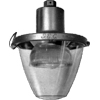
|
z 5590*p/1*p/2*p/9*p | clearside 5590*p/1*p/2*p/9*p
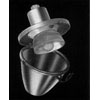
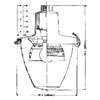 Refractor: Z6502, Z6508 or Z6514
Refractor: Z6502, Z6508 or Z6514
Bowl: Z 6768 or Z 6798 (unbreakable)
One of the "Clearside" range for Group B roads. Part of a family of lanterns with different
optical systems.
For side road lighting, M.O.T. Group 'B' roads, mounting height 13-18 ft., road widths
30-40 ft.
Top entry, requires 1 in. of threaded ¾ in. B.S.P. When fully home the pipe is gripped by a
¼ in. diameter Allen type grub-screw.
Die-cast aluminium alloy. The lampholder is fitted to an adjustable bridge piece which fits on bosses
located in the top of the lantern. A dome refractor fits on to a white enamelled refractor plate and
is secured by two springs. The outer glassware is secured in a die-cast ring of the same material as the
body and is fastened to the main casting by a hinge and a toggle catch, both of stainless steel. A tropicalised
felt gasket is fitted in the lower rim of the lantern body, and when the lantern is closed this makes a weatherproof
joint with the rim of the bowl.
Uses the Wembley optical system. A single piece prismatic glass dome refactor controls
the light distribution, of which three forms are available: (1) Symmetrical all-round distribution
with Z6502 (ref. letter 'S') dome refractor; (2) 160° non-axial asymmetric, main light output
up and down the street just away from the kerb with Z6508 (ref. letter 'N') dome refractor; (3)
Axial asymmetric, main light output directed up and down the street, with Z6514 (ref. letter 'A')
dome refractor.
Fitted with the clear Diakon globe Z6768 (ref. letter 'P') or unbreakable Diakon globe Z6798.
The light alloy body is specially selected for its resistance to corrosion. Further protection is
obtained by the use of a suitable primer, undercoat and matt aluminium finish top coat.
|
Z5590SP
Z5590NP
Z5590AP
|
60-200W GLS
|
BC
|
Top Entry
|
No Gear
|
1960s catalogue
1961 catalogue
1970s catalogue
1979 catalogue
|
Z5591SP
Z5591NP
Z5591AP
|
80-125W MB/U
|
3BC
|
Top Entry
|
No Gear
|
1960s catalogue
1961 catalogue
1970s catalogue
1979 catalogue
|
Z5592SP
Z5592NP
Z5592AP
|
60-200W GLS
|
ES
|
Top Entry
|
No Gear
|
1960s catalogue
1961 catalogue
1970s catalogue
1979 catalogue
|
Z5599SP
Z5599NP
Z5599AP
|
80-125W MBF/U
|
3BC
|
Top Entry
|
No Gear
|
1960s catalogue
1961 catalogue
1970s catalogue
1979 catalogue
|
|
|
|
z 5590*c/1*c/2*c/9*c | clearside 5590*p/1*p/2*p/9*c
Refractor: Z6502, Z6508 or Z6514
Bowl: Z 6465
One of the "Clearside" range for Group B roads. Part of a family of lanterns with different
optical systems.
For side road lighting, M.O.T. Group 'B' roads, mounting height 13-18 ft., road widths
30-40 ft.
Top entry, requires 1 in. of threaded ¾ in. B.S.P. When fully home the pipe is gripped by a
¼ in. diameter Allen type grub-screw.
Die-cast aluminium alloy. The lampholder is fitted to an adjustable bridge piece which fits on bosses
located in the top of the lantern. A dome refractor fits on to a white enamelled refractor plate and
is secured by two springs. The outer glassware is secured in a die-cast ring of the same material as the
body and is fastened to the main casting by a hinge and a toggle catch, both of stainless steel. A tropicalised
felt gasket is fitted in the lower rim of the lantern body, and when the lantern is closed this makes a weatherproof
joint with the rim of the bowl.
Uses the Wembley optical system. A single piece prismatic glass dome refactor controls
the light distribution, of which three forms are available: (1) Symmetrical all-round distribution
with Z6502 (ref. letter 'S') dome refractor; (2) 160° non-axial asymmetric, main light output
up and down the street just away from the kerb with Z6508 (ref. letter 'N') dome refractor; (3)
Axial asymmetric, main light output directed up and down the street, with Z6514 (ref. letter 'A')
dome refractor.
Fitted with the clear glass globe Z6465 (ref. letter 'C').
The light alloy body is specially selected for its resistance to corrosion. Further protection is
obtained by the use of a suitable primer, undercoat and matt aluminium finish top coat.
|
Z5590SC
Z5590NC
Z5590AC
|
60-200W GLS
|
BC
|
Top Entry
|
No Gear
|
1960s catalogue
1961 catalogue
1970s catalogue
1979 catalogue
|
Z5591SC
Z5591NC
Z5591AC
|
80-125W MB/U
|
3BC
|
Top Entry
|
No Gear
|
1960s catalogue
1961 catalogue
1970s catalogue
1979 catalogue
|
Z5592SC
Z5592NC
Z5592AC
|
60-200W GLS
|
ES
|
Top Entry
|
No Gear
|
1960s catalogue
1961 catalogue
1970s catalogue
1979 catalogue
|
Z5599SC
Z5599NC
Z5599AC
|
80-125W MBF/U
|
3BC
|
Top Entry
|
No Gear
|
1960s catalogue
1961 catalogue
1970s catalogue
1979 catalogue
|
|
|
|
|
z 5590*rp/1*rp/2*rp/9*rp | clearside 5590*rp/1*rp/2*rp/9*rp
Refractor: Z6502, Z6508 or Z6514
Bowl: Z 6775
One of the "Clearside" range for Group B roads. Part of a family of lanterns with different
optical systems.
For side road lighting, M.O.T. Group 'B' roads, mounting height 13-18 ft., road widths
30-40 ft.
Top entry, requires 1 in. of threaded ¾ in. B.S.P. When fully home the pipe is gripped by a
¼ in. diameter Allen type grub-screw.
Die-cast aluminium alloy. The lampholder is fitted to an adjustable bridge piece which fits on bosses
located in the top of the lantern. A dome refractor fits on to a white enamelled refractor plate and
is secured by two springs. The outer glassware is secured in a die-cast ring of the same material as the
body and is fastened to the main casting by a hinge and a toggle catch, both of stainless steel. A tropicalised
felt gasket is fitted in the lower rim of the lantern body, and when the lantern is closed this makes a weatherproof
joint with the rim of the bowl.
Uses the Wembley optical system. A single piece prismatic glass dome refactor controls
the light distribution, of which three forms are available: (1) Symmetrical all-round distribution
with Z6502 (ref. letter 'S') dome refractor; (2) 160° non-axial asymmetric, main light output
up and down the street just away from the kerb with Z6508 (ref. letter 'N') dome refractor; (3)
Axial asymmetric, main light output directed up and down the street, with Z6514 (ref. letter 'A')
dome refractor.
Fitted with the rimpled Perspex globe Z6775 (ref. letter 'RP').
The light alloy body is specially selected for its resistance to corrosion. Further protection is
obtained by the use of a suitable primer, undercoat and matt aluminium finish top coat.
|
Z5590SRP
Z5590NRP
Z5590ARP
|
60-200W GLS
|
BC
|
Top Entry
|
No Gear
|
1960s catalogue
1961 catalogue
1970s catalogue
1979 catalogue
|
Z5591SRP
Z5591NRP
Z5591ARP
|
80-125W MB/U
|
3BC
|
Top Entry
|
No Gear
|
1960s catalogue
1961 catalogue
1970s catalogue
1979 catalogue
|
Z5592SRP
Z5592NRP
Z5592ARP
|
60-200W GLS
|
ES
|
Top Entry
|
No Gear
|
1960s catalogue
1961 catalogue
1970s catalogue
1979 catalogue
|
Z5599SRP
Z5599NRP
Z5599ARP
|
80-125W MBF/U
|
3BC
|
Top Entry
|
No Gear
|
1960s catalogue
1961 catalogue
1970s catalogue
1979 catalogue
|
|
|
|
|
z 5590*r/1*r/2*r/9*r | clearside 5590*r/1*r/2*r/9*r
Refractor: Z6502, Z6508 or Z6514
Bowl: Z 6475
One of the "Clearside" range for Group B roads. Part of a family of lanterns with different
optical systems.
For side road lighting, M.O.T. Group 'B' roads, mounting height 13-18 ft., road widths
30-40 ft.
Top entry, requires 1 in. of threaded ¾ in. B.S.P. When fully home the pipe is gripped by a
¼ in. diameter Allen type grub-screw.
Die-cast aluminium alloy. The lampholder is fitted to an adjustable bridge piece which fits on bosses
located in the top of the lantern. A dome refractor fits on to a white enamelled refractor plate and
is secured by two springs. The outer glassware is secured in a die-cast ring of the same material as the
body and is fastened to the main casting by a hinge and a toggle catch, both of stainless steel. A tropicalised
felt gasket is fitted in the lower rim of the lantern body, and when the lantern is closed this makes a weatherproof
joint with the rim of the bowl.
Uses the Wembley optical system. A single piece prismatic glass dome refactor controls
the light distribution, of which three forms are available: (1) Symmetrical all-round distribution
with Z6502 (ref. letter 'S') dome refractor; (2) 160° non-axial asymmetric, main light output
up and down the street just away from the kerb with Z6508 (ref. letter 'N') dome refractor; (3)
Axial asymmetric, main light output directed up and down the street, with Z6514 (ref. letter 'A')
dome refractor.
Fitted with the rimpled Perspex globe Z6475 (ref. letter 'R').
The light alloy body is specially selected for its resistance to corrosion. Further protection is
obtained by the use of a suitable primer, undercoat and matt aluminium finish top coat.
|
Z5590SR
Z5590NR
Z5590AR
|
60-200W GLS
|
BC
|
Top Entry
|
No Gear
|
1960s catalogue
1961 catalogue
1970s catalogue
1979 catalogue
|
Z5591SR
Z5591NR
Z5591AR
|
80-125W MB/U
|
3BC
|
Top Entry
|
No Gear
|
1960s catalogue
1961 catalogue
1970s catalogue
1979 catalogue
|
Z5592SR
Z5592NR
Z5592AR
|
60-200W GLS
|
ES
|
Top Entry
|
No Gear
|
1960s catalogue
1961 catalogue
1970s catalogue
1979 catalogue
|
Z5599SR
Z5599NR
Z5599AR
|
80-125W MBF/U
|
3BC
|
Top Entry
|
No Gear
|
1960s catalogue
1961 catalogue
1970s catalogue
1979 catalogue
|
|
|
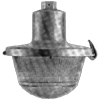
|
z 5590sb/1sb/2sb/9sb | clearside 5590sb/1sb/2sb/9sb
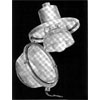
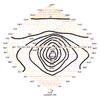 Refractor: Z 6502
Refractor: Z 6502
Bowl: Z 6605
One of the "Clearside" range for Group B roads. Part of a family of lanterns with different
optical systems.
For side road lighting, M.O.T. Group 'B' roads, mounting height 13-18 ft., road widths
30-40 ft.
Top entry, requires 1 in. of threaded ¾ in. B.S.P. When fully home the pipe is gripped by a
¼ in. diameter Allen type grub-screw.
Die-cast aluminium alloy. The lampholder is fitted to an adjustable bridge piece which fits on bosses
located in the top of the lantern. A dome refractor fits on to a white enamelled refractor plate and
is secured by two springs. The outer glassware is secured in a die-cast ring of the same material as the
body and is fastened to the main casting by a hinge and a toggle catch, both of stainless steel. A tropicalised
felt gasket is fitted in the lower rim of the lantern body, and when the lantern is closed this makes a weatherproof
joint with the rim of the bowl.
Uses the Oxford optical system. This consists of a Z 6502 symmetric prismatic glass dome refractor
(ref. letter 'S') and a Z 6605 prismatic glass shallow bowl refractor (ref. letter 'B'). The
light distribution is 170° non-axial asymmetric and gives better results than are obtained with
the Wembley distribution. The bowl refractor carries curved prisms on its interior surface
which give the necessary redirection and diffusion of light. The exterior is smooth.
The light alloy body is specially selected for its resistance to corrosion. Further protection is
obtained by the use of a suitable primer, undercoat and matt aluminium finish top coat.
|
Z5590SB
|
60-200W GLS
|
BC
|
Top Entry
|
No Gear
|
1960s catalogue
1961 catalogue
1970s catalogue
1979 catalogue
|
Z5591SB
|
80-125W MB/U
|
3BC
|
Top Entry
|
No Gear
|
1960s catalogue
1961 catalogue
1970s catalogue
1979 catalogue
|
Z5592SB
|
60-200W GLS
|
ES
|
Top Entry
|
No Gear
|
1960s catalogue
1961 catalogue
1970s catalogue
1979 catalogue
|
Z5599SB
|
80-125W MBF/U
|
3BC
|
Top Entry
|
No Gear
|
1960s catalogue
1961 catalogue
1970s catalogue
1979 catalogue
|
|
|

|
z 5591sb/4 | clearside 5591sb/4
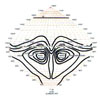
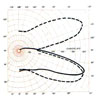 Refractor: Z 6502
Refractor: Z 6502
Bowl: Z 6644
One of the "Clearside" range for Group B roads. Part of a family of lanterns with different
optical systems.
For side road lighting, M.O.T. Group 'B' roads, mounting height 13-18 ft., road widths
30-40 ft.
Top entry, requires 1 in. of threaded ¾ in. B.S.P. When fully home the pipe is gripped by a
¼ in. diameter Allen type grub-screw.
Die-cast aluminium alloy. The lampholder is fitted to an adjustable bridge piece which fits on bosses
located in the top of the lantern. A dome refractor fits on to a white enamelled refractor plate and
is secured by two springs. The outer glassware is secured in a die-cast ring of the same material as the
body and is fastened to the main casting by a hinge and a toggle catch, both of stainless steel. A tropicalised
felt gasket is fitted in the lower rim of the lantern body, and when the lantern is closed this makes a weatherproof
joint with the rim of the bowl.
Uses the Oxford optical system. This consists of a Z 6502 symmetric prismatic glass dome refractor
(ref. letter 'S') and a Z 6644 prismatic glass shallow bowl refractor (ref. letter 'B/4'). The
Z 6604, which has a 'four way' distribution, should be
used if the road is tree lined or if the lighting is intended primarily for pedestrians. It is
particularly effective in residential side roads. The bowl refractor carries curved prisms on its interior surface
which give the necessary redirection and diffusion of light. The exterior is smooth.
The light alloy body is specially selected for its resistance to corrosion. Further protection is
obtained by the use of a suitable primer, undercoat and matt aluminium finish top coat.
|
Z5591SB/4
|
80-125W MB/U
|
3BC
|
Top Entry
|
No Gear
|
1960s catalogue
1961 catalogue
1970s catalogue
1979 catalogue
|
|
|
|
|
z 5590db/1db/2db/8db/9db | clearside 5590db/1db/2db/8db/9db
Refractor: Z 6502
Bowl: Z 6608
One of the "Clearside" range for Group B roads. Part of a family of lanterns with different
optical systems.
For side road lighting, M.O.T. Group 'B' roads, mounting height 13-18 ft., road widths
30-40 ft.
Top entry, requires 1 in. of threaded ¾ in. B.S.P. When fully home the pipe is gripped by a
¼ in. diameter Allen type grub-screw.
Die-cast aluminium alloy. The lampholder is fitted to an adjustable bridge piece which fits on bosses
located in the top of the lantern. A dome refractor fits on to a white enamelled refractor plate and
is secured by two springs. The outer glassware is secured in a die-cast ring of the same material as the
body and is fastened to the main casting by a hinge and a toggle catch, both of stainless steel. A tropicalised
felt gasket is fitted in the lower rim of the lantern body, and when the lantern is closed this makes a weatherproof
joint with the rim of the bowl.
Uses the Oxford optical system. This consists of a Z 6502 symmetric prismatic glass dome refractor
(ref. letter 'S') and a Z 6608 prismatic glass deep bowl refractor (ref. letter 'DB'). The
light distribution is 170° non-axial asymmetric and gives better results than are obtained with
the Wembley distribution. The bowl refractor carries curved prisms on its interior surface
which give the necessary redirection and diffusion of light. The exterior is smooth.
The light alloy body is specially selected for its resistance to corrosion. Further protection is
obtained by the use of a suitable primer, undercoat and matt aluminium finish top coat.
|
Z5590DB
|
60-200W GLS
|
BC
|
Top Entry
|
No Gear
|
1960s catalogue
1961 catalogue
1970s catalogue
1979 catalogue
|
Z5591DB
|
80-125W MB/U
|
3BC
|
Top Entry
|
No Gear
|
1960s catalogue
1961 catalogue
1970s catalogue
1979 catalogue
|
Z5592DB
|
60-200W GLS
|
ES
|
Top Entry
|
No Gear
|
1960s catalogue
1961 catalogue
1970s catalogue
1979 catalogue
|
Z5598DB
|
45W SO/V
|
BC
|
Top Entry
|
No Gear
|
1960s catalogue
1961 catalogue
1970s catalogue
1979 catalogue
|
Z5599DB
|
80-125W MBF/U
|
3BC
|
Top Entry
|
No Gear
|
1960s catalogue
1961 catalogue
1970s catalogue
1979 catalogue
|
|
|
|
|
z 5590o/1o/2o/9o | clearside 5590o/1o/2o/9o
Bowl: Z 6466
One of the "Clearside" range for Group B roads. Part of a family of lanterns with different
optical systems.
For side road lighting, M.O.T. Group 'B' roads, mounting height 13-18 ft., road widths
30-40 ft.
Top entry, requires 1 in. of threaded ¾ in. B.S.P. When fully home the pipe is gripped by a
¼ in. diameter Allen type grub-screw.
Die-cast aluminium alloy. The lampholder is fitted to an adjustable bridge piece which fits on bosses
located in the top of the lantern. The outer glassware is secured in a die-cast ring of the same material as the
body and is fastened to the main casting by a hinge and a toggle catch, both of stainless steel. A tropicalised
felt gasket is fitted in the lower rim of the lantern body, and when the lantern is closed this makes a weatherproof
joint with the rim of the bowl.
For general lighting of an area, such as a court. No dome refractor is necessary. The stepped opal
globe Z 6466 should be used.
The light alloy body is specially selected for its resistance to corrosion. Further protection is
obtained by the use of a suitable primer, undercoat and matt aluminium finish top coat.
|
Z5590O
|
60-200W GLS
|
BC
|
Top Entry
|
No Gear
|
1960s catalogue
1961 catalogue
1970s catalogue
1979 catalogue
|
Z5591O
|
80-125W MB/U
|
3BC
|
Top Entry
|
No Gear
|
1960s catalogue
1961 catalogue
1970s catalogue
1979 catalogue
|
Z5592O
|
60-200W GLS
|
ES
|
Top Entry
|
No Gear
|
1960s catalogue
1961 catalogue
1970s catalogue
1979 catalogue
|
Z5599O
|
80-125W MBF/U
|
3BC
|
Top Entry
|
No Gear
|
1960s catalogue
1961 catalogue
1970s catalogue
1979 catalogue
|
|
|
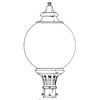
|
|
z 5601: paisley (round type)
Previously sold as the F 5247/8 Paisley.
This lantern is particularly suitable for residential districts and combines efficiency with ornamental design.
|
|
Z5601
|
300W GLS
|
GES
|
Post Top
|
No Gear
|
1937 catalogue
|
|
|
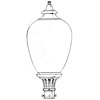
|
z 5602: paisley (pear type)
This lantern is particularly suitable for residential districts and combines efficiency with ornamental design.
|
|
Z5602
|
300-500W GLS
|
GES
|
Post Top
|
No Gear
|
1937 catalogue
|
|
|
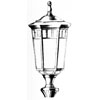
|
z 5610
The decorative lighting units illustrated on this and the following page have been specially designed
by the G.E.C. Exterior Lighting Department. Units incorporating coats of arms, crests or other requirements
can be designed to order. They include G.E.C. British-made prismatic glass refractors and low absorption
diffusing panels.
|
|
Z5610
|
???W GLS
|
???
|
Post Top
|
No Gear
|
1937 catalogue
|
|
|
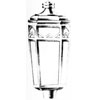
|
z 5611
The decorative lighting units illustrated on this and the following page have been specially designed
by the G.E.C. Exterior Lighting Department. Units incorporating coats of arms, crests or other requirements
can be designed to order. They include G.E.C. British-made prismatic glass refractors and low absorption
diffusing panels.
|
|
Z5611
|
???W GLS
|
???
|
Post Top
|
No Gear
|
1937 catalogue
|
|
|
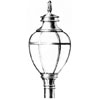
|
z 5612
The decorative lighting units illustrated on this and the following page have been specially designed
by the G.E.C. Exterior Lighting Department. Units incorporating coats of arms, crests or other requirements
can be designed to order. They include G.E.C. British-made prismatic glass refractors and low absorption
diffusing panels.
|
|
Z5612
|
???W GLS
|
???
|
Post Top
|
No Gear
|
1937 catalogue
|
|
|
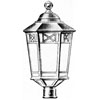
|
z 5613
The decorative lighting units illustrated on this and the following page have been specially designed
by the G.E.C. Exterior Lighting Department. Units incorporating coats of arms, crests or other requirements
can be designed to order. They include G.E.C. British-made prismatic glass refractors and low absorption
diffusing panels.
|
|
Z5613
|
???W GLS
|
???
|
Post Top
|
No Gear
|
1937 catalogue
|
|
|
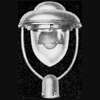
|
|
|
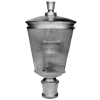
|
|
|
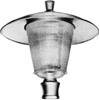
|
|
|
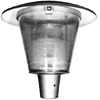
|
z 5670s/71s/72s/78s/79s | clearside z 5670s/71s/72s/78s/79s
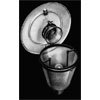
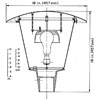 Refractor: Z 6502
Refractor: Z 6502
Cone: Z 6701
One of the "Clearside" range for Group B roads.
For side road lighting, 13-15 ft (3.96-4.57 m) mounting height, spacing
100-120 ft (30.48-36.58 m) for best results. Road width up to
30 ft (9.14 m). This lantern is also very suitable for decorative garden,
promenade and balustrade lighting, new housing estates, space lighting
in front of offices, blocks of flats and halls.
Post top spigot cap for a 3 in. (76.2 mm) diameter x 3 in. (76.2 mm) high spigot. The lantern
is secured by three 7/16 in. diameter Allen-type grub screws in the spigot cap.
The lantern can be supplied with a collar insert for the spigot cap to fit a 2.3/8 in. diameter
spigot. This must be specified when ordering.
The body consists of a truncated moulded "Diakon" cone held between a cast aluminium base incorporating
the spigot cap, and a die-cast light alloy upper rim.
Two vertical rods join the base to the upper rim. A casting which slides on these rods carries the lampholder.
This enables the lantern to be focused for the full range of lamp wattages shown.
The light aluminium cast top canopy is hinged to the upper rim and secured when closed by a quick release
stainless steel toggle catch. The prismatic glass dome refractor is secured to its supporting plate by
spring clips. The plate is held in position by two short vertical rods screwed into the lantern canopy.
The lantern body is fitted with a terminal block, cable cleat and earthing screw. Two heat-resisting leads
are wired to the terminal block for connecting to the lampholder. The lampholder is supplied separately.
A dome refractor controls the light distribution. A symmetric all-round distribution is availble with
the Z6502 (ref. letter 'S') dome refractor.
The lantern weighs 12lb (5.4 kg).
The alloy used is specially selected for its resistance to corrosion and is processed to give
a pleasing apperance.
|
|
Z5670S
|
60-200W GLS
|
BC
|
Post Top
|
No Gear
|
1960s catalogue
1964 catalogue
1970s catalogue
1974 catalogue
1979 catalogue
|
|
Z5671S
|
80-125W MB/U
80-125W MBF/U
|
3BC
|
Post Top
|
No Gear
|
1960s catalogue
1964 catalogue
1970s catalogue
1974 catalogue
1979 catalogue
|
|
Z5672S
|
60-200W GLS
80-125W MBF/U
50-70-120W SON
|
ES
|
Post Top
|
No Gear
|
1960s catalogue
1970s catalogue
1974 catalogue
1979 catalogue
|
|
Z5678S
|
45-60W SOI/H
40W SOX
35W SOX
|
BC
|
Post Top
|
No Gear
|
1960s catalogue
1964 catalogue
1974 catalogue
1979 catalogue
|
|
Z5679S
|
80-125W MB/U
80-125W MBF/U
|
3BC
|
Post Top
|
No Gear
|
1960s catalogue
1964 catalogue
1979 catalogue
|
|
|

|
z 5670n/71n/72n/78n/79n | clearspace z 5670n/71n/72n/78n/79n


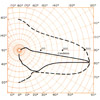 Refractor: Z 6508
Refractor: Z 6508
Cone: Z 6701
One of the "Clearside" range for Group B roads.
For side road lighting, 13-15 ft (3.96-4.57 m) mounting height, spacing
100-120 ft (30.48-36.58 m) for best results. Road width up to
30 ft (9.14 m). This lantern is also very suitable for decorative garden,
promenade and balustrade lighting, new housing estates, space lighting
in front of offices, blocks of flats and halls.
Post top spigot cap for a 3 in. (76.2 mm) diameter x 3 in. (76.2 mm) high spigot. The lantern
is secured by three 7/16 in. diameter Allen-type grub screws in the spigot cap.
The lantern can be supplied with a collar insert for the spigot cap to fit a 2.3/8 in. diameter
spigot. This must be specified when ordering.
The body consists of a truncated moulded "Diakon" cone held between a cast aluminium base incorporating
the spigot cap, and a die-cast light alloy upper rim.
Two vertical rods join the base to the upper rim. A casting which slides on these rods carries the lampholder.
This enables the lantern to be focused for the full range of lamp wattages shown.
The light aluminium cast top canopy is hinged to the upper rim and secured when closed by a quick release
stainless steel toggle catch. The prismatic glass dome refractor is secured to its supporting plate by
spring clips. The plate is held in position by two short vertical rods screwed into the lantern canopy.
The lantern body is fitted with a terminal block, cable cleat and earthing screw. Two heat-resisting leads
are wired to the terminal block for connecting to the lampholder. The lampholder is supplied separately.
A dome refractor controls the light distribution. A 160° non-axial asymmetric distribution is availble with
the Z6508 (ref. letter 'N') dome refractor.
The lantern weighs 12lb (5.4 kg).
The alloy used is specially selected for its resistance to corrosion and is processed to give
a pleasing apperance.
|
|
Z5670N
|
60-200W GLS
|
BC
|
Post Top
|
No Gear
|
1960s catalogue
1964 catalogue
1970s catalogue
1974 catalogue
1979 catalogue
|
|
Z5671N
|
80-125W MB/U
80-125W MBF/U
|
3BC
|
Post Top
|
No Gear
|
1960s catalogue
1964 catalogue
1970s catalogue
1974 catalogue
1979 catalogue
|
|
Z5672N
|
60-200W GLS
80-125W MBF/U
50-70-120W SON
|
ES
|
Post Top
|
No Gear
|
1960s catalogue
1970s catalogue
1974 catalogue
1979 catalogue
|
|
Z5678N
|
45-60W SOI/H
40W SOX
35W SOX
|
BC
|
Post Top
|
No Gear
|
1960s catalogue
1964 catalogue
1974 catalogue
1979 catalogue
|
|
Z5679N
|
80-125W MB/U
80-125W MBF/U
|
3BC
|
Post Top
|
No Gear
|
1960s catalogue
1964 catalogue
1979 catalogue
|
|
|

|
z 5670a/71a/72a/78a/79a | clearspace z 5670a/71a/72a/78a/79a


 Refractor: Z 6514
Refractor: Z 6514
Cone: Z 6701
One of the "Clearside" range for Group B roads.
For side road lighting, 13-15 ft (3.96-4.57 m) mounting height, spacing
100-120 ft (30.48-36.58 m) for best results. Road width up to
30 ft (9.14 m). This lantern is also very suitable for decorative garden,
promenade and balustrade lighting, new housing estates, space lighting
in front of offices, blocks of flats and halls.
Post top spigot cap for a 3 in. (76.2 mm) diameter x 3 in. (76.2 mm) high spigot. The lantern
is secured by three 7/16 in. diameter Allen-type grub screws in the spigot cap.
The lantern can be supplied with a collar insert for the spigot cap to fit a 2.3/8 in. diameter
spigot. This must be specified when ordering.
The body consists of a truncated moulded "Diakon" cone held between a cast aluminium base incorporating
the spigot cap, and a die-cast light alloy upper rim.
Two vertical rods join the base to the upper rim. A casting which slides on these rods carries the lampholder.
This enables the lantern to be focused for the full range of lamp wattages shown.
The light aluminium cast top canopy is hinged to the upper rim and secured when closed by a quick release
stainless steel toggle catch. The prismatic glass dome refractor is secured to its supporting plate by
spring clips. The plate is held in position by two short vertical rods screwed into the lantern canopy.
The lantern body is fitted with a terminal block, cable cleat and earthing screw. Two heat-resisting leads
are wired to the terminal block for connecting to the lampholder. The lampholder is supplied separately.
A dome refractor controls the light distribution. An axial asymmetric distribution is availble with
the Z6514 (ref. letter 'A') dome refractor.
The lantern weighs 12lb (5.4 kg).
The alloy used is specially selected for its resistance to corrosion and is processed to give
a pleasing apperance.
|
|
Z5670A
|
60-200W GLS
|
BC
|
Post Top
|
No Gear
|
1960s catalogue
1964 catalogue
1970s catalogue
1974 catalogue
1979 catalogue
|
|
Z5671A
|
80-125W MB/U
80-125W MBF/U
|
3BC
|
Post Top
|
No Gear
|
1960s catalogue
1964 catalogue
1970s catalogue
1974 catalogue
1979 catalogue
|
|
Z5672A
|
60-200W GLS
80-125W MBF/U
50-70-120W SON
|
ES
|
Post Top
|
No Gear
|
1960s catalogue
1970s catalogue
1974 catalogue
1979 catalogue
|
|
Z5678A
|
45-60W SOI/H
40W SOX
35W SOX
|
BC
|
Post Top
|
No Gear
|
1960s catalogue
1964 catalogue
1974 catalogue
1979 catalogue
|
|
Z5679A
|
80-125W MB/U
80-125W MBF/U
|
3BC
|
Post Top
|
No Gear
|
1960s catalogue
1964 catalogue
1979 catalogue
|
|
|
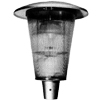
|
z 5673s/74s/75s/76s/77s | clearside 5673s/74s/75s/76s/77s
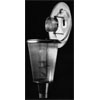
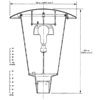 Refractor: Z 6502
Refractor: Z 6502
Cone: Z 6819
One of the "Clearside" range for Group B roads.
Side road lighting, 13-15 ft (3.96-4.57 m) mounting height, spacing
100-120 ft (30.48-36.58 m) for best results. Road width up to
30 ft (9.14 m). This lantern is also very suitable for decorative garden,
promenade and balustrade lighting, new housing estates, space lighting
in front of offices, blocks of flats and halls.
Post top spigot cap for a 3 in. (76.2 mm) diameter x 3 in. (76.2 mm) high spigot. The lantern
is secured by three 7/16 in. diameter Allen-type grub screws in the spigot cap.
The lantern can be supplied with a collar insert for the spigot cap to fit a 2.3/8 in. diameter
spigot. This must be specified when ordering.
The body consists of a truncated moulded "Diakon" cone held between a cast aluminium base incorporating
the spigot cap, and a die-cast light alloy upper rim.
Two vertical rods join the base to the upper rim. A casting which slides on these rods carries the lampholder.
This enables the lantern to be focused for the full range of lamp wattages shown.
The light aluminium cast top canopy is hinged to the upper rim and secured when closed by a quick release
stainless steel toggle catch. The prismatic glass dome refractor is secured to its supporting plate by
spring clips. The plate is held in position by two short vertical rods screwed into the top canopy.
The lantern body is fitted with a terminal block, cable cleat and earthing screw. Two heat-resisting leads
are wired to the terminal block for connecting to the lampholder. The lampholder is supplied separately.
A dome refractor controls the light distribution. A symmetric all-round distribution is availble with
the Z6502 (ref. letter 'S') dome refractor.
The lantern weighs 14lb (6.4 kg).
The alloy used is specially selected for its resistance to corrosion and is processed to
give a pleasing apperance.
|
|
Z5673S
|
60-200W GLS
|
BC
|
Post Top
|
No Gear
|
1964 catalogue
1970s catalogue
1974 catalogue
1979 catalogue
|
|
Z5674S
|
80-125W MB/U
80-125W MBF/U
|
3BC
3BC
|
Post Top
|
No Gear
|
1964 catalogue
1970s catalogue
1974 catalogue
1979 catalogue
|
|
Z5675S
|
60-200W GLS
80-125W MBF/U
50-70-120W SON
|
ES
|
Post Top
|
No Gear
|
1964 catalogue
1970s catalogue
1974 catalogue
1979 catalogue
|
|
Z5676S
|
45-60W SOI/H
35-55W SOX
|
BC
|
Post Top
|
No Gear
|
1964 catalogue
1974 catalogue
1979 catalogue
|
|
Z5677S
|
80-125W MB/U
80-125W MBF/U
|
3BC
|
Post Top
|
No Gear
|
1964 catalogue
1974 catalogue
1979 catalogue
|
|
|

|
z 5673n/74n/75n/76n/77n | clearside 5673n/74n/75n/76n/77n


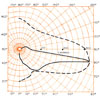 Refractor: Z 6508
Refractor: Z 6508
Cone: Z 6819
One of the "Clearside" range for Group B roads.
Side road lighting, 13-15 ft (3.96-4.57 m) mounting height, spacing
100-120 ft (30.48-36.58 m) for best results. Road width up to
30 ft (9.14 m). This lantern is also very suitable for decorative garden,
promenade and balustrade lighting, new housing estates, space lighting
in front of offices, blocks of flats and halls.
Post top spigot cap for a 3 in. (76.2 mm) diameter x 3 in. (76.2 mm) high spigot. The lantern
is secured by three 7/16 in. diameter Allen-type grub screws in the spigot cap.
The lantern can be supplied with a collar insert for the spigot cap to fit a 2.3/8 in. diameter
spigot. This must be specified when ordering.
The body consists of a truncated moulded "Diakon" cone held between a cast aluminium base incorporating
the spigot cap, and a die-cast light alloy upper rim.
Two vertical rods join the base to the upper rim. A casting which slides on these rods carries the lampholder.
This enables the lantern to be focused for the full range of lamp wattages shown.
The light aluminium cast top canopy is hinged to the upper rim and secured when closed by a quick release
stainless steel toggle catch. The prismatic glass dome refractor is secured to its supporting plate by
spring clips. The plate is held in position by two short vertical rods screwed into the top canopy.
The lantern body is fitted with a terminal block, cable cleat and earthing screw. Two heat-resisting leads
are wired to the terminal block for connecting to the lampholder. The lampholder is supplied separately.
A dome refractor controls the light distribution. A 160° non-axial asymmetric distribution is availble with
the Z6508 (ref. letter 'N') dome refractor.
The lantern weighs 14lb (6.4 kg).
The alloy used is specially selected for its resistance to corrosion and is processed to
give a pleasing apperance.
|
|
Z5673N
|
60-200W GLS
|
BC
|
Post Top
|
No Gear
|
1964 catalogue
1970s catalogue
1974 catalogue
1979 catalogue
|
|
Z5674N
|
80-125W MB/U
80-125W MBF/U
|
3BC
3BC
|
Post Top
|
No Gear
|
1964 catalogue
1970s catalogue
1974 catalogue
1979 catalogue
|
|
Z5675N
|
60-200W GLS
80-125W MBF/U
50-70-120W SON
|
ES
|
Post Top
|
No Gear
|
1964 catalogue
1970s catalogue
1974 catalogue
1979 catalogue
|
|
Z5676N
|
45-60W SOI/H
35-55W SOX
|
BC
|
Post Top
|
No Gear
|
1964 catalogue
1974 catalogue
1979 catalogue
|
|
Z5677N
|
80-125W MB/U
80-125W MBF/U
|
3BC
|
Post Top
|
No Gear
|
1964 catalogue
1974 catalogue
1979 catalogue
|
|
|

|
z 5673a/74a/75a/76a/77a | clearside 5673a/74a/75a/76a/77a


 Refractor: Z 6514
Refractor: Z 6514
Cone: Z 6819
One of the "Clearside" range for Group B roads.
Side road lighting, 13-15 ft (3.96-4.57 m) mounting height, spacing
100-120 ft (30.48-36.58 m) for best results. Road width up to
30 ft (9.14 m). This lantern is also very suitable for decorative garden,
promenade and balustrade lighting, new housing estates, space lighting
in front of offices, blocks of flats and halls.
Post top spigot cap for a 3 in. (76.2 mm) diameter x 3 in. (76.2 mm) high spigot. The lantern
is secured by three 7/16 in. diameter Allen-type grub screws in the spigot cap.
The lantern can be supplied with a collar insert for the spigot cap to fit a 2.3/8 in. diameter
spigot. This must be specified when ordering.
The body consists of a truncated moulded "Diakon" cone held between a cast aluminium base incorporating
the spigot cap, and a die-cast light alloy upper rim.
Two vertical rods join the base to the upper rim. A casting which slides on these rods carries the lampholder.
This enables the lantern to be focused for the full range of lamp wattages shown.
The light aluminium cast top canopy is hinged to the upper rim and secured when closed by a quick release
stainless steel toggle catch. The prismatic glass dome refractor is secured to its supporting plate by
spring clips. The plate is held in position by two short vertical rods screwed into the top canopy.
The lantern body is fitted with a terminal block, cable cleat and earthing screw. Two heat-resisting leads
are wired to the terminal block for connecting to the lampholder. The lampholder is supplied separately.
A dome refractor controls the light distribution. An axial asymmetric distribution is availble with
the Z6514 (ref. letter 'A') dome refractor.
The lantern weighs 14lb (6.4 kg).
The alloy used is specially selected for its resistance to corrosion and is processed to
give a pleasing apperance.
|
|
Z5673A
|
60-200W GLS
|
BC
|
Post Top
|
No Gear
|
1964 catalogue
1970s catalogue
1974 catalogue
1979 catalogue
|
|
Z5674A
|
80-125W MB/U
80-125W MBF/U
|
3BC
3BC
|
Post Top
|
No Gear
|
1964 catalogue
1970s catalogue
1974 catalogue
1979 catalogue
|
|
Z5675A
|
60-200W GLS
80-125W MBF/U
50-70-120W SON
|
ES
|
Post Top
|
No Gear
|
1964 catalogue
1970s catalogue
1974 catalogue
1979 catalogue
|
|
Z5676A
|
45-60W SOI/H
35-55W SOX
|
BC
|
Post Top
|
No Gear
|
1964 catalogue
1974 catalogue
1979 catalogue
|
|
Z5677A
|
80-125W MB/U
80-125W MBF/U
|
3BC
|
Post Top
|
No Gear
|
1964 catalogue
1974 catalogue
1979 catalogue
|
|
|
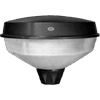
|
z 5680/81/82 | clearside z 5680/81/82
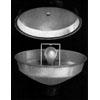
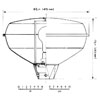
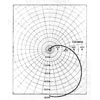 One of the "Clearside" range for Group B roads.
For side road lighting, 13-15 ft (3.96-4.57 m) mounting height, spacing 100-120 ft (30.48-36.58 m)
for best results. Road width up to 30 ft (9.14 m). This lantern is also very suitable for
decorative garden, promenade and balustrade lighting, new housing estates, space lighting in
front of offices, blocks of flats and halls. Post top spigot cap for a 3 in. (76.2 mm) diameter
x 3 in. (76.2 mm) high spigot. The lantern is secured by four 7/16 in. diameter Allen-type grub
screws in the spigot cap. The lantern can be supplied with a collar insert for the spigot cap to
fit a 2.3/8 in. diameter spigot. The body consists of an opal "Perspex" dish secured by screws
to a cast octagonal spigot cap. The spigot cap carries the lampholder and two pillars supporting a
bridge-piece. A light aluminium top spinning screws down on to the bridge piece making the lantern
totally enclosed. An earthing screw is fitted. The opal "Perspex" bowl provides a diffusive symmetric
light distribution. The spigot cap and top spinning are finished in a handsome high gloss bronze.
The lantern weighs 8lb (3.6 kg).
One of the "Clearside" range for Group B roads.
For side road lighting, 13-15 ft (3.96-4.57 m) mounting height, spacing 100-120 ft (30.48-36.58 m)
for best results. Road width up to 30 ft (9.14 m). This lantern is also very suitable for
decorative garden, promenade and balustrade lighting, new housing estates, space lighting in
front of offices, blocks of flats and halls. Post top spigot cap for a 3 in. (76.2 mm) diameter
x 3 in. (76.2 mm) high spigot. The lantern is secured by four 7/16 in. diameter Allen-type grub
screws in the spigot cap. The lantern can be supplied with a collar insert for the spigot cap to
fit a 2.3/8 in. diameter spigot. The body consists of an opal "Perspex" dish secured by screws
to a cast octagonal spigot cap. The spigot cap carries the lampholder and two pillars supporting a
bridge-piece. A light aluminium top spinning screws down on to the bridge piece making the lantern
totally enclosed. An earthing screw is fitted. The opal "Perspex" bowl provides a diffusive symmetric
light distribution. The spigot cap and top spinning are finished in a handsome high gloss bronze.
The lantern weighs 8lb (3.6 kg).
|
|
Z5680
|
60-200W GLS
|
BC
|
Post Top
|
No Gear
|
1960s catalogue
1964 catalogue
1974 catalogue
1979 catalogue
|
|
Z5681
|
80-125W MBF/U
|
3BC
|
Post Top
|
No Gear
|
1960s catalogue
1964 catalogue
1974 catalogue
1979 catalogue
|
|
Z5682
|
60-200W GLS
80-125W MBF/U
50-70-120W SON
|
ES
|
Post Top
|
No Gear
|
1960s catalogue
1964 catalogue
1974 catalogue
1979 catalogue
|
|
Z568?
|
35-55W SOX
|
BC
|
Post Top
|
No Gear
|
1974 catalogue
|
|
|
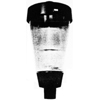
|
|
|
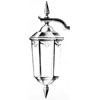
|
z 5700
The decorative lighting units illustrated on this and the following page have been specially designed
by the G.E.C. Exterior Lighting Department. Units incorporating coats of arms, crests or other requirements
can be designed to order. They include G.E.C. British-made prismatic glass refractors and low absorption
diffusing panels.
|
|
Z5700
|
???W GLS
|
???
|
Top Entry
|
No Gear
|
1937 catalogue
|
|
|
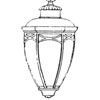
|
z 5701
Decorative street lighting lantern.
|
|
Z5701
|
???W GLS
|
???
|
Top Entry
|
No Gear
|
1937 catalogue
|
|
|
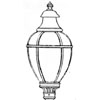
|
z 5703
Decorative street lighting lantern.
|
|
Z5703
|
???W GLS
|
???
|
Top Entry
|
No Gear
|
1937 catalogue
|
|
|
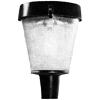
|
|
|
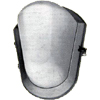
|
z 5720/25: limpet | clearspace 5720/25: limpet
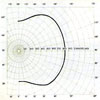
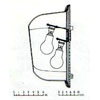
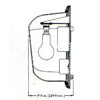 One of the "Clearspace" range for Group B roads.
Wall mounting. Die-cast light alloy flat back carrying the lampholders
and control gear when required. Hinged to this is a die-cast alloy rim carrying the opal
'Perspex' diffusing bowl. The bowl and rim are secured by a stainless steel toggle catch.
The opal 'Perspex' bowl provides a diffusive symmetric light distribution.
One of the "Clearspace" range for Group B roads.
Wall mounting. Die-cast light alloy flat back carrying the lampholders
and control gear when required. Hinged to this is a die-cast alloy rim carrying the opal
'Perspex' diffusing bowl. The bowl and rim are secured by a stainless steel toggle catch.
The opal 'Perspex' bowl provides a diffusive symmetric light distribution.
|
|
Z5720
|
2x60-100W GLS
|
2xBC
|
Wall Mount
|
No Gear
|
1960s catalogue
1964 catalogue
|
|
Z5725
|
80-125W MB/U
80-125W MBF/U
45W SOX
|
3BC
3BC
BC
|
Wall Mount
|
Gear
|
1960s catalogue
1964 catalogue
|
|
|
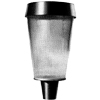
|
|
|
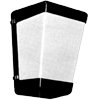
|
|
z 5760/61
|
|
Z5760/1
|
80-125W MBF/U
35W SOX
|
3BC
BC
|
Wall Mount
|
No Gear
|
1974 catalogue
|
|
|
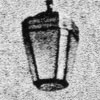
|
z 5816
Decorative street lighting lantern.
|
|
Z5816
|
???W GLS
|
???
|
???
|
No Gear
|
1937 catalogue
|
|
|
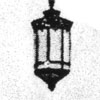
|
z 5817
Decorative street lighting lantern.
|
|
Z5817
|
???W GLS
|
???
|
???
|
No Gear
|
1937 catalogue
|
|
|
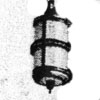
|
z 5818
Decorative street lighting lantern.
|
|
Z5818
|
???W GLS
|
???
|
???
|
No Gear
|
1937 catalogue
|
|
|
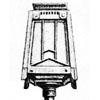
|
z 5819
Decorative street lighting lantern.
|
|
Z5819
|
???W GLS
|
???
|
Top Entry
|
No Gear
|
1937 catalogue
|
|
|
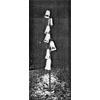
|
z 5820: canterbury
Decorative lighting fitting for parks and gardens.
|
|
Z5820
|
???W GLS
|
???
|
???
|
No Gear
|
1937 catalogue
|
|
|
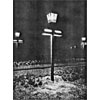
|
z 5821: regis
Decorative lighting fitting for parks and gardens.
|
|
Z5821
|
???W GLS
|
???
|
???
|
No Gear
|
1937 catalogue
|
|
|
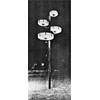
|
z 5822: pine
Decorative lighting fitting for parks and gardens.
|
|
Z5822
|
???W GLS
|
???
|
???
|
No Gear
|
1937 catalogue
|
|
|
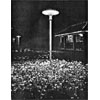
|
z 5823: mushroom
Decorative lighting fitting for parks and gardens.
|
|
Z5823
|
???W GLS
|
???
|
???
|
No Gear
|
1937 catalogue
|
|
|
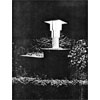
|
z 5824: pagoda
Decorative lighting fitting for parks and gardens.
|
|
Z5824
|
???W GLS
|
???
|
???
|
No Gear
|
1937 catalogue
|
|
|
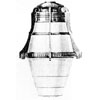
|
z 5825
The decorative lighting units illustrated on this and the following page have been specially designed
by the G.E.C. Exterior Lighting Department. Units incorporating coats of arms, crests or other requirements
can be designed to order. They include G.E.C. British-made prismatic glass refractors and low absorption
diffusing panels.
|
|
Z5825
|
???W GLS
|
???
|
Top Entry
|
No Gear
|
1937 catalogue
|
|
|
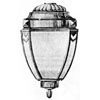
|
z 5826
The decorative lighting units illustrated on this and the following page have been specially designed
by the G.E.C. Exterior Lighting Department. Units incorporating coats of arms, crests or other requirements
can be designed to order. They include G.E.C. British-made prismatic glass refractors and low absorption
diffusing panels.
|
|
Z5826
|
???W GLS
|
???
|
Top Entry
|
No Gear
|
1937 catalogue
|
|
|
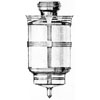
|
z 5827
The decorative lighting units illustrated on this and the following page have been specially designed
by the G.E.C. Exterior Lighting Department. Units incorporating coats of arms, crests or other requirements
can be designed to order. They include G.E.C. British-made prismatic glass refractors and low absorption
diffusing panels.
|
|
Z5827
|
???W GLS
|
???
|
Top Entry
|
No Gear
|
1937 catalogue
|
|
|
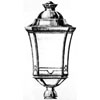
|
z 5828
The decorative lighting units illustrated on this and the following page have been specially designed
by the G.E.C. Exterior Lighting Department. Units incorporating coats of arms, crests or other requirements
can be designed to order. They include G.E.C. British-made prismatic glass refractors and low absorption
diffusing panels.
|
|
Z5828
|
???W GLS
|
???
|
Post Top
|
No Gear
|
1937 catalogue
|
|
|
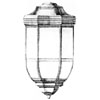
|
z 5829
The decorative lighting units illustrated on this and the following page have been specially designed
by the G.E.C. Exterior Lighting Department. Units incorporating coats of arms, crests or other requirements
can be designed to order. They include G.E.C. British-made prismatic glass refractors and low absorption
diffusing panels.
|
|
Z5829
|
???W GLS
|
???
|
Top Entry
|
No Gear
|
1937 catalogue
|
|
|
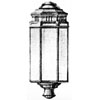
|
z 5830
The decorative lighting units illustrated on this and the following page have been specially designed
by the G.E.C. Exterior Lighting Department. Units incorporating coats of arms, crests or other requirements
can be designed to order. They include G.E.C. British-made prismatic glass refractors and low absorption
diffusing panels.
|
|
Z5830
|
???W GLS
|
???
|
Post Top
|
No Gear
|
1937 catalogue
|
|
|
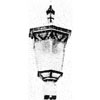
|
z 5831
Decorative street lighting lantern.
|
|
Z5831
|
???W GLS
|
???
|
???
|
No Gear
|
1937 catalogue
|
|
|
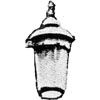
|
z 5832
Decorative street lighting lantern.
|
|
Z5832
|
???W GLS
|
???
|
???
|
No Gear
|
1937 catalogue
|
|
|
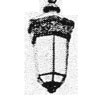
|
z 5833
Decorative street lighting lantern.
|
|
Z5833
|
???W GLS
|
???
|
???
|
No Gear
|
1937 catalogue
|
|
|
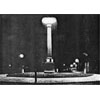
|
z 5834
Decorative street lighting lantern for island lighting.
|
|
Z5834
|
???W GLS
|
???
|
???
|
No Gear
|
1937 catalogue
|
|
|
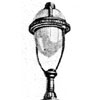
|
z 5835
Decorative street lighting lantern for bridge lighting.
|
|
Z5835
|
???W GLS
|
???
|
???
|
No Gear
|
1937 catalogue
|
|
|
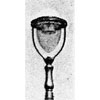
|
z 5836
Decorative street lighting lantern for bridge lighting.
|
|
Z5836
|
???W GLS
|
???
|
???
|
No Gear
|
1937 catalogue
|
|
|
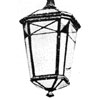
|
z 5837
Decorative street lighting lantern for bridge lighting.
|
|
Z5837
|
???W GLS
|
???
|
???
|
No Gear
|
1937 catalogue
|
|
|
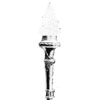
|
z 5838
Decorative street lighting lantern for bridge lighting.
|
|
Z5838
|
???W GLS
|
???
|
???
|
No Gear
|
1937 catalogue
|
|
|

|
z 5839
Decorative street lighting lantern for bridge lighting.
|
|
Z5839
|
???W GLS
|
???
|
???
|
No Gear
|
1937 catalogue
|
|
|
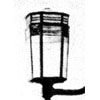
|
z 5840
Decorative lighting equipment.
|
|
Z5840
|
???W GLS
|
???
|
???
|
No Gear
|
1937 catalogue
|
|
|
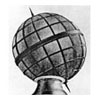
|
z 5841
Decorative lighting equipment.
|
|
Z5841
|
???W GLS
|
???
|
???
|
No Gear
|
1937 catalogue
|
|
|
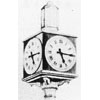
|
z 5842
Decorative lighting equipment.
|
|
Z5842
|
???W GLS
|
???
|
???
|
No Gear
|
1937 catalogue
|
|
|
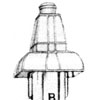
|
z 5843
Decorative lighting equipment.
|
|
Z5843
|
???W GLS
|
???
|
???
|
No Gear
|
1937 catalogue
|
|
|
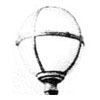
|
z 5844
Decorative lighting equipment.
|
|
Z5844
|
???W GLS
|
???
|
???
|
No Gear
|
1937 catalogue
|
|
|
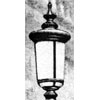
|
z 5845
Decorative lighting equipment.
|
|
Z5845
|
???W GLS
|
???
|
???
|
No Gear
|
1937 catalogue
|
|
|
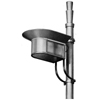
|
z 8001: watford lantern
British Patents: 408419 and 414726
G.E.C. Registered Design: 781091
Refractor: Z6301
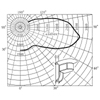 The first lantern to use a discharge lamp. First installation along Watford Road, Wembely in March 1933. For main road lighting.
Gives a non-cut-off distribution. Primary optical system consists of two
refractor plates which spread the main beams in azimuth to spread the light across the road - no attempts are made to try to control the light
in a vertical plane as it results in a patchy distribution. Secondary lighting system includes an white over-reflector and large base fitted with
a diffuser - this is an attempt to increase the flux emitted directed below the lamp and increase the illumination below the lantern to
avoid "dark patches." As the MA lamp burns hot, a metal framed lantern is used with special heat-resisting glass. Condensation along the
bracket arm will break the MA lamp if dripped upon, so the lantern is fixed to the column by means of four, horizontal, separate
side-bracket arms.. According to Gregory in 1940, the lantern "was particularly designed to avoid
glare and give a good road brightness therefore becoming the first lantern consciously designed to produce
high background brightness instead of high object brightness. Totally enclosed dust-proof lantern, specially designed for OSIRA lamps.
Constructed of heavy gauge copper on cast gunmetal frame and provided with hinged bottom panel
to give access for cleaning and re-lamping.The outer surfaces are finished aluminium. The lantern is
supplied complete with porcelain enamel inner reflector and two special prismatic glass plate refractors
to suit the light distribution of the OSIRA lamps. The lantern is glazed with spreader glasses, which give,
in conjunction with the plate refractors,an asymmetric light distribution producing high and even road
brightness. Fitted with external weatherproof connecting box, and wired internally with special
heat-resisting conductors between the connecting box and G.E.S. porcelain lampholder, the latter being
adjustable to vary the direction of the main beams. Had four bracket options: Z2001 for mounting to poles,
Z2002 for mounting to flat walls, Z2003 for lantern and Z1900/9/11 box and Z2004 simplified bracket for
flat walls. External finish is aluminium colour.
The first lantern to use a discharge lamp. First installation along Watford Road, Wembely in March 1933. For main road lighting.
Gives a non-cut-off distribution. Primary optical system consists of two
refractor plates which spread the main beams in azimuth to spread the light across the road - no attempts are made to try to control the light
in a vertical plane as it results in a patchy distribution. Secondary lighting system includes an white over-reflector and large base fitted with
a diffuser - this is an attempt to increase the flux emitted directed below the lamp and increase the illumination below the lantern to
avoid "dark patches." As the MA lamp burns hot, a metal framed lantern is used with special heat-resisting glass. Condensation along the
bracket arm will break the MA lamp if dripped upon, so the lantern is fixed to the column by means of four, horizontal, separate
side-bracket arms.. According to Gregory in 1940, the lantern "was particularly designed to avoid
glare and give a good road brightness therefore becoming the first lantern consciously designed to produce
high background brightness instead of high object brightness. Totally enclosed dust-proof lantern, specially designed for OSIRA lamps.
Constructed of heavy gauge copper on cast gunmetal frame and provided with hinged bottom panel
to give access for cleaning and re-lamping.The outer surfaces are finished aluminium. The lantern is
supplied complete with porcelain enamel inner reflector and two special prismatic glass plate refractors
to suit the light distribution of the OSIRA lamps. The lantern is glazed with spreader glasses, which give,
in conjunction with the plate refractors,an asymmetric light distribution producing high and even road
brightness. Fitted with external weatherproof connecting box, and wired internally with special
heat-resisting conductors between the connecting box and G.E.S. porcelain lampholder, the latter being
adjustable to vary the direction of the main beams. Had four bracket options: Z2001 for mounting to poles,
Z2002 for mounting to flat walls, Z2003 for lantern and Z1900/9/11 box and Z2004 simplified bracket for
flat walls. External finish is aluminium colour.
|
|
Z8001
|
400W MA/V
|
GES
|
Side Clamp
|
No Gear
|
1935 Catalogue
1935 Catalogue
1936 Paper
1937 Catalogue
1940 Journal
1944 Journal
|
|
|
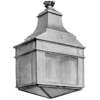
|
z 8003: lewisham lantern
British Patents: 408419, 414726 and 427835
G.E.C. Registered Design: 784361
Refractor: Z6301
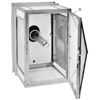 Totally enclosed dust-proof lantern, specially designed for OSIRA lamps. Constructed of heavy
gauge copper with internal stiffening ribs and provided with hinged bottom panel to give access for
cleaning an re-lamping. The outer surfaces are finished aluminium. The lantern is supplied complete with
porcelain enamel inner reflector and two special prismatic glass plate refractors to suit the light
distribution of the OSIRA lamp. The lantern is glazed with spreader glasses which give, in conjunction
with the plate refractors, an asymmetric light distribution producing high and even road-brightness.
The possibility of lamp failures due to water-drip or condensation is entirely eliminated by the patent
external top connecting box. The lantern is wired internally with special heat-resisting conductors
between the connecting box and the G.E.S. porcelain lampholder, the latter being adjustable to vary
the direction ofthe main beams. In 1937, a new solid cast top was added to further prevent water drip.
The external finish is aluminium colour
Totally enclosed dust-proof lantern, specially designed for OSIRA lamps. Constructed of heavy
gauge copper with internal stiffening ribs and provided with hinged bottom panel to give access for
cleaning an re-lamping. The outer surfaces are finished aluminium. The lantern is supplied complete with
porcelain enamel inner reflector and two special prismatic glass plate refractors to suit the light
distribution of the OSIRA lamp. The lantern is glazed with spreader glasses which give, in conjunction
with the plate refractors, an asymmetric light distribution producing high and even road-brightness.
The possibility of lamp failures due to water-drip or condensation is entirely eliminated by the patent
external top connecting box. The lantern is wired internally with special heat-resisting conductors
between the connecting box and the G.E.S. porcelain lampholder, the latter being adjustable to vary
the direction ofthe main beams. In 1937, a new solid cast top was added to further prevent water drip.
The external finish is aluminium colour
|
|
Z8003
|
400W MA/V
|
GES
|
Top Entry
|
No Gear
|
1935 Catalogue
1935 Catalogue
1936 Paper
1936 Journal
1937 Catalogue
|
|
|
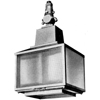
|
z 8005: tunbridge wells lantern
British Patents: 408419 and 414726
Refractor: Z6301
Totally enclosed dust-proof lantern specially designed for OSIRA lamps. Constructed of heavy gauge copper with internal stiffening
ribs and provided with hinged bottom panel to give access for cleaning and re-lamping. The lantern is supplied completed with porcelain enamelled
inner reflector and two special prismatic glass plate refractors to suit the light distribution of the OSIRA lamp. The lantenr is glazed with
spreader glasses which give, in conjunction with the plate refractors, an asymmetric light distribution producing high and even road brightness.
The possibility of lamp failures due to water drip or condensation is entirely eliminated by the patent external top
connecting box. The lantern is wired internally with special heat-resisting conductors between the connecting box and the G.E.S. porcelain
lampholder, the latter being adjustable to vary the direction of the main beams. The external finish of the lantern is aluminium colour.
|
|
Z8005
|
400W MA/V
|
GES
|
Top Entry
|
No Gear
|
1935 Catalogue
1936 Advert
1936 Journal
1937 Catalogue
1937 Catalogue
1945 Advert
|
|
|
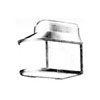
|
z 8007: small watford lantern
British Patents: 408419
Refractor: Z6300
Totally enclosed dust-proof lantern specially designed for OSIRA lamps. It has an ornamental stepped cast top with an iron frame body, and it
is provided with a hinged bottom panel to give access for cleaning and re-lamping. The lantern is supplied complete with porcelain enamelled
inner reflector and two special prismatic glass plate refractors to suit the light distribution of the OSIRA lamp. The lantenr is glazed with
spreader glasses which give wih the plate refractors, an asymmetric light distribution producing that light level of road brightness
which is so necesary if the road is to be well lighted. The lantern has been designed for use with either 150 or 250-watt OSIRA lamps. When
used with 150-watt lamp an E.S> porcelain holder is required, but it is necessary to employ a G.E.S. porcelain lampholder when
a 250-watt OSIRA lamp is in use. The lampholder is wired with heat-resisting leads to a connecting terminal block. A focusing device
alters the asymmetery of the main light beams. A standard size of pole clamp is supplied enabling the lantern to be attached to poles
of diameter between 4½in. and 5½in. The external finish of the lantern is aluminium colour.
|
|
Z8007
|
150W MA/V
|
ES
|
Side Clamp
|
No Gear
|
1937 Catalogue
|
|
Z8008
|
250W MA/V
|
GES
|
Side Clamp
|
No Gear
|
1937 Catalogue
|
|
|
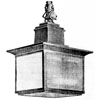
|
z 8009: birchfield lantern
British Patents: 408419 and 427835
Refractor: Z6301
Totally enclosed dust-proof lantern specially designed for OSIRA lamps. The body is onstructed of heavy gauge copper
with internal stiffening ribs, with a hinged bottom panel to give access for cleaning and re-lamping.
The upper canopy overhangs the main frame of the body. Two special prismatic glass plate refractors when used with
the spreader glasses produce an asymmetric light distribution. The optical system is specially designed by G.E.C.
Research Laboratories to produce high and even road brightness with absence of glare.
The lantern is supplied with an
inner porcelain enamelled reflector with a G.E.S. lampholder so that the lantern is suitable for 250 and 400-watt
OSIRA lamps, the lampholder being wired with heat-resisting conductors to a G.E.C. patent external top connecting box
specially designed to eliminate all danger of lamp failure due to water drip or condensation. The external
finish of the lantern is aluminium colour.
|
|
Z8009
|
250-400W MA/V
|
GEC
|
Top Entry
|
No Gear
|
1937 Catalogue
|
|
|
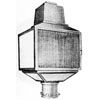
|
z 8055: post top tunbridge wells lantern
British Patent: 408419
Totally enclosed dust-proof lantern specially designed for OSIRA lamps, constructed of heavy gauge copper with
internal stiffening ribs and a hinged end panel to give access for cleaning and re-lamping.
The spigot is of cast iron, is easily detachable and can be supplied in different sizes.
The lantern is supplied with two special prismatic glass plate refractors specially designed to suit the light
distribution of the OSIRA lamp. It is also glazed with spreader glasses which provide when used with the plate
refractors, an asymmetric light distribution giving a high even road brightness.
The lantern is supplied complete with a porcelain enamelled inner reflector with a focusing G.E.S. porcelain
lampholder so that either 250 or 400-watt OSIRA lamps can be used. It is wired with heat-resisting leads from
the lampholder to terminal connecting block. The external finish of the lantern is aluminium colour.
|
|
Z8055
|
250W MA/V
|
GES
|
Post Top
|
No Gear
|
1937 Catalogue
|
|
Z8055
|
400W MA/V
|
GES
|
Post Top
|
No Gear
|
1937 Catalogue
|
|
|
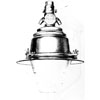
|
|
z 8104: small di-fuser lantern
Opal bowl: Z6466
Totally enclosed, dust-proof lantern, specially designed for OSIRA lamps with a cast iron top and a spun dome shaped
copper body, vitreous enamelled steel inner reflector and similar outer reflector secured by spring fasteners. The latter
holds the Z 6466 stepped white opal globe. This, when used with a Z 7607 felt ring makes the lantern
dustproof. The possibility of lamp failure due to water drip or condensation is eliminated by means of the G.E.C.
patent top connecting box, which is wired by means of heat-resisting leads to an E.S. porcelain lampholder,
correctly positioned for use with 150-watt OSIRA lamps.
The external finish of the lantern is aluminium colour, with all reflecting surfaces heavily vitreous enamelled.
|
|
Z8104
|
150W MA/V
|
ES
|
Top Entry
|
No Gear
|
1937 Catalogue
|
|
|
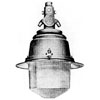
|
z 8105: small di-fractor lantern
British Patents: 408419, 427835 and 424800.
Refractor: Z6607
A specially designed lantern to take the 150W MA/V lamp. Introduced in 1936.
Totally enclosed dust-proof lantern, specially designed for 150-watt OSIRA lamps. The lantern has a cast-iron top with a dome-shaped spun
copper body with vitreous enamelled inner and outer reflectors. The lantern is notched to located the refractor which is held by the hinged
outer reflector. The prismatic glass bowl refractor Z 6607 is precisely similar in its optical properties to the Z 6609 bowl
refractor but smaller in size. The refractor is more fully described on the previous pages. The light distribution is non-axial asymmetric,
the main beams being 160° apart in plan. The bowl refractor used in conjunction with the Z 7607 felt ring constitues an
outer-dust-proof globe. A G.E.C. patent top connecting box, specially designed to eliminate all danger of lamp failure due to water drip
or condensation, is wired with heat-resisting leads to an E.S. porcelain lampholder correctly positioned to take 150-watt OSIRA lamps.
The external finish of the lantern is aluminium colour with all reflecting surfaces heavy vitreous enamlled.
|
|
Z8105
|
150W MA/V
|
ES
|
Top Entry
|
No Gear
|
1936 Journal
1937 Catalogue
|
|
|
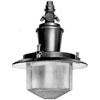
|
z 8122: di-fractor lantern
British Patents: 408419
Refractor: Z6609
This is the first version of the Di-Fractor Lantern to use the Glass Bowl Refractor-Diffuser designed for
use with MA/V lamps.
Totally enclosed dust-proof lantern, specially designed for OSIRA lamps. The body is of heavy guage
copper with porcelain enamel steel inner and outer reflectors. The outer reflector is hinged and
provided with a locating notch for the G.E.C. single piece prismatic bowl refractor-diffuser
(Z 6609), which also acts as a dust-proof outer globe. The refractor has a non-axial asymmetric
distribution, the two main beams being 160° apart in plan. The patented combination of refracting
prisms and diffusing flutes provides a high degree of light control together with an increase of flashed
area, the resultant distribution giving high and even road-brighness with a minimum of glare. The incorporation
of refractor, diffuser and outer globe in one piece of accurate glassware gives a low absorption
high efficiency unit. The possibility of lamp failures due to water-drop or condensation is entirely
eliminated by the patent top connecting box.
The narrow canopy may have proved problematic for heat dissipation from
the hot MA/V lamp hence the far wider designs used later.
|
|
Z8122
|
400W MA/V
|
GES
|
Top Entry
|
No Gear
|
1935 Catalogue
1936 Advert
1936 Paper
1936 Journal
|
|
|
|
|
z????: ??? lantern
A dual purpose lantern which could take either tungsten (GLS) or
mercury vapour (MA/V) lamps.
|
|
Z????
|
???W GLS
400W MA/V
|
GES
|
???
|
No Gear
|
1936 Journal
|
|
|
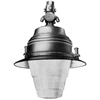
|
|
z 8124: large di-fuser lantern
Opal bowl: Z6468
Introduced in 1937. Described as a "new type of GEC Di-Fuser street lighting lantern."
Spun copper body with steel inner reflector supporting a "pleasingly stepped" low
absorption flashed opal globe.
Totally enclosed dustproof lantern specially designed for use with 250 and 400-watt OSIRA lamps. The body is of spun
copper of a symmetrical dome appearance. A vitreous enamelled steel inner reflector secures the Z 6468 stepped white
opal globe. The diffuser bowl is of high quality low absorption flashed white opal glass. It is both pleasing in appearance
and optically efficient, the whole bowl appearing equally bright and producing a highly diffused light. The bowl when used with a
Z 7467 felt ring is a completely dustproof outer globe. It is secured by a vitreous enamelled steel outer reflector
which is held by spring fasteners. The possibility of lamp failure due to water drip or condensation is eliminated
by the patented G.E.C. top connecting box which is wired with heat-resisting leads to the G.E.S. porcelain
lampholder, which can be used in either of two positions so that the lantern is suitable for both 250 and 400-watt
OSIRA lamps.
The external finish of the lantern is aluminium colour with all reflecting surfaces heavily vitreous enamelled.
|
|
Z8124
|
250-400W MA/V
|
GES
|
Top
|
No Gear
|
1937 Journal
1937 Catalogue
|
|
|
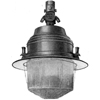
|
z 8125: fulham di-fractor lantern
British Patents: 408419, 427835 and 424800.
Refractor: Z6609
Named after the first installation in Fulham, where the installation along the Fulham High Road was used to
outline the importance of siting and light distribution for high, uniform road brightness. This installation which was inaugurated
in February 1937 and included 460 lanterns. The largest installation using these lanterns was probably
in Deptford in 1937.
Uses a patented combination of internal refracting flutes and external diffusing flutes
which makes the night time appearance very pleasant since the whole refractor bowl appears uniformally
bright and free from small areas of intense brightness which would produce glare. It enables long
stretches of road to be illuminated in the most economical matter possible. Its optical design is
such that light is emitted at high angles from the vertical, which makes it possible to
employ the reflection properties of the road to their full extent, and to mount the lanterns more
than 50 yards or more apart.
Totally enclosed dust-proof lantern, specially designed for use with 250-watt and 400-watt OSIRA lamps. Constructed of heavy gauge copper
with porcelain enamelled steel inner and outer reflectors.
The outer reflector is hinged and provided with a locating notch for a G.E.C. single piece prismatic bowl refractor, which also
acts as a dust-proof outer globe. The light distribution is non-axial asymmetric, the main beams being 160° in plan. The G.E.C.
patented bowl refractor enables so good a control of light to be obtained that a very high degree of road brightness is produced,
and this is now the criterion by which street lighting should be judged. The lantern is wired with heat-resisting leads from the
patent top connecting box, specially designed to eliminate all danger of lamp failure due to water drop or condensation.
A two-positioned G.E.S. porcelain lampholder enables the lantern to be used with 250 or 400-watt lamps. A felt ring is provided for the
refractor bowl.
The external finish of the lantern is aluminium colour with all reflecting surfaces heavy vitreous enamlled.
|
|
Z8125
|
250W MA/V
400W MA/V
|
GES
|
Top Entry
|
No Gear
|
1937 Journal
1937 programme
1937 Journal
1937 Catalogue
1937 Catalogue
|
|
|
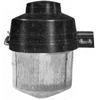
|
|
|
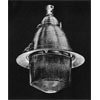
|
z 8134b/5b/7b/8b: universal "difractor" lantern
British Patent: 408419
Bowl: Z 6610
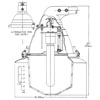
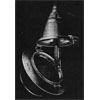
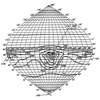 Used for main road lighting; 25 ft. mounting height; spacing 120-150 ft; road width up to 40 ft. Has both
top and side entry options (hence the "universal" label) with additional option for a levelling top. (A levelling top on the ball and socket
principle is provided on the Z.8134 and Z.8137 body. This enables small variations from the vertical of the lantern to be corrected).
Used for main road lighting; 25 ft. mounting height; spacing 120-150 ft; road width up to 40 ft. Has both
top and side entry options (hence the "universal" label) with additional option for a levelling top. (A levelling top on the ball and socket
principle is provided on the Z.8134 and Z.8137 body. This enables small variations from the vertical of the lantern to be corrected).
Die-cast light alloy. The body consists of a main bell-shaped casting containing the focusing gear and lampholder. On the top of the body a
small "umbrella" shaped casting prtects the weathered cable entry and porcelain terminal block from water-drip. This "umbrella" and the terminal
block are enclosed by a hinged cap which is secured by two fixing bolts to the main body. Two toggle action catches, one of which acts as a
hinge, support the outer over-reflector which holds the bowl refractor. An earthing screw is provided.
The lampholder is a G.E.S. porcleain holder wired to the terminal block with heat-resisting wire. An anti-vibration mounting can be provided.
The lampholder is mounted on a bridge which is carried on two vertical pillars. A spring-loaded catch ensures that the bridge is locked
into the correct focal position for the type of lamp in use. The refractor is made in one piece of heat-resisting glass and is a Z.6610
non-axial asymmetric bowl refractor. It has vertical curved prisms and deep flutes on the interior surface to provide light control. The exterior of the
bowl is smooth except for some prisms on the base. A white enamelled inner reflector is held in place by an expanding spring ring. Constriction
of this ring releases the reflector, giving access for focusing and maintenace.
The alloy used is specially selected for its resistance to corrosion. Further protection is obtained by the use of a suitable primer,
undercoat and glossy aluminium top coat.
|
|
Z8134B
|
250-400W MB/V
|
GES
|
Top Entry
Levelling Top
|
No Gear
|
1948 Catalogue
|
|
Z8135B
|
250-400W MB/V
|
GES
|
Top Entry
|
No Gear
|
1948 Catalogue
|
|
Z8137B
|
125-400W MBF/V
|
GES
|
Side Entry
Levelling Top
|
No Gear
|
1948 Catalogue
|
|
Z8138B
|
125-400W MBF/V
|
GES
|
Side Entry
|
No Gear
|
1948 Catalogue
|
|
|
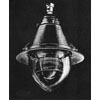
|
z 8134*c/5*c/7*c/8*c: universal "wembley" lantern
British Patents: 408419 and 458617
Refractors: Z 6504, Z 6510 or Z 6516
Bowl: Z 6467
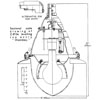
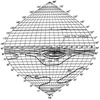 Used for main road lighting; 25 ft. mounting height; spacing 120-150 ft; road width up to 40 ft. Has both top and side entry options (hence the "universal" label)
with additional option for a levelling top. (A levelling top on the ball and socket principle is provided on the Z.8134 and Z.8137 body. This
enables small variations from the vertical of the lantern to be corrected).
Used for main road lighting; 25 ft. mounting height; spacing 120-150 ft; road width up to 40 ft. Has both top and side entry options (hence the "universal" label)
with additional option for a levelling top. (A levelling top on the ball and socket principle is provided on the Z.8134 and Z.8137 body. This
enables small variations from the vertical of the lantern to be corrected).
Die-cast light alloy. The body consists of a main bell-shaped casting containing the focusing gear and lampholder. On the top of the
body a small "umbrella" shaped casting protects the weathered cable entry and porcelain terminal block from water drip. This "umbrella"
and the terminal block are enclosed by a hinged cap which is secured by two fixing bolts to the main body. Two toggle action catches, one
of which acts as a hinge, support the outer over-reflector which holds the bowl refractor. An earthing screw is provided.
The G.E.S. porcelain holder is wired to the terminal block with heat-resisting wire. An anti-vibration mounting can be provided. The lampholder is mounted
on a bridge which is carried on two vertical pillars. A spring-loaded catch ensures that the bridge is locked into the correct focal position
for the type of lamp in use. The lantern has the Wembley type light distribution. Three forms of light distribution are available, dependent upon
the type of dome refractor in use:- (1) Symmetric, giving all-round distribution Z.6504 (reference letter "S") dome refractor;
(2) 160 deg. non-axial asymmetric, giving main light output up and down the street just away from the kerb with Z.6510 (reference letter "N")
dome refractor; (3) Axial asymmetric, providing light output directly up and down the street with Z.6516 (reference letter "A") dome refractor.
The outer glassware is the clear globe Z.6467.
The light alloy is espcially selected for its resistance to corrosion. Further protection is obtained by the use of a suitable primer, undercoat and
glossy aluminium top coat.
|
Z 8134SC
Z 8134NC
Z 8134AC
|
300-500W GLS
|
GES
|
Top Entry
Levelling Top
|
No Gear
|
1948 Catalogue
|
Z 8135SC
Z 8135NC
Z 8135AC
|
300-500W GLS
|
GES
|
Top Entry
|
No Gear
|
1948 Catalogue
|
Z 8137SC
Z 8137NC
Z 8137AC
|
300-500W GLS
|
GES
|
Side Entry
Levelling Top
|
No Gear
|
1948 Catalogue
|
Z 8138SC
Z 8138NC
Z 8138AC
|
300-500W GLS
|
GES
|
Side Entry
|
No Gear
|
1948 Catalogue
|
|
|
|
|
z 8134*r/5*r/7*r/8*r: universal "wembley" lantern
British Patents: 408419 and 458617
Refractors: Z 6504, Z 6510 or Z 6516
Bowl: Z 6477
Used for main road lighting; 25 ft. mounting height; spacing 120-150 ft; road width up to 40 ft. Has both top and side entry options (hence the "universal" label)
with additional option for a levelling top. (A levelling top on the ball and socket principle is provided on the Z.8134 and Z.8137 body. This
enables small variations from the vertical of the lantern to be corrected).
Die-cast light alloy. The body consists of a main bell-shaped casting containing the focusing gear and lampholder. On the top of the
body a small "umbrella" shaped casting protects the weathered cable entry and porcelain terminal block from water drip. This "umbrella"
and the terminal block are enclosed by a hinged cap which is secured by two fixing bolts to the main body. Two toggle action catches, one
of which acts as a hinge, support the outer over-reflector which holds the bowl refractor. An earthing screw is provided.
The G.E.S. porcelain holder is wired to the terminal block with heat-resisting wire. An anti-vibration mounting can be provided. The lampholder is mounted
on a bridge which is carried on two vertical pillars. A spring-loaded catch ensures that the bridge is locked into the correct focal position
for the type of lamp in use. The lantern has the Wembley type light distribution. Three forms of light distribution are available, dependent upon
the type of dome refractor in use:- (1) Symmetric, giving all-round distribution Z.6504 (reference letter "S") dome refractor;
(2) 160 deg. non-axial asymmetric, giving main light output up and down the street just away from the kerb with Z.6510 (reference letter "N")
dome refractor; (3) Axial asymmetric, providing light output directly up and down the street with Z.6516 (reference letter "A") dome refractor.
The outer glassware is the rimpled globe Z.6477.
The light alloy is espcially selected for its resistance to corrosion. Further protection is obtained by the use of a suitable primer, undercoat and
glossy aluminium top coat.
|
Z 8134SR
Z 8134NR
Z 8134AR
|
300-500W GLS
|
GES
|
Top Entry
Levelling Top
|
No Gear
|
1948 Catalogue
|
Z 8135SR
Z 8135NR
Z 8135AR
|
300-500W GLS
|
GES
|
Top Entry
|
No Gear
|
1948 Catalogue
|
Z 8137SR
Z 8137NR
Z 8137AR
|
300-500W GLS
|
GES
|
Side Entry
Levelling Top
|
No Gear
|
1948 Catalogue
|
Z 8138SR
Z 8138NR
Z 8138AR
|
300-500W GLS
|
GES
|
Side Entry
|
No Gear
|
1948 Catalogue
|
|
|
|
|
z 8134"o"/5"o"/7"o"/8"o": universal "wembley" lantern
British Patents: 408419 and 458617
Bowl: Z 6468
Used for main road lighting; 25 ft. mounting height; spacing 120-150 ft; road width up to 40 ft. Has both top and side entry options (hence the "universal" label)
with additional option for a levelling top. (A levelling top on the ball and socket principle is provided on the Z.8134 and Z.8137 body. This
enables small variations from the vertical of the lantern to be corrected).
Die-cast light alloy. The body consists of a main bell-shaped casting containing the focusing gear and lampholder. On the top of the
body a small "umbrella" shaped casting protects the weathered cable entry and porcelain terminal block from water drip. This "umbrella"
and the terminal block are enclosed by a hinged cap which is secured by two fixing bolts to the main body. Two toggle action catches, one
of which acts as a hinge, support the outer over-reflector which holds the bowl refractor. An earthing screw is provided.
The G.E.S. porcelain holder is wired to the terminal block with heat-resisting wire. An anti-vibration mounting can be provided. The lampholder is mounted
on a bridge which is carried on two vertical pillars. A spring-loaded catch ensures that the bridge is locked into the correct focal position
for the type of lamp in use. The lantern has the Wembley type light distribution.
The outer glassware is the stepped opal globe Z.6468 (reference letter "O"). This is purely diffusive and no dome refractor is supplied.
The light alloy is espcially selected for its resistance to corrosion. Further protection is obtained by the use of a suitable primer, undercoat and
glossy aluminium top coat.
|
Z 8134"O"
Z 8134"O"
Z 8134"O"
|
300-500W GLS
|
GES
|
Top Entry
Levelling Top
|
No Gear
|
1948 Catalogue
|
Z 8135"O"
Z 8135"O"
Z 8135"O"
|
300-500W GLS
|
GES
|
Top Entry
|
No Gear
|
1948 Catalogue
|
Z 8137"O"
Z 8137"O"
Z 8137"O"
|
300-500W GLS
|
GES
|
Side Entry
Levelling Top
|
No Gear
|
1948 Catalogue
|
Z 8138"O"
Z 8138"O"
Z 8138"O"
|
300-500W GLS
|
GES
|
Side Entry
|
No Gear
|
1948 Catalogue
|
|
|
|
|
z 8134sb/5sb/7sb/8sb: universal "oxford" lantern
British Patents: 408419 and 458617
Refractors: Z 6504
Bowl: Z 6610
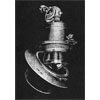 Used for main road lighting; 25 ft. mounting height; spacing 120-150 ft; road width up to 40 ft. Has both top and side entry options (hence the "universal" label)
with additional option for a levelling top. (A levelling top on the ball and socket principle is provided on the Z.8134 and Z.8137 body. This
enables small variations from the vertical of the lantern to be corrected).
Used for main road lighting; 25 ft. mounting height; spacing 120-150 ft; road width up to 40 ft. Has both top and side entry options (hence the "universal" label)
with additional option for a levelling top. (A levelling top on the ball and socket principle is provided on the Z.8134 and Z.8137 body. This
enables small variations from the vertical of the lantern to be corrected).
Die-cast light alloy. The body consists of a main bell-shaped casting containing the focusing gear and lampholder. On the top of the
body a small "umbrella" shaped casting protects the weathered cable entry and porcelain terminal block from water drip. This "umbrella"
and the terminal block are enclosed by a hinged cap which is secured by two fixing bolts to the main body. Two toggle action catches, one
of which acts as a hinge, support the outer over-reflector which holds the bowl refractor. An earthing screw is provided.
The G.E.S. porcelain holder is wired to the terminal block with heat-resisting wire. An anti-vibration mounting can be provided. The lampholder is mounted
on a bridge which is carried on two vertical pillars. A spring-loaded catch ensures that the bridge is locked into the correct focal position
for the type of lamp in use. The lantern has the Oxford type light distribution. The optical system consists of a symmetric dome refractor and an outer bowl refractor
(reference letter "B") Cat. No. Z.6610.
The light alloy is espcially selected for its resistance to corrosion. Further protection is obtained by the use of a suitable primer, undercoat and
glossy aluminium top coat.
|
Z 8134SB
|
300-500W GLS
|
GES
|
Top Entry
Levelling Top
|
No Gear
|
1948 Catalogue
|
Z 8135SB
|
300-500W GLS
|
GES
|
Top Entry
|
No Gear
|
1948 Catalogue
|
Z 8137SB
|
300-500W GLS
|
GES
|
Side Entry
Levelling Top
|
No Gear
|
1948 Catalogue
|
Z 8138SB
|
300-500W GLS
|
GES
|
Side Entry
|
No Gear
|
1948 Catalogue
|
|
|

|
z 8155: small oxford lantern
British Patents: 458617, 424800, 408419, 427835 and 376831.
Refractors: Z 6607 and Z 6501
See also: Z 5515
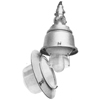 The outer refractor of this unit is used with the normal long-source
HPMV lamp but it operates successfully with the short source and dome
refractor. The effects of the horizontal prisms on the dome is to make the
small source approximately equivalent optically to the long source lamp.
The form of the light distribution below the horizontal is therefore comparable
with that of the higher wattage units.
The outer refractor of this unit is used with the normal long-source
HPMV lamp but it operates successfully with the short source and dome
refractor. The effects of the horizontal prisms on the dome is to make the
small source approximately equivalent optically to the long source lamp.
The form of the light distribution below the horizontal is therefore comparable
with that of the higher wattage units.
A totally enclosed dust-proof lantern specially designed for use with 80 and 125 watt OSIRA lamps. The lantern has a heavy
gauge spun copper body with a cast iron top. The are inner and outer vitreous enamelled steel reflectors, the
outer being hinged and provided with a locating notch to ensure the corrrect alignment of the prismatic glass bowl refractor
Z 6607. The prismatic bowl refractor controls in plan the light which is bent downwards by the inner
symmetric dome refractor Z 6501 as well as the direct light from the lamp, thus providing that high standard of
road brightness whcih is now considered essential if good visibility is to be obtained. The light distribution is 160°
non-axial asymmertic.
The lantern is fitted with a 3-slot B.C. lampholder which is wired with heat-resisting leads to the G.E.C. patent
connecting box. This has been specially designed to eliminate all danger of lamp failure due to water drip or condensation.
The lampholder can be raised or lowered by means of a knurled knob projecting from the cast top, and the correct focal
position for whichever wattage lamp in use can then be obtained.
The lantern can also be used with OSRAM tungsten filament lamps. It is then necessary to emply an E.S. lampholder.
The external finish of the lantern is aluminium colour and all reflecting surfaces are white vitreous enamelled.
|
|
Z8155
|
60-200W GLS
80-125W MBF/U
|
ES
3BC
|
Top Entry
|
No Gear
|
1937 Paper
1937 Advert
1938 Journal
1937 Catalogue
|
|
|
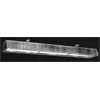
|
|
z 8181: "one-eighty" lantern
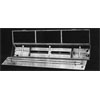
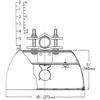
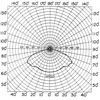 Developed in 1947 after the company were approached by Bournemouth Council to light "The Lansdowne", a busy new roundabout which already
has a significant number of trolley bus traction columns and span-wires. The GEC create four single tube fluorescent cut-off
units as a trial - it's so successful that another twenty-one units are made to complete the Lansdowne installation. The firm then
put the lantern into production as the Z 8181.
Developed in 1947 after the company were approached by Bournemouth Council to light "The Lansdowne", a busy new roundabout which already
has a significant number of trolley bus traction columns and span-wires. The GEC create four single tube fluorescent cut-off
units as a trial - it's so successful that another twenty-one units are made to complete the Lansdowne installation. The firm then
put the lantern into production as the Z 8181.
25 ft. mounting height; 50-60 ft. spacing; on narrow roads central suspension will give the best results, but on other roads
it will generally be necessary to adopt a double-sided arrangement.
This lantern has a cut-off distribution and no light is emitted above the horizontal. The peak candle power is at about 60°
to the vertical and above this angle the intensities fall off very rapidly.
The excellent colour rendering of the 80 watt OSRAM fluorescent lamp makes this lantern suitable for use in shopping areas and
wherever pedestrian traffic is heavy. The low wattage and type of light distribution makes it necessary to use the lantern
at short spacings.
It has also been found that cut-off lighting gives the best visibility at roundabouts, where normally the number of
lanterns that can be seen may cause confusion.
Two clamps on the lantern roof secure the lantern to a horizontal bracket arm which must be a minimum length of 4 ft. Bracket
tubing of ¾ in. - 1½ in. gas cane be used. For spanwire suspension, spanwire clamps are provided. The lantern
fitted with auxiliaries weighs approximately 38 lbs. (17.2 kgs).
The body is made of copper, with a cable entry at one end. The lantern is totally-enclosed by a hinged glass door which
is secured by two catches and when opened enables the interior to be cleaned or the lamp replaced. There is an inner
reflector running the length of the lantern immediately above the lamp. Removal of this gives access to the fixings
provided for the G.E.C. choke, capacitor and starter. An earthing screw is provided.
The lamp is carried in specially positioned spring clips so that no focusing is necessary.
The lantern is white enamelled internally and shaped so as to provide suitable control of the light emitted from the
lamp. The exterior of the lantern is finished glossy aluminium with a suitable undercoat.
|
|
Z 8181
|
80W MCF/U
|
2x??
|
Two clamps
|
Gear
|
1948 Catalogue
|
|
|
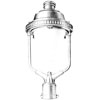
|
|
z8224: post top mounting di-fuser
Opal bowl: Z6468
Totally enclosed dustproof lantern specially designed for use with OSIRA lamps. The body is of ornamental
dome appearance made from heavy gauge spun copper. The detachabel cast iron spigot cap is fixed
to the cast iron ring on the main body of the lantern by means of two side supporting tubular arms.
The copper top is held by three milled brass bolts to the cast iron ring. A stepped opal diffusing bowl of
high quality low absorption flashed opal glass produces in conjunction with a vitreous enamelled steel
inner reflector a diffused symmetric light distribution. The whole surface of the bowl is equally bright so
that there is no glare or patchiness produced. It is held to the main body by a hinged cast ring, which is secured by
a lug and two spring fasteners. A G.E.S. porcelain lampholder can be used in two positions so that the lantern
is suitbale for 250 or 400-watt OSIRA lamps. It is wired from the lampholder to a terminal block by means of
heat-resisting leads. Access to this is obtained by removal of the copper top. The external finish of the lantern
is aluminium colour and all reflecting surfaces are heavily vitreous enamelled.
|
|
Z8224
|
250-400W MA/V
|
GES
|
Top
|
No Gear
|
1937 Catalogue
|
|
|
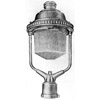
|
z 8225: post top mounting di-fractor
British Patents: 408419, 427835 and 424800.
Refractor: Z6609
Totally enclosed dust-proof lantern, specially designed for use with OSIRA lamps. The body is of ornamental dome appearance
made from heavy gauge spun copper. The detachable cast iron spigot cap is fixed to the cast iron ring on the main body of
the lantern by means of two side supporting tubular arms. The copper top is held by three milled brass bolts to the cast iron ring.
The optical system consists of a G.E.C. patent prismatic glass bowl refractor Z 6609. This refractor produces a high-grade
road brightness with absence of glare. The light distribution from it is non-axial asymmetric, the main beams being 160°
in plan. Also supplied with an axial asymmetric light distribution. It hs been more carefully designed by our Research
Laboratories, and besides being optically efficient, it also acts as a completely dust-proof outer globe. It is held to
the main body by a hinged cast ring which is secured by a lug and two spring fasteners, there is a slot in the ring to align
the refractor with the body, the axis of the arms being at right angles to the road. A G.E.S. porcelain lampholder can also
be used in two positions, so that the lantern is suitable for 250 and 400-watt OSIRA lamps. It is wired from the lampholder to
a terminal block by means of heat resisting leads. Access to this by removal of the copper top. The external finish of the
lantern is aluminium colour and all reflecting surfaces are heavily vitreous enamelled.
|
|
Z8225
|
250-400W MA/V
|
GES
|
Post Top
|
No Gear
|
1937 Catalogue
|
|
|
|
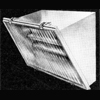
|
|
|
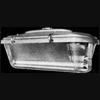
|
|
z 8245/47/48: two forty
|
|
Z8245
|
2x20W MCF
2x40W MCF
|
4xBC
|
Side Entry
|
Gear
|
Public Lighting #99
|
|
Z8247
|
2x20W MCF
2x40W MCF
|
4xBC
|
Top Entry
|
Gear
|
1953 advert
|
|
Z8248
|
2x20W MCF
2x40W MCF
|
4xBC
|
Top Entry
|
Gear
|
1953 advert
|
|
|
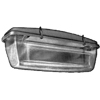
|
z 8254/55 | clearside z 8254/55
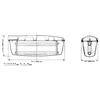
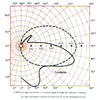
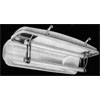 One of the "Clearside" range for Group B roads. Side road lighting; the lantern is designed for mounting at heights
between 15ft. and 18ft. and at a spacing of 100-120ft.The lantern is very suitable for use on housing estates, especially in
new towns. Available in side and top entry versions. The side entry design allows for the lantern to be elevated
slightly if this is required to add to the appearance of an installation.
One of the "Clearside" range for Group B roads. Side road lighting; the lantern is designed for mounting at heights
between 15ft. and 18ft. and at a spacing of 100-120ft.The lantern is very suitable for use on housing estates, especially in
new towns. Available in side and top entry versions. The side entry design allows for the lantern to be elevated
slightly if this is required to add to the appearance of an installation.
The body is one-piece silicon aluminium alloy die-casting. The gear and wiring necessary to operate the tubes is
fitted to a removable tray screwed to bosses in the body casting. The body also carries the two lampholder supports. An earthing
screw, porcelain terminal block and porcelain cable cleat are provided.
Light control is obtained by two 'Perspex' refractor plates. The prismatic sides of the plates are bonded, one to each inner
side of a 'Perspex' bowl. Both inner and outer surfaces of the bowl are smooth for easy cleaning. A white over-reflector is a
secondary component of the optical system. The inside of the body and the ends of the enclosing bowl are given a matt finish to
diffuse stray light and give the lantern a pleasing appearance. The enclosing bowl is held to the lantern body by stainless
steel toggle clips and toggle hinges. A tropicalised felt gasket between the body casting and bowl ensures a weatherproof
seal when the lantern is closed.
The alloy used is specially selected for its resistance to corrosion. Further protection is obtained by the use of pre-treatment
primer and silver top coat, stoved on.
|
|
Z8254
|
2x40W MFCA/U
|
4xBC
|
Side entry
|
Gear
|
1960s catalogue
1961 catalogue
1970s catalogue
|
|
Z8255
|
2x40W MCFA/U
|
4xBC
|
Top Entry
|
Gear
|
1960s catalogue
1961 catalogue
|
|
|
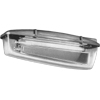
|
z 8256 | clearside z 8256
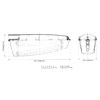
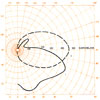
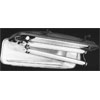 One of the "Clearside" range for Group B roads. For side road lighting; the lantern is designed for mounting at heights between 15 ft.
and 18ft. and spacing at 100-120 ft. The lantern is very suitable for use on housing estates, especially in new towns. The lantern requires
not less than 5 in. of horizontal unthreaded 1¼ B.S.P. When fully home two 7/16 in. Allen-type grub screws grip the barrel.
The design allows for the lantern to be elevated slightly if this is required to add to the appearance of an installation.
The lantern is a one-piece silicon aluminium alloy die-casting. The gear and wiring necessary to operate the tubes is fitted to a
removable tray screwed to bosses in the body casting. The body also carries the two lampholder supports. An earthing screw, porcelain terminal
block and porcelain cable cleat are provided. Light control is obtained by two "Perspex" refractor plates. The prismatic sides of the plates are
bonded, one to each inner side of a tapered 'Perspex' bowl. Both inner and outer surfaces of the bowl are smooth for easy cleaning.
A white over-reflector is a secondary component of the of the optical system. The inside of the body and the ends of the enclosing
bowl are given a matt finish to diffuse stray light and give the lantern a pleasing appearance. The enclosing bowl is held to the lanter
by stainless steel toggle clips and toggle hinges. A tropicalised felt gasket between the body casting and bowl ensures a weatherproof
seal when the lantern is closed. The alloy used is specially selected for its resistance to corrosion. Further protection is obtained by
the use of pre-treatment primer and silver top coat, stoved on.
One of the "Clearside" range for Group B roads. For side road lighting; the lantern is designed for mounting at heights between 15 ft.
and 18ft. and spacing at 100-120 ft. The lantern is very suitable for use on housing estates, especially in new towns. The lantern requires
not less than 5 in. of horizontal unthreaded 1¼ B.S.P. When fully home two 7/16 in. Allen-type grub screws grip the barrel.
The design allows for the lantern to be elevated slightly if this is required to add to the appearance of an installation.
The lantern is a one-piece silicon aluminium alloy die-casting. The gear and wiring necessary to operate the tubes is fitted to a
removable tray screwed to bosses in the body casting. The body also carries the two lampholder supports. An earthing screw, porcelain terminal
block and porcelain cable cleat are provided. Light control is obtained by two "Perspex" refractor plates. The prismatic sides of the plates are
bonded, one to each inner side of a tapered 'Perspex' bowl. Both inner and outer surfaces of the bowl are smooth for easy cleaning.
A white over-reflector is a secondary component of the of the optical system. The inside of the body and the ends of the enclosing
bowl are given a matt finish to diffuse stray light and give the lantern a pleasing appearance. The enclosing bowl is held to the lanter
by stainless steel toggle clips and toggle hinges. A tropicalised felt gasket between the body casting and bowl ensures a weatherproof
seal when the lantern is closed. The alloy used is specially selected for its resistance to corrosion. Further protection is obtained by
the use of pre-treatment primer and silver top coat, stoved on.
|
|
Z8256
|
2x40W MCF
|
4xBC
|
Side Entry
|
Gear
|
1960s catalogue
1964 catalogue
1970s catalogue
|
|
|
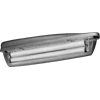
|
z 8260
One of the "Clearside" range for Group B roads. 1" B.S.P. plain side entry die-cast light alloy body housing the control
gear, lampholder supports and wiring harness. The 'Perspex' enclosing bowl is hinged to the body
and secured by two stainless steel catches. The optical system is a 'Perspex' enclosing bowl.
|
|
Z8260
|
2x20W MCF
2x40W MCF
|
4xBC
4xBC
|
Side Entry
|
Gear
|
1960s catalogue
1964 catalogue
1979 catalogue
|
|
|
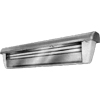
|
z 8270
One of the "Clearmain" range for Group A roads. The lantern body consists of two die-cast light alloy end pieces built on to a 9
in. aluminium alloy extrusion. Two sleeves are incorporated in the body to receive the bracket mounting
arm. All auxiliaries together with the wiring harness and lampholders are within the body on a detachable
die-cast aluminium gear tray. The gear is enclosed by a hinged aluminium over-reflector secured by
quick release turn buttons. The 'Perpsex' bowl is hinged to the lantern body and secured by
stainless steel spring catches. NOTE: A tapered 'Perspex' bowl can be supplied to special order.
The optical system comprises two 'Perspex' refractor plates cemented one to each inner
side of a 'Perspex' bowl.
|
|
Z8270
|
2x80W MCF
|
4xBC
|
Side Entry
|
Gear
|
1960s catalogue
1961 catalogue
|
|
Z8370
|
3x80W MCF
|
6xBC
|
Side Entry
|
Gear
|
1960s catalogue
1961 catalogue
|
|
Z8470
|
4x80W MCF
|
8xBC
|
Side Entry
|
Gear
|
1960s catalogue
1961 catalogue
|
|
|
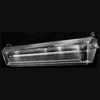
|
|
z 8281: two eighty
|
|
Z8281
|
2x80W MCF
|
4xBC
|
Stay Bar
|
Gear
|
1953 advert
|
|
|
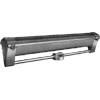
|
|
z 8285: railway platform lantern
|
|
Z8285
|
2x80W MCF
|
4xBC
|
Post Top
|
No Gear
|
1957 catalogue
|
|
|
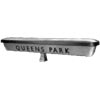
|
z 8288: railway platform lantern
One of the "Clearspace" range. Designed for railway platform lighting.
The lantern is arranged for post top mounting. The main lantern body
support is a webbed casting in aluminium alloy. The tube control gear is moutned on a removable tray.
The enclosing trough is blown in opal 'Perspex' and the top cover is moulded from glass fibre
reinforced plastic. The
sides of the enclosing trough may have the station name applied with 'Perspex' letters.
The light distribution is such that, when mounted in the
recommended manner, an average illumination of 1 lumen per sq. ft. over the whole platform area
is provided.
|
|
Z8288
|
2x80W MCF
|
4xBC
|
Post Top
|
Gear
|
1957 catalogue
1960s catalogue
|
|
|
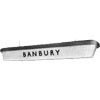
|
z 8290: under canopy lantern
One of the "Clearspace" range. Designed for railway platform lighting.
The lantern is arranged for
conduit suspension. The main lantern body support is provided by a steel strap moulded
into, and reinforcing, the glass fibre canopy. The tube control gear is mounted on a removable
tray. The enclosing trough is blown in opal 'Perspex'. The
sides of the enclosing trough may have the station name applied with 'Perspex' letters.
The light distribution is such that, when mounted in the
recommended manner, an average illumination of 1 lumen per sq. ft. over the whole platform area
is provided.
|
|
Z8290
|
2x80W MCF
|
4xBC
|
Top Entry
|
Gear
|
1957 catalogue
1960s catalogue
|
|
|
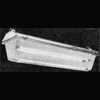
|
|
z 8381: three eighty
|
|
Z8381
|
3x80W MCF
|
6xBC
|
Stay Bar
|
Gear
|
1953 advert
|
|
|
|
|
|
|
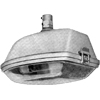
|
z 8401
One of the "Clearmain" range for Group A roads. 1¼ in. B.S.P. tapped top entry. Light alloy die-cast body carries the terminal block,
wiring, lampholder and the reflectors which make up the optikon. The lantern is intended for main road lighting
in the vicinity of airfields and falls within the specification issued by the Ministry of Transport. Has an aeroscreened
distribution. Two silvered glass mirrors held inside the body. A pressed heat-resisting glass dish makes the lantern enclosed.
|
|
Z8401
|
250-400W MA/V
250-400W MBF/U
|
GES
GES
|
Top Entry
|
No Gear
|
1960s catalogue
1961 catalogue
|
|
|
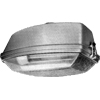
|
z 8403
One of the "Clearmain" range for Group A roads. 1¼ in. B.S.P. tapped top entry. Light alloy die-cast body carries the terminal block,
wiring, lampholder and the reflectors which make up the optikon. The lantern provides a cut-of light distribution. The lantern has
a cut-off distribution. Two silvered glass mirrors held inside the body.
A pressed heat-resisting glass dish makes the lantern enclosed.
|
|
Z8403
|
250-400W MA/V
250-400W MBF/U
|
GES
GES
|
Top Entry
|
No Gear
|
1960s catalogue
1961 catalogue
|
|
|
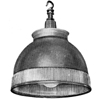
|
z 8405: pla-fractor lantern
Intended for secondary road lighting. The optical design is such that light is produced at angles
up to about 80 degrees from the vertical. The optical system is a single piece of pressed hard glass.
The upper portion is silvered to form a reflector and the lower portion forms a prismatic band
refractor which redirects the light reflected from the upper mirror portion in directions up
and down the roadway. The silvered dome of hte fitting concentrates some of the light
from the lamp on to the ring of prisms and some directly on to the surface of the
carriageway. The light falling on the prismatic part is first concentrated and
then spread the required amount by a series of shallow, external flues which results
in a diffusionof the bright area over the whole width of the prism and the
flute band.
An open type lantern specially designed for use with 80 and 125-watt OSIRA lamps. The body consists of a single
piece refractor of special G.E.C. heat-resisting glass, the reflector portion being silvered, coppered and lead-backed,
and is therefore weather resisting. The reflector contour is basned on the design of the well known G.E.C. P.L.A.
lantern, whilst the prisms mounted on the bottom band are of identical design to those on the G.E.C. prismatic bowl refractor
and produce a 160° non-axial asymmetric light distribution. The prismatic refractor contols in plan the light
which is reflected from the silvered portion of the glass, and well as direct light from the lamp, thus providing a
very efficient optical system.
The glass body Z 6557 is securely held in a cast-iron top by an internal copper ring. The cast top has
"Street Side" marked on it, and a locating lug on the reflector ensures this being replaced in the correct position
after cleaning.
The lantern is fitted with a 3-slot B.C. lampholder. This is carried on a reversible nipple, which when screwed home
ensures the correct focal position for either the 80 or 125-watt OSIRA lamp.
The lantern can also be used with OSRAM tungsten filament lamps, and it is then necessary to employ an E.S. lampholder.
The catalogue number of the lantern when employed with filament lamps is Z 5405.
|
|
Z5405
|
60-200W GLS
|
ES
|
Top Entry
|
No Gear
|
1937 Catalogue
|
|
Z8405
|
80-125W MB/V
|
3BC
|
Top Entry
|
No Gear
|
1937 Programme
1937 Paper
1937 Catalogue
|
|
|
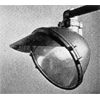
|
|
z 8411: uniway | z 8411: uni-directional
British Patent: 523630.
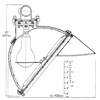
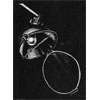
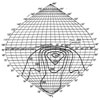 Entirely new system of lighting recently evolved by the GEC in 1938 for dual carriageways.
First installation on Chertsey Road, Twickenham used 250W Osira lamps.
Fitted with 125W Osira lamps and mounted at 25'.
Light is thrown in only one direction only - towards oncoming traffic. This means there
is absolutely no visible light on the other carriageway to distract drivers' attention.
Because of the elimination of wasted light the 125W lamp gives visibilities which would
normally be obtained with 400W lamps. Made of light alloys and totally enclosed.
The front glass is smooth. Over 100 sq. ins. of flashed area provided - every other
lantern in existence has a flashed area of only 60-80 sq. ins.
The outside surface of the glass is smooth to facilitate
cleaning. The "flash" covers an area of more than 100 sq. ins. whereas most ordinary 400W lanterns have a flashed area of only
60-80 sq. ins. Thus, surface brightness of the lantern per square inch is considerably reduced owing to its greater light emitting
area. The lantern is in two parts - a detachable top which the brack arm slides horizontally, giving side-entry mounting, and
the main lantern body. Both parts are made of light alloy castings and the complete unit weights on 15 lbs. The Uniway
lantern is totally enclosed, non-ventilated and completely weatherproof. The front is hinged at one side and secured by simple postive
action snap catches. Access to the lamp and reflector is afforded by the hinged front. The body can be rotated on the bracket arm
so the light can be accurately directed towards the road. For this purpose an orthoptic sighting device is provided to enable
the lantern to be correctly aligned. The lamp is automatically centred and is firmed held in the correct focal position. The
lantern is simply erected, as the top, which weighs only 2lbs., can be slid on the bracket arm and there locked into position.
The leads can be wired to the lampholder in a few moments and the body is connected by self-locking nuts.
Cited by the GEC as one of their important post-war lantern designs.
Inter-way and immediate post-war
emphasis has changed: Although, for the present, authorities are chiefly
interested in the re-instatement of pre-war lighting equipment, the
lighting of arterial roads of the dual carriageway and one-way types will have to
be considered. For these the GEC designed, shortly before the war, a lantern known
as the Uniway specifically to light double carriageway roads. Lighting results comparable with those normally obtained with
400W lamps can be obtained with only 125W in each lantern, the light being directed only
one way towards the traffic. This enables roads to be properly lighted for which the cost had
previously been prohibitive. Revealing power is actually improved compared with normal installations
and driving comfort is increased, as the only light sources to be seen are those on the drivers' own
carriageway. The whole of the light is reflected in one direction towards the oncoming traffic and an
extremely even flash is obtained by the use of a specially designed diffusing glass. This is smooth
on the outside to facilitate cleaning. It is totally enclosed, non-ventilated and completely weatherproof.
The front is hinged on one side with a catch on the other, giving access to the lamp and the reflector.
The body can be rotated universally on the bracket arm so that the light can be accurately directed.
Entirely new system of lighting recently evolved by the GEC in 1938 for dual carriageways.
First installation on Chertsey Road, Twickenham used 250W Osira lamps.
Fitted with 125W Osira lamps and mounted at 25'.
Light is thrown in only one direction only - towards oncoming traffic. This means there
is absolutely no visible light on the other carriageway to distract drivers' attention.
Because of the elimination of wasted light the 125W lamp gives visibilities which would
normally be obtained with 400W lamps. Made of light alloys and totally enclosed.
The front glass is smooth. Over 100 sq. ins. of flashed area provided - every other
lantern in existence has a flashed area of only 60-80 sq. ins.
The outside surface of the glass is smooth to facilitate
cleaning. The "flash" covers an area of more than 100 sq. ins. whereas most ordinary 400W lanterns have a flashed area of only
60-80 sq. ins. Thus, surface brightness of the lantern per square inch is considerably reduced owing to its greater light emitting
area. The lantern is in two parts - a detachable top which the brack arm slides horizontally, giving side-entry mounting, and
the main lantern body. Both parts are made of light alloy castings and the complete unit weights on 15 lbs. The Uniway
lantern is totally enclosed, non-ventilated and completely weatherproof. The front is hinged at one side and secured by simple postive
action snap catches. Access to the lamp and reflector is afforded by the hinged front. The body can be rotated on the bracket arm
so the light can be accurately directed towards the road. For this purpose an orthoptic sighting device is provided to enable
the lantern to be correctly aligned. The lamp is automatically centred and is firmed held in the correct focal position. The
lantern is simply erected, as the top, which weighs only 2lbs., can be slid on the bracket arm and there locked into position.
The leads can be wired to the lampholder in a few moments and the body is connected by self-locking nuts.
Cited by the GEC as one of their important post-war lantern designs.
Inter-way and immediate post-war
emphasis has changed: Although, for the present, authorities are chiefly
interested in the re-instatement of pre-war lighting equipment, the
lighting of arterial roads of the dual carriageway and one-way types will have to
be considered. For these the GEC designed, shortly before the war, a lantern known
as the Uniway specifically to light double carriageway roads. Lighting results comparable with those normally obtained with
400W lamps can be obtained with only 125W in each lantern, the light being directed only
one way towards the traffic. This enables roads to be properly lighted for which the cost had
previously been prohibitive. Revealing power is actually improved compared with normal installations
and driving comfort is increased, as the only light sources to be seen are those on the drivers' own
carriageway. The whole of the light is reflected in one direction towards the oncoming traffic and an
extremely even flash is obtained by the use of a specially designed diffusing glass. This is smooth
on the outside to facilitate cleaning. It is totally enclosed, non-ventilated and completely weatherproof.
The front is hinged on one side with a catch on the other, giving access to the lamp and the reflector.
The body can be rotated universally on the bracket arm so that the light can be accurately directed.
|
|
Z8411
|
80-125W MB/V
|
3BC
|
Top Entry
|
No Gear
|
1939 Journal
1939 Journal
1939 Journal
1939 programme
1939 advert
1939 Paper
1940 Journal
1944 Journal
1945 programme
1945 Paper
1946 program
1946 advert
1947 advert
1947 book
1948 catalogue
1951 book
|
|
|
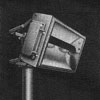
|
z 8417
One of the "Clearspace" range. Designed for railway platform lighting.
Anodised aluminium reflector rigidly fixed betwen two aluminium alloy end
castings. The front is of toughened clear plate glass sealed into an aluminium frame. A shield
inside the lantern limits glare from the lamps. The lantern is supplied with a bracket and
clamps to fit a 3" dia. pole.
Anodised aluminium main reflector. Two anodised aluminium
end reflectors give the lantern a very wide beam angle in the horizontal plane
|
|
Z8417
|
2x400W MBF/U
|
2xGES
|
Top Entry
|
No Gear
|
1960s catalogue
|
|
|
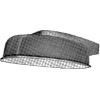
|
z 8420
One of the "Clearmain" range for Group A roads. 1¼ in. plain side entry. Lantern body consists of a die-cast light
alloy canopy and pressed aluminium main body. Lantern canopy carries clamping bolts, porcelain termainal block and lampholder.
Heat resisting flat glass held to the main pressing. It has a cut-off distribution. The contour of the main body pressing
is carefully designed so that each side of body forms a long curved reflector producing the required cross-over distribution.
|
|
Z8420
|
250-400W MBF/U
|
GES
|
Side Entry
|
No Gear
|
1960s catalogue
1961 catalogue
|
|
|
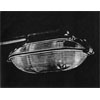
|
|
z8421/2: double dish lantern / dioptrion
British Patents: 507688, 585561, 420499 and 436478.
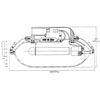
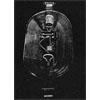
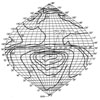 First introduced in 1945 as the "Double Dish Lantern." First installation was in Portsmouth. Gives a controlled cut-off
form of light distribution. Described as a complete
break from conventional design and strikes a new note in modern outline, mechanical
construction and performance. The optical system comprises two prismatic glass oval
dishes, smooth outside to facilitate cleaning, the lower hinged from the upper for
access to the lamp. A top cast supporting body provides a side entry fixing, and
supports internally a magnetic deflector, lampholder and lamp carrier. Renamed the
"Dioptrion" in 1946. The die-cast light alloy body supports two large dish-shaped refractors,
so that over 90° of the lantern surface is transucent. Though most of the upper surface
of the lantern is optical glassware, the design of the refractor is such that practically no
light is directed above the horizontal.
First introduced in 1945 as the "Double Dish Lantern." First installation was in Portsmouth. Gives a controlled cut-off
form of light distribution. Described as a complete
break from conventional design and strikes a new note in modern outline, mechanical
construction and performance. The optical system comprises two prismatic glass oval
dishes, smooth outside to facilitate cleaning, the lower hinged from the upper for
access to the lamp. A top cast supporting body provides a side entry fixing, and
supports internally a magnetic deflector, lampholder and lamp carrier. Renamed the
"Dioptrion" in 1946. The die-cast light alloy body supports two large dish-shaped refractors,
so that over 90° of the lantern surface is transucent. Though most of the upper surface
of the lantern is optical glassware, the design of the refractor is such that practically no
light is directed above the horizontal.
Main road lighting; 25 ft. mounting height; spacing 120 ft optimum, but can be used up to 150 ft. maximum; road width 30-40 ft. For
roads over 40 ft. in width this lantern, with its horizontal burning lamp, will give better results than would be obtainable from
a lantern with a vertical burning light source. Side entry only. The lantern body is die-cast light alloy. The body carries the lampholder, terminal block, cable clamp, heat-resisting wiring, lamp steady, reflector
plate and magnetic deflector. A water baffle and drainage hole are provided to carry off any water running along the bracket. An
earthing screw is provided. It has a porcelain G.E.S lampholder, wired with heat-resisting wire to a terminal block. Immediately above the lamp and hinged at the holder end is a non-magnetic polished reflector. Release of teh catch
holding this allows it to swing down, thus giving access to the bracket entry and terminal block. On the reflector plate is mounted the magnetic deflector which is in series with the lamp and consumes 1 watt. The reflector
plates serves the dual purpose of reflecting light and preventing rising hot air from over-heating the deflector. The use of a magnetic
deflector enables a MA/H lamp with a hard glass outer jacket to be operated at the same efficiency as the normal MA/V lamp. The pressed
prismatic refractors are made of heat-resisting glass and are smooth externally except for three steps in the lower refractor.
The upper refractor is held by the body, and the lower refractor is supported by a steel rim which is held at each end by
cantilever springs. Catches on each spring give a toggle action, while the catch at the bracket end can be unhooked, allowing
the lower refractor to swing down sogiving access to the lantern interior. A special gasket cemented to the lip of the lower refractor
ensures a weatherproof seal when the lantern is closed. The alloy used is specially selected for its
resistance to corrosion. Further protection is obtained by the use of a suitable primer, undercoat and matt aluminium finish top coat.
|
|
Z8421
|
250W MA/H
|
GES
|
Side Entry
|
No Gear
|
1945 programme
1946 program
1946 advert
1947 advert
1947 book
1947 programme
1947 journal
1947 advert
1948 catalogue
1948 catalogue
|
|
Z8422
|
400W MA/H
|
GES
|
Side Entry
|
No Gear
|
1945 programme
1946 program
1946 advert
1947 advert
1947 book
1947 programme
1947 journal
1947 advert
1948 catalogue
1948 catalogue
|
|
|
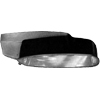
|
|
|
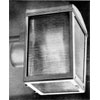
|
|
z 8425/5: horizal
British Patents: 507688, 519484, 420499, 436478 and 408419.
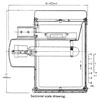
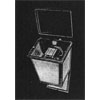
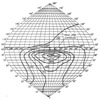
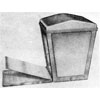 First demonstrated at the Public Works Congress in 1937 (November 15th-20th) and introduced in 1938 for the horizontal burning of Osira High Pressure Mercury Vapour Lamps. Made from light alloys and totally enclosed.
Side mounted with the bracket gripped by drawbolts. Lamp is burned horizontally, the arc being
controlled by a series low loss magnetic deflector.
Optical system consists of two flat prismatic glass plates, sealed hermetically to outer diffiusing
panels with a special plastic cement, thereby preventing dust being deposited in the prisms.
The plates are so arranged that all prisms face inwards so there
are no surfaces to collect dust or dirt. Therefore a smooth face is always presented for cleaning.
Has a controlled cut-off distribution
which limits the spacing to 150 feet. The lantern is totally enclosed, non-ventilated
and completely weatherproof. The side entry method of suspension was developed by the
GEC in early 1938. Cleaning is simple as all surfaces smooth inside and out except for the
hinged bottom panel with is shallowly fluted within. The prismatic plates (sandwiches) are built into
the lantern sides. The magnetic deflector is mounted above a high reflectivity, bright anodised
aluminium reflector. Weights 33lbs. Cited by the GEC as one of the important post-war lanterns.
First demonstrated at the Public Works Congress in 1937 (November 15th-20th) and introduced in 1938 for the horizontal burning of Osira High Pressure Mercury Vapour Lamps. Made from light alloys and totally enclosed.
Side mounted with the bracket gripped by drawbolts. Lamp is burned horizontally, the arc being
controlled by a series low loss magnetic deflector.
Optical system consists of two flat prismatic glass plates, sealed hermetically to outer diffiusing
panels with a special plastic cement, thereby preventing dust being deposited in the prisms.
The plates are so arranged that all prisms face inwards so there
are no surfaces to collect dust or dirt. Therefore a smooth face is always presented for cleaning.
Has a controlled cut-off distribution
which limits the spacing to 150 feet. The lantern is totally enclosed, non-ventilated
and completely weatherproof. The side entry method of suspension was developed by the
GEC in early 1938. Cleaning is simple as all surfaces smooth inside and out except for the
hinged bottom panel with is shallowly fluted within. The prismatic plates (sandwiches) are built into
the lantern sides. The magnetic deflector is mounted above a high reflectivity, bright anodised
aluminium reflector. Weights 33lbs. Cited by the GEC as one of the important post-war lanterns.
For main road lighting; 25 ft. mounting height; spacing 120 ft optimum, but can be used up to 150 ft. maximum; road width 30-40 ft. For
roads over 40 ft. in width this lantern, with its horizontal burning lamp, will give better results than would be obtainable from
a lantern with a vertical burning light source. Side entry. Requires a minimum length of 6 in. horizontal unthreaded 1¼ in. gas
barrel When fully home, two 7/16 in. Allen type grub screws grip the barrel. Made from a die-cast light alloy body which carrys the
lampholder, terminal block, lamp steady, reflector plate and magnetic deflector. A water baffle and drainage hole a provided to carry off
any water running along the bracket. A pressed light alloy top gives access to the deflector and an earthing screw is provided.
The porcelain G.E.S. lampholder is wired with heat-resisting wire to a terminal block. The lampholder is pivoted to assist in lamp
withdrawl. Immediately above the lamp is a non-magnetic polished reflector. On the reflector plate is mounted the magnetic deflector which
is in series with the lamp and consumes 1 watt. The reflector
plates serves the dual purpose of reflecting light and preventing rising hot air from over-heating the deflector. The use of a magnetic
deflector enables a MA/H lamp with a hard glass outer jacket to be operated at the same efficiency as the normal MA/V lamp.
There are two windows each fitted with prismatic glass refractors and sealed with lined diffusing cover glasses so that all glass surfaces
are smooth. These windows face up and down the road. An opal panel in the front of the lantern faces across the road whilst
a hinged door fitted with lined diffusing glass, underneath the lantern, gives access to the interior. The alloy used is specially selected
for its resistance to corrosion. Further protection is obtained by the use of a suitable primer, undercoat and matt aluminium finish top coat.
|
|
Z8424
|
250W MA/H
|
GES
|
Side Entry
|
No Gear
|
1937 Journal
1938 Advert
1938 Programme
1939 Programme
1939 Paper
1944 Journal
1945 Paper
1948 Catalogue
1948 Catalogue
|
|
Z8425
|
400W MA/H
|
GES
|
Side Entry
|
No Gear
|
1937 Journal
1938 Advert
1938 Programme
1939 Programme
1939 Paper
1944 Journal
1945 Paper
1948 Catalogue
1948 Catalogue
|
|
|
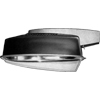
|
z 8426
One of the "Clearmain" range for Group A roads. 1¼ in. plain side entry. Lantern body consists of a die-cast light
alloy canopy and pressed
aluminium main body. Lantern canopy carries clamping bolts, porcelain termainal block and lampholder. A mounted tapered
'Perspex' dish is held to the main pressing. The dish has clear sides and ends with an opalised area below the lamp.
The lantern has a medium angle beam distribution. The contour of the main body pressing is carefully designed so that
each side of the body forms a long curved reflector producing the required cross-over distribution.
|
|
Z8426
|
250-400W MBF/U
|
GES
|
Side Entry
|
No Gear
|
1960s catalogue
1961 catalogue
|
|
|
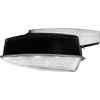
|
z 8427
One of the "Clearmain" range for Group A roads. 1¼ in. plain side entry. Lantern body consists of a die-cast light alloy canopy and pressed
aluminium main body. Lantern canopy carries clamping bolts, porcelain termainal block and lampholder. A mounted tapered
'Perspex' dish is held to the main pressing. Has a cut-off distribution. The contour of the main body pressing is carefully
designed so that each side of the body forms a long curved reflector producing the required cross-over distribution.
|
|
Z8427
|
250-400W MBF/U
|
GES
|
Side Entry
|
No Gear
|
1960s catalogue
1961 catalogue
|
|
|
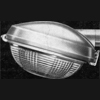
|
z 8430
One of the "Clearmain" range for Group A roads. 1¼ in. plain side entry. Light alloy die-cast body housing the reflectors, lampholder, terminal
block, wiring, lamp steady, reflector plate and universal magnetic deflector. The refractor bowl is held in a die-cast
light alloy ring hinged to the body and secured by a stainless steel toggle catch. The optical system has a
medium angle beam distribution and comprises a pressed prismatic glass refractor bowl.
|
|
Z8430
|
250-400W MA/V
|
GES
|
Side Entry
|
No Gear
|
1958 advert
1960s catalogue
1961 catalogue
|
|
|
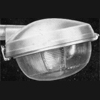
|
z 8430cm
One of the "Clearmain" range for Group A roads. 1¼ in. plain side entry. Light alloy die-cast body housing the reflectors, lampholder, terminal
block and wiring. The refractor bowl is held in a die-cast
light alloy ring hinged to the body and secured by a stainless steel toggle catch. The optical system has a
medium angle beam distribution and comprises a pressed prismatic glass refractor bowl.
|
|
Z8430CM
|
250-400W MBF/U
250-400W SON
|
GES
GES
|
Side Entry
|
No Gear
|
1958 advert
1960s catalogue
1961 catalogue
1979 catalogue
|
|
|
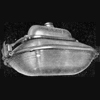
|
|
|
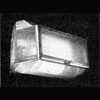
|
|
|
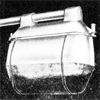
|
|
z8433/4: totally enclosed cut-off lantern / blown-glass cut-off lantern / blown cut-off lantern
British Patent: 420499.
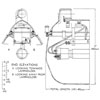
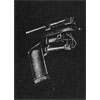
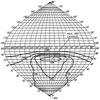 Developed in 1939 and cited by the GEC as an important post-war lantern.
The principle of total enclosure has been extended
to lanterns which previously
have not been available in this form, for example, "Cut-Off" lanterns for horizontally
burning electric discharge lamps which have been usually constructed with exposed
reflectors mounted in open metal housings. The glassware is blown as a complete globe,
the upper part of which is silvered to form the reflecting surface. On the lower portion a suitable
diffusing finish is moulded in order to break up striations. A glass of this type has the further
feature that the silvered surfaces are permanently fixed relative to one another. No troubles can
therefore ensue from inaccurate assembly of the reflectors. The lantern is designed on similar
lines to the Difractor namely: it has a main body casting, side entry
mounting, and the casting supports the lower globe with a gasket. A magnetic deflector of
similar type to that of the Horizal is used.
Developed in 1939 and cited by the GEC as an important post-war lantern.
The principle of total enclosure has been extended
to lanterns which previously
have not been available in this form, for example, "Cut-Off" lanterns for horizontally
burning electric discharge lamps which have been usually constructed with exposed
reflectors mounted in open metal housings. The glassware is blown as a complete globe,
the upper part of which is silvered to form the reflecting surface. On the lower portion a suitable
diffusing finish is moulded in order to break up striations. A glass of this type has the further
feature that the silvered surfaces are permanently fixed relative to one another. No troubles can
therefore ensue from inaccurate assembly of the reflectors. The lantern is designed on similar
lines to the Difractor namely: it has a main body casting, side entry
mounting, and the casting supports the lower globe with a gasket. A magnetic deflector of
similar type to that of the Horizal is used.
For main road lighting, roundabouts, roads in the vicinity of airfields, dock and waterside lighting. The lantern has a cut-off distribution
which virtually eliminates glare. The peak candle power is about 70 deg. to teh vertical and above this the intensities fall
off very rapidly. These characteristics make the lantern particularly suitable for waterside lighting where for navigational purposes it is
generally necessary for ligth to be shielded. Excellent results are also obtained at roundabouts where a cut-off distribution
assists visibility. It is particularly important that lighting on roads near airports should not be mistaken for any of the airfield lighting and
on such roads it is therefore genreally necessary to use lanterns giving this form of cut-off light distribution. Lanterns should be
mounted at 25 ft. and spaced not more than 95-100 ft. apart, road width up to 50 ft. Side entry. Requires a minimum length of 16 in. horizontal unthreaded 1¼ in. gas barrel. When fully home, two 7/16 in. Allen
type grub screws grip the barrel. Made from a die-cast light alloy body. Totally enclosed lantern. The body carries terminal block, wiring,
magnetic deflector, over reflector, focusing gear, lampholder and lamp steady. An earthing screw is provided. The porcelain G.E.S. lampholder is wired
with heat-resisting wire to a terminal block. Immediately above the lamp is a non-magnetic polished reflector. On the reflector plate is mounted the magnetic deflector
which is in series with the lamp and consumes 1 watt. Three focal positions are provided giving main beam at 60 deg., or 65 deg., or 70 deg.
The glassware is a one-piece blowing, the upper portion being silvered, copper and lead-backed whilst the lower half has a slightly
rimpled surface. The contour of the silvered portion has been very carefully designed to make maximum use of light from the lamp.
Two stainless steel expanding springs act as an addition support for the glassware. The light alloy used is specially selected for its
resistance to corrosion. Further protection is obtained by the use of a suitable primer, undercoat and matt aluminium finish top coat.
|
|
Z8433
|
250 MA/H
|
GES
|
Side Entry
|
No Gear
|
1939 Paper
1944 Journal
1945 Programme
1945 Paper
1948 Catalogue
1953 Advert
|
|
Z8434
|
400 MA/H
|
GES
|
Side Entry
|
No Gear
|
1939 Paper
1944 Journal
1945 Programme
1945 Paper
1948 Catalogue
1953 Advert
|
|
|
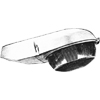
|
|
z 8438
|
|
Z8438
|
250-400W MBF/U
250-400W SON
|
GES
GES
|
Side Entry
|
Gear
|
1979 catalogue
|
|
|
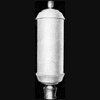
|
|
z 8442: forty forty
|
|
Z8442
|
4x20W MCF
4x40W MCF
|
8xBC
|
Post Top
|
Gear
|
1953 advert
|
|
|
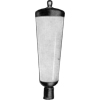
|
|
z ????: post-top decorative lantern
|
|
Z????
|
4x40W MCF
|
8xBC
|
Post Top
|
Gear
|
1956 advert
|
|
|
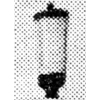
|
|
|

|
z ????: fluorescent lantern
Side entry with the bracket entirely sealed within the body.
|
|
Z????
|
2-4x80W MCF
|
4-8xBC
|
Side Entry
|
Gear
|
Public Lighting #92
|
|
|
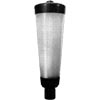
|
z 8451
One of the "Clearspace" range for Group B roads. Post top spigot cap for 3" x 3" spigot. The
body consists of an opal
'Perspex' tapered cylinder through which run straps carrying the tube operating gear. A cast
iron spigot cap is secured to the straps and a double aluminium spinning fits over the
whole assembly to make the lantern totally enclosed. The tapered opal 'Perspex' cylinder
provides a diffusive symmetric light distribution
|
|
Z8451
|
4 x 40W MCF/U
|
8 x BC
|
Post Top
|
Gear
|
1960s catalogue
1964 catalogue
|
|
|
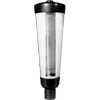
|
z 8452: post-top decorative lantern
One of the "Clearspace" range for Group B roads. Post top spigot cap for 3" x 3" spigot. The body consists of a
'Perspex' tapered cylinder through which run straps carrying the tube operating gear. A cast
iron spigot cap is secured to the straps and a double aluminium spinning fits over the
whole assembly to make the lantern totally enclosed. The optical system comrpises a
tapered 'Perspex' cylinder incorporating two vertically mounted 'Perspex' refractor plates.
|
|
Z8452
|
2 x 40W MCF/U
4 x 40W MCF/U
|
4 x BC
8 x BC
|
Post Top
|
Gear
|
1960s catalogue
1964 catalogue
1974 catalogue
|
|
|
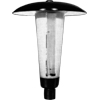
|
z 8453
One of the "Clearspace" range for Group B roads. Post top spigot cap for 3" x 3" spigot. The body consists of a
'Perspex' tapered cylinder through which run straps carrying the tube operating gear. A cast
iron spigot cap is secured to the straps and a double aluminium 'mushroom' shaped spinning
fits over the whole assembly to make the lantern totally enclosed. The optical system comrpises a
tapered 'Perspex' cylinder incorporating two vertically mounted 'Perspex' refractor plates.
|
|
Z8453
|
2 x 40W MCF/U
|
4 x BC
|
Post Top
|
Gear
|
1960s catalogue
1964 catalogue
|
|
|
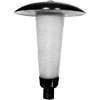
|
z 8454: post-top decorative lantern
One of the "Clearspace" range for Group B roads. Post top spigot cap for 3" x 3" spigot.
The body consists of an opal
'Perspex' tapered cylinder through which run straps carrying the tube operating gear. A cast
iron spigot cap is secured to the straps and a double aluminium 'mushroom' shaped spinning fits
over the whole assembly to make the lantern totally enclosed. The optical system comrpises a
tapered opal 'Perspex' cylinder which provides a diffusive symmetric light distribution.
|
|
Z8454
|
2 x 40W MCF/U
4 x 40W MCF/U
|
4 x BC
8 x BC
|
Post Top
|
Gear
|
1960s catalogue
1964 catalogue
1974 catalogue
|
|
|
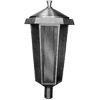
|
z 8455: post-top decorative lantern
One of the "Clearspace" range for Group B roads. Post top spigot cap for 2 3/8" x 3" spigot. The body is build round a
¾" B.S.P. centre tube. The tube operating gear is housed within the lantern. The outer
and inner base of the lantern is pressed as one piece in brass. The glazing bars and door are
extruded brass. The top pressing and spinning are copper. The optical system is
two super-purity anodised aluminium reflectors combined with
two vertically mounted 'Perspex' refractor plates. The remaining panels are glazed with
Morocco glass.
|
|
Z8455
|
2 x 40W MCF/U
4 x 40W MCF/U
|
4 x BC
8 x BC
|
Post Top
|
Gear
|
1960s catalogue
1964 catalogue
1974 catalogue
|
|
|
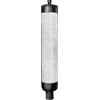
|
z 8480: post-top decorative lantern
One of the "Clearmain" range for Group A roads. The lantern body is essentially a 'Perspex' cylinder, through which runs a steel barrel screwed at
its lower end into a cast iron spigot cap. The lower copper spinning encloses the tube operating gear which is supplied
with the lantern. The 'Perspex' cylinder fits over this assembly. The top copper spinning
is secured by a spun copper finial. The opal 'Perspex' cylinder provides a diffusive symmetric light distribution.
|
|
Z8480
|
4x80W MCF
|
8xBC
|
Post Top
|
Gear
|
1956 advert
1959 advert
1960s catalogue
1961 catalogue
1961 advert
|
|
|
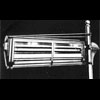
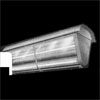
|
z 8481: four eighty lantern
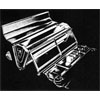
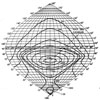 First exhibited at the APLE's 1947 Conference in Southport. Developed from the seven tube prototypes installed
along Brompton Road the previous year. Made from a non-ferrous material having high reflectivity anodised aluminium reflectors.
Access to the lamps is obtained through two hinged doors which have catches holding them when they are in the open position.
The doors hinge upwards. Chokes and capacitors are housed under the top canopy which conceals the supporting tubes. The lamps
are arranged on a two-lamp circuit so that unity power factor is obtined.
First exhibited at the APLE's 1947 Conference in Southport. Developed from the seven tube prototypes installed
along Brompton Road the previous year. Made from a non-ferrous material having high reflectivity anodised aluminium reflectors.
Access to the lamps is obtained through two hinged doors which have catches holding them when they are in the open position.
The doors hinge upwards. Chokes and capacitors are housed under the top canopy which conceals the supporting tubes. The lamps
are arranged on a two-lamp circuit so that unity power factor is obtined.
25 ft. mounting height; spacing 100-150 ft.; broad roads up to 40 ft. The lantern, Z.8481,
is approximately equivalent to a normal main road lantern with a 400 w. H.P.M.V. lamp
and is used the same way. On account of its good colour rendering, it is most suitable for civic centres,
main shopping areas and promenade lighting at seaside resorts. The lantern has a very low surface
brightness.
It's primarily designed for mounting on a concrete or steel pole. It requires a horizontal
1½ in. gas barrel projecting 5 ft. 7 in. from the column. The last inch must be threaded. The
lantern, which is a sliding fit on the barrel, is held back against the column by a nut which screws
on to the threaded end of the bracket. When the latnern is in position water entry along the barrel is prevented by two packing
glands. Two Allen grub screws finally lock the lantern on to the tube, an additional fixing at the bottom
of the lantern secures it in a vertical position. A triangular plate on the front end of the lantern
is provided, when required, to give anchorage to wind stays.
When used for catenary wire suspension, double spanwire clamps are bolted on to each end castings,
and the two caps are supplied to conceal the sockets for the more normal bracket fixing.
The body consists of two similar light alloy cast ends rigidly connected together by a top member of
sheet steel and a lower member of light alloy. The light alloy sheet roof, which is secured by six nuts,
is removable giving the access required for erection. it also discloses the detachable tray on
which are moutned the chokes, capacitors and starters wired to the lampholders. This tray with its
auxiliaries completely wired can be installed after the lantern has been erected and can be removed
for servicing at any time. An earthing screw is provided. There is a full-length door of a cast light alloy, glazed with clear Perspex acrylic sheet on
each side of the lantern. The doors are hinged at the top and stays are provided to hold them open,
giving access to the lantern interior for cleaing and lamp replacement.
There is a full-length door of a cast light alloy, glazed with clear Perspex acrylic sheet on
each side of the lantern. The doors are hinged at the top and stays are provided to hold them open,
giving access to the lantern interior for cleaing and lamp replacement.
The lamps are carried in specially positioned spring clips so that no focusing is necessary.
On each side of the lantern there are two trough reflectors with specially designed contours.
These are firmly scrwed to shaped formers, one integral with each end casting and one in the centre.
The reflectors are constructed of super purity aluminium, polished, anodised and electrically
brightened and have a very high reflectivity. The reflectors are removable.
The alloy used is specially selected for its resistance to corrosion. Further protection is
obtained by the use of a suitable primer, undercoat and glossy aluminium finish top coat.
It weighs 100 lbs. (45.3 kgs.) (without auxiliaries) or 130 lbs. (59.0 kgs.) (complete with all auxiliaries).
(1947 advert pictures the lantern from the opposite end with simplified endplate. This was probably
done to make it look more modern and sleek to compete with competitors).
|
|
Z8481
|
4x80W MCF/U
|
8xBC
|
Side Entry / Spanwire
|
Gear
|
1947 conference
1947 advert
1947 journal
1948 catalogue
1948 catalogue
|
|
|
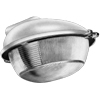
|
z 8490
One of the "Clearside" range for Group B roads. 1" B.S.P. plain side entry die-cast light alloy body. The mounting angle and bowl is
horizontal. A hinged
ring secured by a toggle catch holds the outer bowl. The optical system is a pressed prismatic
glass bowl refractor.
|
|
Z8490
|
60-200W GLS
|
BC
|
Side entry
|
No Gear
|
1960s catalogue
1964 catalogue
|
|
Z8491
|
80-125W MB/U
80-125W MBF/U
|
3BC
3BC
|
Side entry
|
No Gear
|
1960s catalogue
1964 catalogue
|
|
Z8492
|
60-200W GLS
|
ES
|
Side entry
|
No Gear
|
1960s catalogue
1964 catalogue
|
|
|
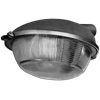
|
z 8495
One of the "Clearside" range for Group B roads. 1" B.S.P. plain side entry die-cast light
alloy body. The mounting angle is horizontal and the bowl is canted up 15°. A hinged
ring secured by a toggle catch holds the outer bowl. The optical system is a pressed prismatic
glass bowl refractor.
|
|
Z8495
|
60-200W GLS
|
BC
|
Side entry
|
No Gear
|
1960s catalogue
1964 catalogue
|
|
Z8496
|
80-125W MB/U
80-125W MBF/U
|
3BC
3BC
|
Side entry
|
No Gear
|
1960s catalogue
1964 catalogue
|
|
Z8497
|
60-200W GLS
|
ES
|
Side entry
|
No Gear
|
1960s catalogue
1964 catalogue
|
|
|
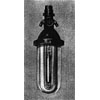
|
z 8500
Exterior lighting fitting for OSIRA (MA/V) lamps. Symmetric distribution. Only recommended for street lighting if the standard
clear well glass is replaced with a lightly obscured type giving a distributing distribution.
Porcelain enamel steel reflectors,
green outside, white inside. The possibility of
lamp failures due to water-drip or condensation is entirely eliminated by the cast iron top.
The terminal box is wired to the G.E.S. porcelain holder with heat-resisting flexibles. A
heat-resisting well glass protects the lamp.
|
|
Z8500
|
400W MA/V
|
GES
|
Top entry
|
No Gear
|
1935 catalogue
|
|
Z8510
|
250W MA/V
|
GES
|
Top entry
|
No Gear
|
1935 catalogue
|
|
|
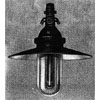
|
z 8501
Exterior lighting fitting for OSIRA (MA/V) lamps. Distributing distribution. Only recommended for street lighting if the standard
clear well glass is replaced with a lightly obscured type giving a distributing distribution.
Porcelain enamel steel reflectors,
green outside, white inside. The possibility of
lamp failures due to water-drip or condensation is entirely eliminated by the cast iron top.
The terminal box is wired to the G.E.S. porcelain holder with heat-resisting flexibles. A
heat-resisting well glass protects the lamp.
|
|
Z8501
|
400W MA/V
|
GES
|
Top entry
|
No Gear
|
1935 catalogue
|
|
Z8511
|
250W MA/V
|
GES
|
Top entry
|
No Gear
|
1935 catalogue
|
|
|
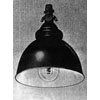
|
z 8502
Exterior lighting fitting for OSIRA (MA/V) lamps. Dispersive distribution. Only recommended for street lighting if the standard
clear well glass is replaced with a lightly obscured type giving a distributing distribution.
Porcelain enamel steel reflectors,
green outside, white inside. The possibility of
lamp failures due to water-drip or condensation is entirely eliminated by the cast iron top.
The terminal box is wired to the G.E.S. porcelain holder with heat-resisting flexibles. A
heat-resisting well glass protects the lamp.
|
|
Z8502
|
400W MA/V
|
GES
|
Top entry
|
No Gear
|
1935 catalogue
|
|
Z8512
|
250W MA/V
|
GES
|
Top entry
|
No Gear
|
1935 catalogue
|
|
|
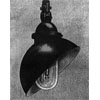
|
z 8503
Exterior lighting fitting for OSIRA (MA/V) lamps. Parabolic angle distribution. Only recommended for street lighting if the standard
clear well glass is replaced with a lightly obscured type giving a distributing distribution.
Porcelain enamel steel reflectors,
green outside, white inside. The possibility of
lamp failures due to water-drip or condensation is entirely eliminated by the cast iron top.
The terminal box is wired to the G.E.S. porcelain holder with heat-resisting flexibles. A
heat-resisting well glass protects the lamp.
|
|
Z8503
|
400W MA/V
|
GES
|
Top entry
|
No Gear
|
1935 catalogue
|
|
Z8513
|
250W MA/V
|
GES
|
Top entry
|
No Gear
|
1935 catalogue
|
|
|
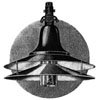
|
z 8504: rochdale
Not recommended for street lighting. Special dispersive lantern designed for use with OSIRA lamsp and combining a dispersive distribution
with a cut-off of light above an angle of 75 degrees above the vertical. The lantern consists of heavy
gauge copper body with upper and lower reflectors or porcelain enamel steel. A clear heat-resisting
glass cylinder with spring suspension fixing protects the lamp against driving rain. The possibility of
lamp failures due to water-drip or condensation is entirely eliminated by the patent top connecting box.
The lantern is wired internally with special heat resisting cables between the connecting box and
the G.E.S. porcelain lampholder.
|
|
Z8504
|
400W MA/V
|
GES
|
Top entry
|
No Gear
|
1935 catalogue
|
|
|
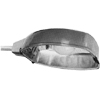
|
|
|
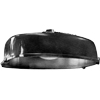
|
|
z 8521
|
|
Z8521
|
250-700W MBF/U
310-600W SON
|
GES
GES
|
Top entry
|
No Gear
|
1969 catalogue
|
|
|
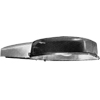
|
|
|
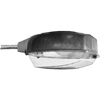
|
|
z 8524
|
|
Z8524
|
250-400W MBF/U
250-400W SON
|
GES
GES
|
Side entry
|
No Gear
|
1981 catalogue
|
|
|
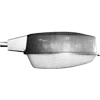
|
|
|

|
|
|
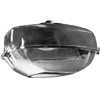
|
|
z 8527
|
|
Z8527
|
250-700W MBF/U
310-600W SON
|
GES
GES
|
Top entry
|
No Gear
|
1969 catalogue
|
|
|
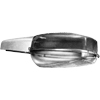
|
|
|

|
|
|
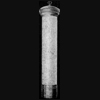
|
|
z 8580: vertical four eighty
|
|
Z8580
|
4x80W MCF
|
8xBC
|
Post Top
|
Gear
|
1953 advert
|
|
|
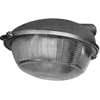
|
|
|
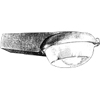
|
|
|
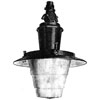
|
z 8700: di-fuser lantern
Totally enclosed dust-proof lantern, specially designed for OSIRA lamps. The body is of heavy guage
copper with porcelain enamel steel inner and outer reflectors. The diffusing bowl is of high quality
low absorption flashed opal white glass. The special shape of the glass is not only decorative, but has been
designed to give a good distribution of candle-power for the general lighting of such areas as traffic
junctions where a diffused light is required. The possibility of lamp failures due to water-drop or condensation is entirely
eliminated by the patent top connecting box.
|
|
Z8700
|
400W MA/V
|
GES
|
Top entry
|
No Gear
|
1935 catalogue
|
|
|
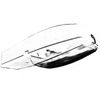
|
|
|
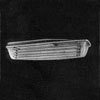
|
z 8905
One of the "Clearside" range for Group B roads.
1" B.S.P. plain side entry die-cast light alloy body. The body carries the tube operating gear
and tube holder supports. The 'Diakon' bowl is hinged to the lantern body and secured by two
stainelss steel toggle catches. The optical system comprises two 'Diakon' refractor plates
cemented one to each inner sideof a 'Diakon' bowl.
|
|
Z8905
|
1x30W MCFA/U
|
2xBC
|
Side Entry
|
Gear
|
1960s catalogue
|
|
Z8906
|
2x30W MCFA/U
|
4xBC
|
Side Entry
|
Gear
|
1960s catalogue
|
|
Z8907
|
3x30W MCFA/U
|
6xBC
|
Side Entry
|
Gear
|
1960s catalogue
|
|
|
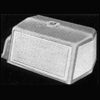
|
|
z 9420/30: small sodium lantern for side streets
British Patent: 519484.
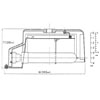
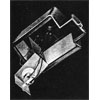
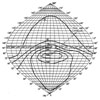 Introduced in 1946. For Group B roads. Side road lighting; mounting height 13 ft. - 15 ft.; spacing 100 ft. - 120 ft. Greater spacing will produce dark areas between lanterns. Road
width up to 30 ft. This lantern employs either 45 or 60-watt OSIRA sodium lamps. Top entry. The lantern entry is ¾ in. gas. It is supplied with a lock-nut.
The body is a single light alloy die-casting, and carries cemented into windows in the sides
of the lantern, two refractor plates 10-in. by 5-in. long, with sealed internal prisms.
The front of the lantern is glazed with flash opal glass. An earthing screw is provided. The lampholder and lamp steady
are carried on an over reflector, which hinges downwards for easy wiring.
Prismatic glass refractor plates are cemented into the windows at the sides of the lantern. These plates are normally supplied with
plain cover glasses which seal the prisms so that all external glass surfaces are smooth. The refractors can be supplied without cover glasses but
the small saving in cost effected is likely to be more than offset by the extra maintenance required. The front window is fitted with a curved
panel of white flashed opal glass and allows light to fall across the road. Immediately above the lamp is a white enamelled reflector. This is hinged.
When allowed to drop down it gives access to the lampholder wiring. The lampholder and lamp steady are carried on an over reflector which hinges
downward to facilitate wiring. The light alloy is
specially selected for its resistance to corrosion. Further protection is obtained by the use of a suitable
primer, undercoat and matt aluminium finish top coat.
Introduced in 1946. For Group B roads. Side road lighting; mounting height 13 ft. - 15 ft.; spacing 100 ft. - 120 ft. Greater spacing will produce dark areas between lanterns. Road
width up to 30 ft. This lantern employs either 45 or 60-watt OSIRA sodium lamps. Top entry. The lantern entry is ¾ in. gas. It is supplied with a lock-nut.
The body is a single light alloy die-casting, and carries cemented into windows in the sides
of the lantern, two refractor plates 10-in. by 5-in. long, with sealed internal prisms.
The front of the lantern is glazed with flash opal glass. An earthing screw is provided. The lampholder and lamp steady
are carried on an over reflector, which hinges downwards for easy wiring.
Prismatic glass refractor plates are cemented into the windows at the sides of the lantern. These plates are normally supplied with
plain cover glasses which seal the prisms so that all external glass surfaces are smooth. The refractors can be supplied without cover glasses but
the small saving in cost effected is likely to be more than offset by the extra maintenance required. The front window is fitted with a curved
panel of white flashed opal glass and allows light to fall across the road. Immediately above the lamp is a white enamelled reflector. This is hinged.
When allowed to drop down it gives access to the lampholder wiring. The lampholder and lamp steady are carried on an over reflector which hinges
downward to facilitate wiring. The light alloy is
specially selected for its resistance to corrosion. Further protection is obtained by the use of a suitable
primer, undercoat and matt aluminium finish top coat.
|
|
Z9420
|
45-60W SO/H
|
BC
|
Top Entry
|
No Gear
|
1946 program
1947 book
1947 advert
1947 paper
1947 advert
1948 catalogue
1948 catalogue
1951 book
|
|
Z9430
|
45-60W SO/H
|
BC
|
Top Entry
|
No Gear
|
1946 program
1947 book
1951 book
|
|
|
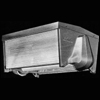
|
|
z: 9425/35: refractor plate lantern / open refractor plate lantern / main road lantern for sodium lamps
British Patents: 507688 and 519484.
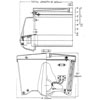
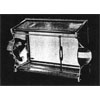
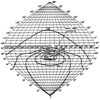 Refractor: Z6313
Refractor: Z6313
Introduced in 1945. For Group A roads. Has a light die-cast body. The optical system consists of a single piece refractor plate
on each side, each having a clear cover glass sealed to the prismatic side of
the plate, both surfaces being smooth, thereby facilitating cleaning, and clamped
between die-cast aluminium end plates. Arranged for top suspension, tapped 1¼in. gas and is
supplied with a lock-nut.
Main road lighting; mounting height 25 ft.; spacing 120-150 ft.; raod width 30-40 ft. For roads over 40 ft.
in width, this lantern, with its horizontally burning lamp, will give better results than are obtainable from a lantern
with a vertical burning light source. Made from a die-cast light alloy. The body consists of three castings with are two end pieces and a sloped top. Two
longitudinal mild steel rods of rust-proof finish hold the lantern rigidly together. A lamp steady slides
on these rods and can be adjusted to suit the length of lamp in use. An earthing screw is provided.
The lampholder position is fixed. It is wired with heat-resisting wire to a terminal block mounted
on the end of the lantern.
The optical system consists of two Z.6313 G.E.C. prismatic refractor plates. They are supported by small
detachable lugs on end castings, this arrangement allowing the refractor plate to be quickly removed if required.
Each plate has its refracting prisms sealed by a palin cover glass, thus ensuring that all exposed glass
surfaces are smooth. A small saving in cost can be effected by the omission of the cover glasses but this will
usually necessitate more frequently cleaning of the refractor plates. Immediately above the lamp is a white
enamelled inner over-reflector. This can be easily removed when the lantern is to be wired.
The light alloy used is specially
selected for its resistance to corrosion. Further protection is obtained by the use of a suitable primer,
undercoat and matt aluminium finish top coat.
|
|
Z9425
|
85-140W SO/H
|
BC
|
Top Entry
|
No Gear
|
1945 programme
1946 programme
1947 advert
1947 book
1947 advert
1948 catalogue
1948 catalogue
1951 book
|
|
Z9435
|
85-140W SO/H
|
BC
|
Top Entry
|
No Gear
|
1948 catalogue
|
|
|
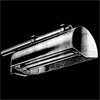
|
|
z: 9443: cut-off lantern for large sodium lamps
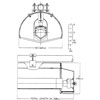
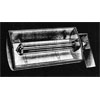
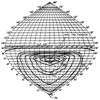 For Main road lighting, roundabouts, roads in the vicinity of airfields, dock and waterside lighting. This
lantern has a cut-off distribution and no light is emitted above the horizontal. The peak candle power is at about 70° to the
vertical and above this angle the intensities fall off very rapidly, therefore lanterns should be mounted at 25 ft. and spaced
not more than 95-100 ft. apart. Best results are generally obtained by using some form of central suspension, provided that
the road width does not exceed about 45 ft. These characteristics make the lantern suitable for waterside lighting where, for
navigational purposes, it is generally necessary for lights to be shielded. It has also been found that cut-off lighting gives
the best visibility at roundabouts where normally the number of lanterns that can be seen may cause confusion.
For Main road lighting, roundabouts, roads in the vicinity of airfields, dock and waterside lighting. This
lantern has a cut-off distribution and no light is emitted above the horizontal. The peak candle power is at about 70° to the
vertical and above this angle the intensities fall off very rapidly, therefore lanterns should be mounted at 25 ft. and spaced
not more than 95-100 ft. apart. Best results are generally obtained by using some form of central suspension, provided that
the road width does not exceed about 45 ft. These characteristics make the lantern suitable for waterside lighting where, for
navigational purposes, it is generally necessary for lights to be shielded. It has also been found that cut-off lighting gives
the best visibility at roundabouts where normally the number of lanterns that can be seen may cause confusion.
It is mounted by two clamps on the lantern roof which secure it to the horizontal bracket arm which must be a minimum length of
14 in. Bracket tubing of ¾ in. - 1½ in. gas, unthreaded, can be used. Has a porcelain B.C. lampholder which is
housed in a separate compartment with a sliding cover underneath; an earthing screw is provided.
The body is of copper with a cable entry elbow on the lampholder compartment. The lamp steady provided is suitable for both
the 85W or 140W lamp. The steady is reversible allowing for either lamp. A stainless steel spring is provided to ensure that the
lamp is held firmly in the steady. The holder is mounted on a sliding platform. This enables the angle of cut-off, and therefore
the angle of peak candle-power, to be varied. The correct positions for these different angles is marked. Two curved glass mirrors are
fixed inside the body, to provide the main light control. There are also flat mirrors on the inside of each of the lantern ends.
All mirrors are copper and lead-backed and secured by clips.
The lantern is finished a matt aluminium stove enamel externally and white enamel internally.
|
|
Z9443
|
85-140W SO/H
|
BC
|
Top Clamp
|
No Gear
|
1948 catalogue
|
|
|
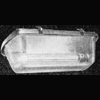
|
|
|
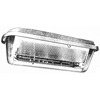
|
z 9454
One of the "Clearmain" range for Group A roads. 1¼in. B.S.P. plain side entry or 1¼in. B.S.P. tapped top
entry light alloy die-casting
carrying the lamp steady, lampholder and porcelain terminal block. The Z 9464/5 lantern carries the lamp operating gear in the
lantern body. The bowl is hinged to the lantern body and secured by a stainless steel spring catch. The optical system has
a medium angle beam distribution. It comprises two injection moulded 'Diakon' refractor plates cemented
one to each inner side of a 'Diakon' bowl.
|
|
Z9454
|
140W SO/H
140 SOI/H
90W SOX
|
BC
|
Side Entry
|
No Gear
|
1960s catalogue
1961 catalogue
1970s catalogue
1979 catalogue
|
|
Z9455
|
140W SO/H
140 SOI/H
90W SOX
|
BC
|
Top Entry
|
No Gear
|
1960s catalogue
1961 catalogue
|
|
Z9464
|
140W SO/H
140W SOI/H
90W SOX
|
BC
|
Side Entry
|
Gear
|
1960s catalogue
1961 catalogue
1970s catalogue
1979 catalogue
|
|
Z9465
|
140W SO/H
140W SOI/H
90W SOX
|
BC
|
Top Entry
|
Gear
|
1960s catalogue
1961 catalogue
1979 catalogue
|
|
|
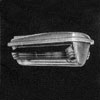
|
z 9454a
One of the "Clearmain" range for Group A roads. 1¼in. B.S.P. plain side entry or 1¼in. B.S.P. tapped top entry light alloy die-casting
carrying the lamp steady, lampholder and porcelain terminal block. The Z 9464/5 'A' lantern carries the lamp operating gear in the
lantern body. The bowl is hinged to the lantern body and secured by a stainless steel spring catch. The lantern is intended
for main road lighting in the vicinity of airfields and falls within the specification issued by the Ministry of Transport.
The optical system has an
aeroscreened distribution. Two injection moulded 'Diakon' refractor plates are cemented one
to each inner side of a 'Diakon' bowl. Screening from the air is achieved by a moulded 'Perspex' box containing louvres cemented
to each side of the bowl over the refractor plates.
|
|
Z9454A
|
140W SO/H
140 SOI/H
|
BC
|
Side Entry
|
No Gear
|
1960s catalogue
|
|
Z9455A
|
140W SO/H
140 SOI/H
|
BC
|
Top Entry
|
No Gear
|
1960s catalogue
|
|
Z9464A
|
140W SO/H
140W SOI/H
|
BC
|
Side Entry
|
Gear
|
1960s catalogue
|
|
Z9465A
|
140W SO/H
140W SOI/H
|
BC
|
Top Entry
|
Gear
|
1960s catalogue
|
|
|
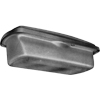
|
z 9454c
One of the "Clearmain" range for Group A roads. 1¼in. B.S.P. plain side entry or 1¼in. B.S.P. tapped top entry light alloy die-casting
carrying the lamp steady, lampholder and porcelain terminal block. The Z 9464/5 'C' lantern carries the lamp operating gear in the
lantern body. The bowl is hinged to the lantern body and secured by a stainless steel spring catch. The optical system is
a cut-off distribution. Two anodised aluminium mirrors fixed one to each inner side of a 'Perspex' bowl.
|
|
Z9454C
|
140W SO/H
140W SOI/H
|
BC
BC
|
Side Entry
|
No Gear
|
1960s catalogue
1964 catalogue
|
|
Z9455C
|
140W SO/H
140W SOI/H
|
BC
BC
|
Top Entry
|
No Gear
|
1960s catalogue
1964 catalogue
|
|
Z9464C
|
140W SO/H
140W SOI/H
|
BC
BC
|
Side Entry
|
Gear
|
1960s catalogue
1964 catalogue
|
|
Z9465C
|
140W SO/H
140W SOI/H
|
BC
BC
|
Top Entry
|
Gear
|
1960s catalogue
1964 catalogue
|
|
|
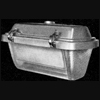
|
|
|
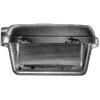
|
|
|
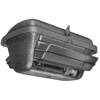
|
z 9480a
One of the "Clearside" range for Group B roads. 1" B.S.P. plain side entry or ¾" B.S.P. tapped top entry die-cast light
alloy body. The Z9490/1 'A' lanterns carry the lamp operating gear within the body. The
bowl is hinged to the body and secured by stainless steel spring catch. The lantern is intended
for side road lighting in the vicinity of airfields. It has an aeroscreen distribution.
Two 'Diakon' injection moulded
refractor plates cemented one to each inner side of a 'Diakon' bowl. Screening from the air is
achieved by a moulded 'Perspex' box containing louvres being cemented on each side of the bowl
over the refractor plates.
|
|
Z9480A
|
45W-60W SO/H
45W-60W SOI/H
|
BC
|
Side Entry
|
No Gear
|
1960s catalogue
1961 catalogue
|
|
Z9481A
|
45W-60W SO/H
45W-60W SOI/H
|
BC
|
Top Entry
|
No Gear
|
1960s catalogue
1961 catalogue
|
|
Z9490A
|
45W-60W SO/H
45W-60W SOI/H
|
BC
|
Side Entry
|
Gear
|
1960s catalogue
1961 catalogue
|
|
Z9491A
|
45W-60W SO/H
45W-60W SOI/H
|
BC
|
Top Entry
|
Gear
|
1960s catalogue
1961 catalogue
|
|
|
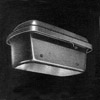
|
z 9480c
One of the "Clearside" range for Group B roads. 1" B.S.P. plain side entry or ¾" B.S.P.
tapped top entry die-cast light alloy body. The Z9490/1 lanterns carry the lamp operating gear
within the body. The bowl is hinged to the body and secured by stainless steel spring catch.
It has a cut-off distribution. It comprises two-anodised aluminium refractors fixed
one to each inner side of a 'Perspex' bowl.
|
|
Z9480C
|
45W-60W SO/H
45W-60W SOI/H
|
BC
|
Side Entry
|
No Gear
|
1960s catalogue
|
|
Z9481C
|
45W-60W SO/H
45W-60W SOI/H
|
BC
|
Top Entry
|
No Gear
|
1960s catalogue
|
|
Z9490C
|
45W-60W SO/H
45W-60W SOI/H
|
BC
|
Side Entry
|
Gear
|
1960s catalogue
|
|
Z9491C
|
45W-60W SO/H
45W-60W SOI/H
|
BC
|
Top Entry
|
Gear
|
1960s catalogue
|
|
|
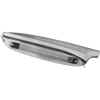
|
z 9494
One of the "Clearside" range for Group B roads. 1" B.S.P. plain side entry die-cast light alloy
body. The 'Perspex' enclosing bowl is hinged to the body with a removable stainless steel hinge pin.
The bowl is secured by a stainless steel latch. The optical system comprises
two 'Perspex' refractor plates cemented one to each inner side of a 'Perspex' bowl.
|
|
Z9484
|
???
|
???
|
???
|
???
|
1970s catalogue
|
|
Z9486
|
???
|
???
|
???
|
???
|
1970s catalogue
|
|
Z9494
|
60W SLI/H
|
2xBC
|
Side Entry
|
Starting relay
|
1960s catalogue
1965 catalogue
1970s catalogue
|
|
Z9495
|
60W SLI/H
|
2xBC
|
Side Entry
|
No Gear
|
1960s catalogue
1965 catalogue
|
|
|
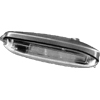
|
|
|
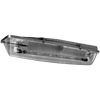
|
z 9504
One of the "Clearmain" range for Group A roads. 1¼ in. B.S.P. plain side entry die-cast light alloy body. The inner surface of the
body is white enamelled and carries the lampholders, thermal relay and porcelain terminal block. The Z 9506 lantern
carries the lamp operating gear in the lantern body on a removable gear tray. The 'Diakon' bowl is
hinged to the lantern body and secured by two stainless steel toggle catches. The optical system has
a medium angle beam distribution and comprises two injection moulded Diakon refractor
plates cemented one to each inner side of a 'Diakon' bowl.
|
|
Z9504
|
200W SLI/H
|
2xBC
|
Side Entry
|
Starting relay
|
1960s catalogue
1965 catalogue
|
|
Z9506
|
200W SLI/H
|
2xBC
|
Side Entry
|
Gear
|
1960s catalogue
1965 catalogue
|
|
|
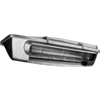
|
z 9504a
One of the "Clearmain" range for Group A roads. 1¼ in. B.S.P. plain side entry die-cast light alloy body. The inner surface of the
body is white enamelled and carries the lampholders, thermal relay and porcelain terminal block. The Z 9506 'A' lantern
carries the lamp operating gear in the lantern body on a removable gear tray. The 'Diakon' bowl is
hinged to the lantern body and secured by two stainless steel toggle catches. The lantern is intended for main road
lighting in the vicinity of airfields and falls within the specification issued by the Ministry of Transport.
Has an aeroscreened distribution. Two injection moulded 'Diakon' refractor plates
are cemented one to each inner side of a 'Diakon' bowl. Screening from the air achieved by a moulded
'Perspex' box containing louvres cemented to each side of the bowl over the refractor plates.
|
|
Z9504A
|
200W SLI/H
|
2xBC
|
Side Entry
|
Starting relay
|
1960s catalogue
1965 catalogue
|
|
Z9506A
|
200W SLI/H
|
2xBC
|
Side Entry
|
Gear
|
1960s catalogue
1965 catalogue
|
|
|
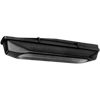
|
z 9504c
One of the "Clearmain" range for Group A roads. 1¼ in. B.S.P. plain side entry die-cast light alloy body. The inner surface of the
body is white enamelled and carries the lampholders, thermal relay and porcelain terminal block. The Z 9506 'C' lantern
carries the lamp operating gear in the lantern body on a removable gear tray. The 'Perspex' bowl is hinged to the lantern
body and secured by two stainless steel toggle catches. Has a cut-off distribution. Two anodised aluminium mirrors fixed
on to each inner side of a 'Perspex' bowl.
|
|
Z9504C
|
200W SLI/H
|
2xBC
|
Side Entry
|
Starting relay
|
1960s catalogue
1965 catalogue
|
|
Z9506C
|
200W SLI/H
|
2xBC
|
Side Entry
|
Gear
|
1960s catalogue
1965 catalogue
|
|
|
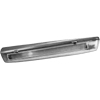
|
|
|
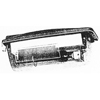
|
|
|
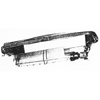
|
|
|
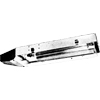
|
|
|
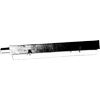
|
|
|
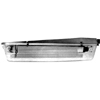
|
|
|
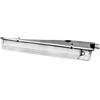
|
|
|
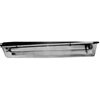
|
|
|
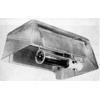
|
|
|
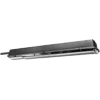
|
|
|
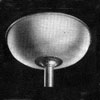
|
zd 574 | clearspace zd 574
One of the "Clearspace" range. The lantern is circular, about 4' 6" diam, and built around a central tube. Top of tube carries
a casting supporting top aluminium spinning. Enclosing bowl made in Opal 'Perspex'. Bowl lowers supported on flexible
cables and counterweight. Also available 3' 9" diam. without counterweight (Cat. No. ZD 10517).
The opal 'Perspex' bowl provides a diffusive symmetric light distribution.
|
|
ZD574
|
3 x 250-400W MBF/U
|
3 x GES
|
Post Top
|
No Gear
|
1960s catalogue
|
|
ZD10517
|
3 x 250-400W MBF/U
|
3 x GES
|
Post Top
|
No Gear
|
1960s catalogue
|
|
|
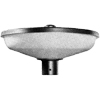
|
|
|
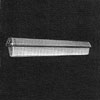
|
zd 855
One of the "Clearspace" range. Lantern body consists of two die-cast light alloy end pieces built on
to an aluminium alloy extrusion. Fixings are provided with conduit or trunking suspension. All operating
auxiliaries are mounted within the body. The 'Perspex' bowl is held to the lantern body by
stainless steel toggled clips. Chains support the bowl when it has been lowered. An alternative
version of the lantern is available for 4 ft. tubes. The optical system is a
'Perspex' enclosing bowl. The design incorporates a system
of louvres giving a cut-off in the horizontal plane.
|
|
ZD855
|
1x80W MCFA/U
2x80W MCFA/U
|
Bi-pinx2
Bi-pinx4
|
Conduit or
Trunking
|
Gear
|
1960s catalogue
|
|
|
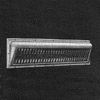
|
zd 1011
One of the "Clearspace" range. The lantern is intended for recessed wall mounting. The recessed portion of the
lantern body consists of an extruded aluminium framework covered with aluminium sheet. The
cast aluminium front cover carried the louvres and is glazed with clear 'Perspex'. The operating gear
is housed within the body on a removable tray. Anodised aluminium reflector incorporating radial adjustment.
Vertical louvres give a 27° cut-off in the horizontal plane.
|
|
ZD1011
|
1x80W MCFA/U
|
Bi-pinx2
|
Various
|
Gear
|
1960s catalogue
|
|
|
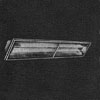
|
zd 1071
One of the "Clearspace" range. The lantern body consists of an extruded aluminium framework covered with
aluminium sheet. All operating gear is housed in the lantern body. The hinged door is glazed with
broad reeded glass and secured by stainless steel toggle catches. The lantern body has two strengthened mounting
points to receive various types of mounting bracket. The optical system is
an anodised aluminium reflector.
|
|
ZD1071
|
1x80W MCFA/U
2x80W MCFA/U
|
Bi-pinx2
Bi-pinx4
|
Various
|
Gear
|
1960s catalogue
|
|
|
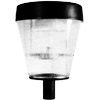
|
|
zd 1171a
|
|
ZD1171A
|
100-200W GLS
80-125W MBF/U
|
BC
3BC
|
Post Top/Top Entry
|
No Gear
|
1974 catalogue
|
|
|
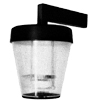
|
|
zd 1172a
|
|
ZD1172A
|
100-200W GLS
80-125W MBF/U
|
BC
3BC
|
Post Top/Top Entry
|
No Gear
|
1974 catalogue
|
|
|
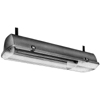
|
|
|

|
|
|
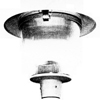
|
|
|
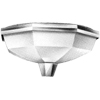
|
zd 10547
One of the "Clearside" range for Group A roads. The lantern is octagonal, about 3' 9" across the flats. Built around a
central tube which carries an octagonal casting supporting the top spinning. Enclosing octagonal bowl
made in Opal 'Perspex'. The opal 'Perspex' octagonal bowl provides a diffusive
symmetric light distribution.
|
|
ZD10547
|
3x250-400W MBF/U
3x310-400W SON
|
3 x ES
3 x ES
|
Post Top
|
No Gear
|
1960s catalogue
1974 catalogue
|
|
|
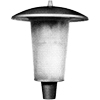
|
|
zd 10598
|
|
ZD10598
|
100-200W GLS
80-125W MBF/U
35-55W SOX
|
BC
3BC
BC
|
Post Top
|
No Gear
|
1974 catalogue
|
|
|
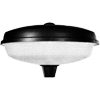
|
|
zd 10606
|
|
ZD10606
|
250-400W MBF/U
90W SOX
310-400W SON
|
ES
BC
ES
|
Post Top
|
No Gear
|
1974 catalogue
|
|
|
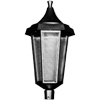
|
|
zd 10807
|
|
ZD10807
|
100-200W GLS
80-250W MBF/U
35-55W SOX
250W SON
|
BC
3BC
BC
ES
|
Post Top
|
No Gear
|
1974 catalogue
|
|
|
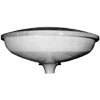
|
|
|
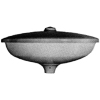
|
|
zd 10841
|
|
ZD10841
|
250-400W MBF/U
310-400W SON
|
ES
ES
|
Post Top
|
No Gear
|
1974 catalogue
|
|
|
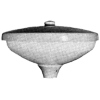
|
|
zd 10864
|
|
ZD10864
|
80-125W MBF/U
35W SOX
|
3BC
BC
|
Post Top
|
No Gear
|
1974 catalogue
|
|
|
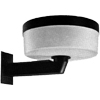
|
|
zd 10877
|
|
ZD10877
|
100-200W GLS
80-125W MBF/U
|
BC
3BC
|
Post Top
|
No Gear
|
1974 catalogue
|
|
ZD10890
|
100-200W GLS
80-125W MBF/U
|
BC
3BC
|
Post Top
|
No Gear
|
1974 catalogue
|
|



